3 Volumes
Tourist Trips: Philadelphia and the Quaker Colonies
The states of Pennsylvania, Delaware, and New Jersey all belonged to William Penn the Quaker in one way or another. New Jersey was first, Delaware the last. Penn was the largest private landholder in American history.
Revolutionary War Era
The shot heard 'round the world.
Regional Overview: The Sights of the City, Loosely Defined
Philadelphia,defined here as the Quaker region of three formerly Quaker states, contains an astonishing number of interesting places to visit. Three centuries of history leave their marks everywhere. Begin by understanding that William Penn was the largest private landholder in history, and he owned all of it.
Montgomery and Bucks Counties
The Philadelphia metropolitan region has five Pennsylvania counties, four New Jersey counties, one northern county in the state of Delaware. Here are the four Pennsylvania suburban ones.
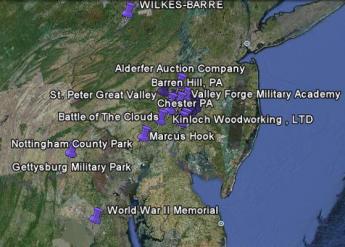 The Philadelphia metropolitan region.
The Philadelphia metropolitan region.
A Woman's Work

|
| Feminism |
Whatever the gains and losses of the Industrial Revolution, reproductive need endures. Feminists who proclaim the advice to their sisters, "Have a baby; just don't have two." ignore some pretty simple arithmetic about population growth. What's perhaps worse, they fail to notice conflict with the goal of marrying rich. Rich men can afford a lot of things, but most of them can't afford a working wife. There's a fantasy in soap opera about meeting a fabulously rich man, one who owns motorboats and horses. How glamorous to be swept up by such a paragon; after all, every American hope to get rich.
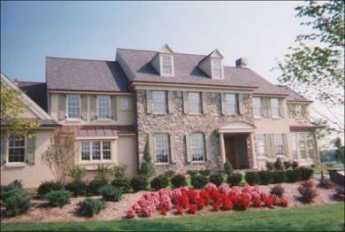
|
| Big House |
, In fact, it takes training to run a big house, organize big parties, cope with artisans and servants, facilitate the complicated diplomacy of business and political affairs. A rich man expects his wife to run a big establishment, facilitate a complicated social life with those horses, sailboats and extensive travel. And she better maintains her personal glamor, too, because there are lots of younger women who toy with the idea of grabbing him in a weak moment. So even a fun time at the dress shops and hairdressers is obligatory. A man in an exalted position can't afford to have a wife who is employed in some dumb profession; the money she earns is a nuisance.
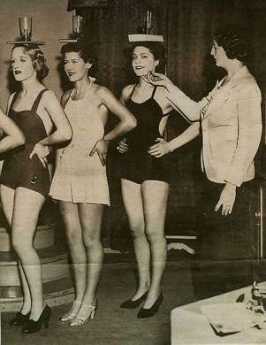
|
| Finishing School |
So that brings us to colleges and Quakers. A handful of elite women's colleges once tried to accommodate the finishing school with career preparation for blue-stocking women. The student could choose which path to follow but until recently finishing school was predominant, and comparatively few chose to be spinsters. Bryn Mawr College quickly grew to be the most prestigious college in the Philadelphia area, since both the finishing school and the bluestocking career had the needs of the upper class in mind. Quakers don't admit to an upper class but look at their colleges. Haverford was for Quaker males, Bryn Mawr for Quaker women, and Swarthmore for Quakers who fancied co-education. It was a nice arrangement, with Quaker students almost always in the minority, the rest either upper-class (read Katherine Hepburn) or brilliant scholarship students. Bryn Mawr was a little sniffy about the farm-boys at Haverford and the engineering nerds at Swarthmore. Much of that was an adolescent pose, but it created quite a rearrangement when Haverford went co-ed.
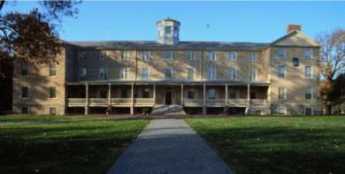
|
| Haverford College |
Almost overnight, women college applicants declared a preference for going to Haverford if there was a choice. Within a few years, Haverford students became 57% female, and Bryn Mawr suffered a decline in average aptitude scores. Why ever would girls prefer Haverford to Bryn Mawr? Indeed, if Haverford was headed in the direction of an all-female student body, Bryn Mawr would seem to be the better woman's college to pick. Somewhere buried in this adolescent stampede is probably some television-inspired confusion between the life of a suburban housewife and the life of a rich man's wife, but there certainly is a big difference in attitude about two-career families. On the other hand, there are lots more opportunities for the upper middle class than the lower upper class, both in the number of available mates and in the fall-back opportunity to try to make it as a career woman. Rich men are no longer invariably upper class, nudged by their chums to be wary of career girls. Anyway, college freshmen are pretty malleable; Haverford is a little safer bet if you aren't entirely sure of yourself.
Germantown Avenue, One End to the Other

|
| Germantown Map |
Chestnut Hill really is a big hill poking up in the middle of Philadelphia, and Germantown Avenue follows an old Indian trail from the Delaware River right up to that hill. The waterfront area of the city has been built and rebuilt to the point where it's now a little hard to say just where Germantown Avenue begins. From a map viewpoint, you might look for a four-way intersection of Frankford Avenue, Delaware Avenue, and Germantown Avenue, underneath the elevated interstate highway of I-95. The present state of demolition and rubble heaps suggests that a Casino might be built there sometime soon, politics and the Mafia permitting.
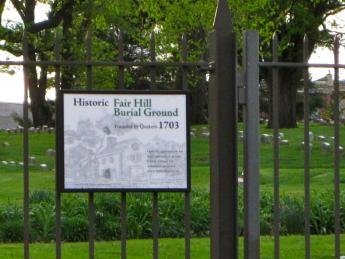
|
| Fair Hill Cemetery |
Although Germantown Avenue has wandered northwestward from this uncertain beginning for over 300 years, up to the rising slope of the town toward Broad Street, it is now rather difficult to make out anything but industrial slum along its path which could be called historic. There is hardly any structure standing which has a colonial shape, and no Flemish bond brickwork is seen in the tumble-down buildings. When with the relief you finally approach Temple University Medical Center at Broad Street, the Fair Hill cemetery does show some effort at preservation, and a sign says that Lucretia Mott is buried there. But that's about all you could photograph without provoking suspicious stares. Here's the first of four segments of Germantown Ave., and it's a pretty sorry sight.
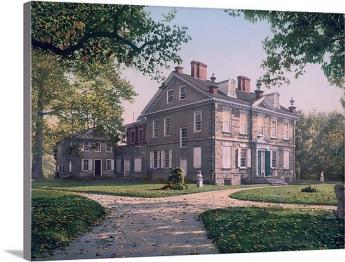
|
| Chew Mansion |
Crossing Broad Street, the busy intersection suggests 19th Century prosperity in its past, and on the west side of Broad, you can start to see signs of historic houses, either in colonial brickwork or grey fieldstone. The road gets steeper as you go west past Mt. Airy, where it almost brings tears to the eyes to see brave remnants of another time. George Washington lived here for a while, and the Wisters, Allens, and Chews; Grumblethorp and Wyck. The huge stone pile of the Chew Mansion glares at the imposing Upsala mansion, where British and Americans lobbed artillery at each other during the Battle of Germantown. Benjamin Chew the Chief Justice built this house as a summer retreat, to get away from Yellow Fever and such, and started the first migration to the leafy suburbs. His main house was on 3rd Street in Society Hill, next to the Powels and where George Washington stayed. At the peak of the hill in Chestnut Hill, a suburb within the city. Germantown Avenue rather abruptly goes from the relics of Germantown to the charming elegance of Chestnut Hill, but during a recession, it frays a little even there. At the very top is the mansion of the Stroud family, now in the hands of non-profits; across the road in Chestnut Hill Hospital, once the domain of the Vaux family. Then down the hill to Whitemarsh, where the British once tried to make a surprise raid on Washington's army. As you cross the county line into Montgomery County, it's conventional to start calling the Avenue, Germantown Pike. Germantown Pike was in fact created in 1687 by the Provincial government as a cart road from Philadelphia to Plymouth Meeting. Farmers used to pay off their taxes by laboring on the dirt road, at 80 cents a day. Germantown Pike, Ridge Pike, Skippack Pike, Lancaster Pike, and others are a local reminder that Pennsylvania was always the center of turnpike popularity; that's how we thought roads should be paid for. The present governor (Rendell) hopes to sell off some better-paying turnpikes to the Arabs and Orientals, possibly imitating Rockefeller Center by buying them back and reselling them several times by outguessing the business cycle. Parenthetically, the Finance Director of another state at a cocktail party recently snarled that the purpose of privatizing state infrastructure was not to raise revenue, but to provide collateral for more state borrowing. He wasn't at a tea party, but he may soon find himself there.
From a modern perspective, the third segment of the Germantown road runs from Chestnut Hill to Plymouth Meeting, with lovely farmhouses getting swallowed up by intervening, possibly intrusive, exurbia. The township of Plymouth Meeting is a hundred years older than Montgomery County, having been built to be near a natural ford in the Schuylkill River. Norristown, a little downstream, is the first fordable point on the Schuylkill, with Pottstown making a third. Plymouth's colonial character survived a period of industrialization based on local iron and limestone, and has established several prominent schools for the surrounding area. But the construction of a substantial highway bridge attracted a large and busy shopping center. The shopping center looks as though it will eradicate the quaint historical atmosphere more effectively than industrialization ever could.
The fourth and final segment of Germantown Pike starts at the Schuylkill and goes over rolling countryside to its final destination at Perkiomenville, where it joins Ridge Pike at the edge of the Perkiomen Creek. That's an Indian name, originally Pahkehoma. Perkiomenville Tavern claims to be the oldest inn in America, although that honor is contested by another one along the Hudson River near Hyde Park. The WPA during the Great Depression constructed a large park along the Perkiomen Creek for several thousand acres of camping and fishing, so Perkiomenville has several large roadhouse restaurants and antique auctions for bored wives of the fishermen. In the V where Ridge Pike and Germantown Pike come together, a dozen or more colonial houses are tucked away in a town called Evansburg. This formerly Mennonite terminus of Germantown Pike obviously still has a lot of charm potential, and its local inhabitants are very proud of the place. But it's easy to zip past without noticing the area, which includes an 8-arch stone bridge, said shyly to be the oldest in the country. It's hard to know whether you wish more people would visit and appreciate; or whether you are happy that obscurity might permit it to survive another century or so.
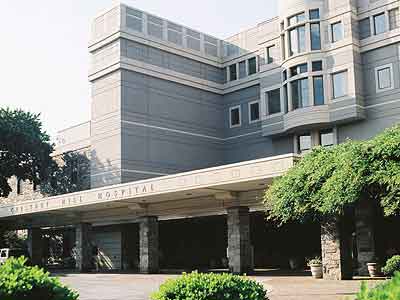
|
| Chestnut Hill Hospital |
The name change of the Germantown road from Avenue to Pike is probably not precisely where the turnpike began, but it is now notable for some pretty imposing mansions, standing between the humble and even somewhat dangerous slums along Delaware, and the charmingly humble but well-preserved Mennonite villages, at the other end. It is arresting to consider the two ends, whose houses were built at the same time; only the Mennonites endure. Somewhere just beyond the Chestnut Hill mansions is an invisible line. West of that point, when you say you are going to town, you mean Pottstown. When you say you are going to the City, you mean Reading. And as for Philadelphia, well, you went there once or twice when you were young.
The Barnes Foundation: Comments on the Economics of Art (2)
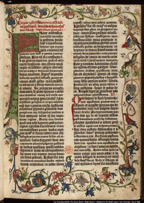
In 1951, Albert C. Barnes' legacy included Jerome's Epistle to Paulinus from the Gutenberg Bible education centered on a notable collection of illustrative artworks, housed in a museum of his own general design for the purpose. He left a multi-million dollar endowment to support his rather detailed and, in the opinion of many, somewhat eccentric intentions. It was his money, however, so his word was final. The institution was fairly mature, having previously been in operation under his direct control for twenty-five years.
Since the Foundation trustees are now before the Orphans Court pleading for permission to modify Dr. Barnes' instructions in order to avoid financial collapse, skepticism is inevitable. Obviously, the successor trustees must explain their expenses. But quite a plausible case can be made that the true cause of this disaster is inherent in the huge windfall growth in value of the paintings. In short, growth in value of the fine art may have outstripped the growth of the resources set aside for maintenance.
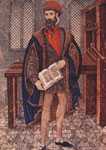
|
| Johann Gutenberg, creator of mass produced books, died in poverty |
Let's make a benchmark of the Gutenberg Bible, where incomplete copies are currently selling for $100,000 a page and complete copies are estimated to be worth $100 million apiece. Dealers maintain the Gutenberg is increasing in value at 20% a year, but growth seems closer to 9% a year if you go back to 1951. What's really relevant here is the growth in cost to ensure, protect, dehumidify, display and make it available to scholars, if not the public. It seems safe to guess these maintenance costs have grown more rapidly than the investment growth of the endowment, which is surely closer to 4% than 20%. The imbalance is even greater if you remember that some investment income is spent every year, while the worth of the fine art just grows and grows. Regardless of the true numbers, if the cost of maintaining the art does grow even slightly faster than the endowment, the dilemma the Barnes is now facing will eventually face any museum. New sources of revenue, either from the government or from public admissions, eventually becomes necessary if the priceless art remains on display. It is displaying these things that cost money; burying them under an Aztec mound or a German salt mine shelters them from the problem. In the case of Alfred Barnes, it is not completely certain that he wanted them displayed.
There is also the issue of quirky fluctuations in the market for fine art. The 22 known perfect copies of Gutenberg, Bibles have been around for almost five hundred years, and it is safe to say their value is enduring. The 180 paintings by Renoir now owned by the Barnes may prove to be Gutenberg Bibles or they may prove to be a passing fad, but it is pretty hard to believe that one of them will always be worth two Gutenbergs. Since there is a pretty fair chance that we are currently seeing a value bubble in French Impressionist painting, it is questionably prudent to shipwreck the whole Barnes Foundation, the School, or Albert C. Barnes basic intent, by resisting the sale of even one of the more overpriced examples in the collection at the top of the market.
That's one side of it. Another consideration is that Barnes himself did considerable merger negotiation with other museums, and may have been unexpectedly killed in an auto accident before he turned over all his cards in that particular poker game. It's asking a lot of the poor judge to overturn the clear and largely unmistakable language of Barnes will in favor of theories about what Barnes was really really thinking when he wrote it. If the judge is feeling adventurous, it's probably more satisfying to all parties if he sets forth a new legal doctrine, reflecting the inevitable disparity between the cost of displaying fine art to the public, and providing a perpetual endowment to do so.
Harriton House
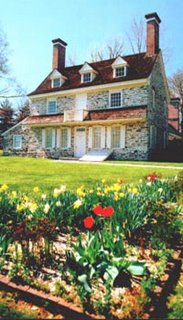
|
| Harriton House |
Three hundred years ago, in 1704, Roland Ellis acquired 700 acres of the Welsh Barony in what is commonly called Philadelphia Main Line and built a palatial house on it. He called his homestead Bryn Mawr, or great hill, after his ancestral home in Wales of the same name, thereby explaining why Bryn Mawr College and Bryn Mawr town have the name but are not notably situated on hills. The town of Bryn Mawr was once called Humphryville. But Bryn Mawr sounded nicer, even though there are plenty of Humphries still around to defend the older designation.
About fifty thousand acres were set aside by William Penn as the Welsh Barony, and there was the willingness to allow it to be self-governing, although that didn't much happens because the inhabitants saw no point in being self-governing. Nevertheless, the term isn't just an ethnic allusion, but has some historic meaning.
In any event, Ellis proved to be an unsuccessful manager of his estate, which rather soon passed into the hands of the Harrison family, who lived on it for about two hundred years until real estate development, and the taxes related thereunto, forced the creation of a complicated arrangement, with the township of Lower Merion owning the property and a non-profit group called the Harriton Association managing it. They have luckily obtained the services of a famous curator, Bruce Gill, who does research, writes papers, and organizes programs for visitors. The neighbors in the area, all living on land that formerly belonged to the Harrisons, are said to constitute the richest neighborhood in America. By building the original farmhouse rather far from the main road (Old Gulph) and remaining surrounded by neighbors who want to have privacy, Harriton House has fewer visitors than it deserves because it is so devilish hard to find.
There was a little local skirmishing during the Revolutionary War, but the main historical significance of the House was that Charles Thomson married a Harrison and lived there all throughout the period of the Revolution and the Articles of Confederation (1774-1789) as the Secretary of the Continental Congress. His little writing desk is, therefore, the most notable piece of furniture at Harriton House since every piece of official paper involved in the whole Revolutionary episode passed through it or over it. Modern organizations would do well to notice that Thomson was not given a vote and was expected to be totally unbiased about Congressional affairs. Even in those days, there must have been cautionary experience with secretaries who tinkered with the minutes for their own preferences. It certainly was entirely fitting that this last steward of the Articles of Confederation was designated to carry the news to George Washington at Mount Vernon, that he had been elected President of the new form of government. No doubt, Washington was pleased but unsurprised to learn of it.
While Harriton House is imposing on the exterior, and was the likely prototype of many characteristic Main Line stone mansions, the inside of the house is quite primitive. In those days it was cheap to build a big house but expensive to heat it. In 1704 surrounded by a continent of a forest, firewood may not have seemed a problem, but it quickly posed a transportation problem, and later houses tended to shrink in size. In any event, the interior of the house seems strangely bleak and bare, quite in keeping with the early Quaker principle of building a structure "without paint, or other adornments". Bruce Gill spent quite a lot of time and effort to determine that the random-width flooring had never received any shellac, varnish or wax. Those are beautiful floors, but the "finish" is just three hundred years of oxidized dirt.
The original Bryn Mawr, now called Harriton House, is well worth a visit. If you can find it; GPS is the modern solution.
La Fayette, We Are Here
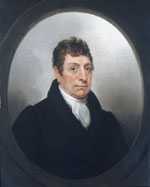 |
| Gilbert du Motier, marquis de La Fayette |
It will be recalled that La Fayette was 19 years old at Valley Forge, spoke no English, had no previous military experience. He nevertheless demanded, and got, a commission as Major General on the prudent condition that he have no troops under his command, at least for a while. Washington had been strongly reminded by various people that this young Frenchman was one of the richest men in France, a personal friend of the Queen, and thus critical to the project of enlisting French assistance in the war. Under the circumstances, it was shrewd to send him on the project of enlisting Indian allies among the Iroquois, since many tribes, particularly the Oneida, spoke French and held their former allies in the French and Indian War in great esteem. The chief of the Oneida Wolf clan (Honyere Tiwahenekarogwen) was visiting General Philip Schuyler in Albany at about the time LaFayette showed up on his mission to get some help for Valley Forge. General Horatio Gates was busy at the time rallying a colonist army to defend against the British under Burgoyne, coming down from Quebec, eventually to collide at the Battle of Saratoga.
Earlier in the war, Honyere's Oneida tribe had tangled with their fellow Iroquois under the leadership of Joseph Brandt (the Dartmouth graduate who was both biblical scholar and commander of several frontier massacres); the Oneida had many new scores to settle with the English-speaking Iroquois tribes. Honyere made the not unreasonable request that before his warriors went off to war, his new American allies would please build a fortification to protect his women and children from Brandt's Mohawks. LaFayette readily put up the money for this project, quickly becoming the Great French Father of the Oneidas. After some scouting and patrolling for Gates, Honyere and about fifty of his braves followed LaFayette to Valley Forge, where they soon made a nuisance of themselves to the Great White Father George Washington. Finally, word of the official French alliance with the colonists reached London, Howe was replaced by Clinton, and the British began to withdraw from their isolated position at Philadelphia.
It was thus that the jubilant rebels at Valley Forge learned that the fortunes of war had turned in their favor, and the French alliance was the source of it. With the British making preparation to abandon Philadelphia, it seemed a safe thing for Washington to give LaFayette command of two thousand troops, including the fifty Oneida Indians, and post them to Barren Hill (now LaFayette Hill), along Ridge Pike near Plymouth Meeting. Washington gave the strictest orders that they were to take no chances with anything, and particularly were to remain mobile, moving camp every day. This was not exactly what the richest man in France was anticipating, and wouldn't make a very saucy story to tell Marie Antoinette about. So, he promptly set about fortifying Barren Hill. Local Tory spies quickly spread this news to General Clinton, who promptly led eight thousand redcoats up the Ridge Pike to capture the bloody Frog. Clinton's plan was good; a detachment went around LaFayette in the woods and came back down Ridge Pike from the other direction, driving the Americans down the Pike into the open arms of the main body of British troops, coming up Ridge Pike. From this point onward, two entirely different stories have been told.
The more widely-held account has LaFayette climbing the steeple of the local church and noticing that there was an escape path, leading down the hill to the Schuylkill River at Matson's Ford. The Indian scouts were sent forward to hold off the British while the troops made their escape. Clinton sent a cavalry charge of Dragoons forward, yelling and waving their sabers, generally making a terrifying spectacle. The Indian scouts, as was their custom, were lying in the brush shoulder to shoulder, and at command by Honyere rose from the ground to let out a resounding chorus of war whoops. The Indians had never seen a cavalry charge, the Dragoons had never heard a war whoop, so both sides fled the battlefield without doing much damage. Meanwhile, LaFayette and his troops escaped to safety on the far side of the Schuylkill.
Other accounts of this episode relate that when Washington heard of it he remarked sourly that either they were pretty lucky, or else the enemy was pretty sluggish. In any event, a few soldiers were killed on both sides, the Americans crossing the River were described as "kegs bobbing on the pond", and it does seem the British army mostly just watched them do it. In the confusion, of course, everyone involved was fearful of being surrounded by unseen troops, and the British may well have worried the whole thing was a trap.
The saddest postscript to the Battle of Barren Hill is the fate of the Indians. After the war was over in 1783, the colonists busied themselves with taking over Indian land. Honyere pitifully petitioned the New York legislature for some consideration of his tribe's wartime service. They ignored him.
Main Line School Night
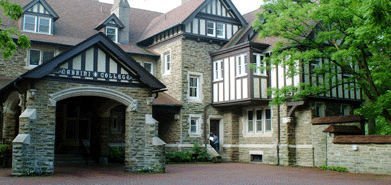
|
| Radnor |
There's a lot to learn from the Main Line School Night, and it isn't all taught in the classroom. The basic idea is life-long learning, going to school because it's fun. The idea started five or six decades ago in the Radnor, PA high school, that a lot of educated people wanted to become still more educated in topics of their own selection. No tests, please, and forget about academic credits; most of the students already have an excess of them. Forget about improving your income with advanced degrees; since this is Main Line Philadelphia, quite a few of the students already have all the income they could ever want. As related by the very low-key president of MLSN, David Hastings, the idea was an almost instant success. There were 1200 students enrolled for the second semester. They outgrew the original high school, and now teach courses in seven schools among 40 locations, to 14,000 students a year. There are 400 teachers in any given year, and the tuition charged is aimed at breaking even on the overhead. The academic world is inclined to say the courses lack rigor, by which is partly meant that if the students don't like the course, they walk out. Volleyball, yoga, and nutrition certainly do have a California sound, but computers, foreign languages, and science can be as difficult as you want to make them. If you get serious about contract bridge, you soon learn that isn't a simple child's game. Courses in wine tasting are given in the local senior citizens' retirement communities, but mostly not to the residents. It's not welcome to give that sort of course in a high school. To some extent, this continuing education is an exclusive social occasion, but then so is a course in diplomatic history at Princeton. Mr. Hastings tells of a group of sixteen ladies in a bridge course who have been coming for years, and have learned to close the course rolls by all sending in their checks on the day of registration. This is, after all, the Main Line where exclusionary techniques once learned are hard to forget. There are clouds on the horizon. In the past three years, enrollment has leveled off and declined a little. Almost no major corporation continues to be successful for more than seventy-five years, and many of the people running Main Line School Night are drawn from the Executive Service Corps. In retrospect, for example, the owners and editors of the Saturday Evening Post should have sold out and closed down, as soon as they learned the first million television sets had been sold. Perhaps the decline of enrollment of Main Line School Night reflects the advent of the Internet, or the cell phone, or some other new technological competitor. Or maybe the venture just got too big and successful to maintain its original format; perhaps it's outgrowing its blood supply. But anyway, they have 14,000 students and can be proud to be in a resting phase, when the rest of the city, or state, or country, hasn't even tried to get started on such a project.
Bertrand Russell Disturbs the Barnes Foundation Neighbors
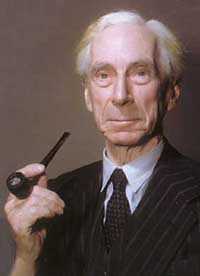
|
| Russell |
In 1940, the Barnes Foundation disturbed its Philadelphia's Main Line neighborhood in a way that had nothing to do with art. Dr. Barnes was still alive and running the place at that time so there can be no question about the testamentary intentions of the donor. He hired Bertrand Russell for a five-year contract to teach philosophy at the Foundation, under highly lurid circumstances. By doing so, he put his thumb in the eye of religions generally but especially the Roman Catholic Church, into the eye of the Main Line neighborhood that prized its privacy, and into the eye of the judiciary, although the judiciary found a way to get back at him.
 Do not fear to be eccentric in opinion, for every opinion now accepted was once eccentric. 
|
| Bertrand Russell |
Under the circumstances, hiring anyone at all would have been socially defiant, but Barnes went out of his way to offer a position to a man who was already internationally famous for sticking his own thumb in everybody's eye.
Lord Bertrand Russell was the third Earl, the son of a Viscount and the grandson of a British prime minister. He had such a brilliant mathematical mind that no less an observer than Alfred North Whitehead regarded him as the smartest man he ever met. He burned up the academic track at Trinity College, Cambridge, and was made a Fellow of the Royal Society at an early age. There was absolutely no one in the academic world who could look down on him, particularly no one in any American community college. His association with Haverford Quakers was established by marrying Alys Pearsall Smith, a rich thee-and-thou Quakeress then living in England, whose brother was the famous author Logan Pearsall Smith. Many early letters of Bertrand Russell contain instances of what the Quakers call "plain" speech.
 If a man is offered a fact which goes against his instincts, he will scrutinize it closely, and unless the evidence is overwhelming, he will refuse to believe it. If, on the other hand, he is offered something which affords a reason for acting in accordance to his instincts, he will accept it even on the slightest evidence. 
|
| Bertrand Russell |
By the time of World War I, this odd mixture of Quaker pacifism and English aristocratic arrogance seems to have unhinged Russell from social moorings, and he began a lifelong career of defiance mixed with a rapier wit that made just about everybody his enemy. He went to jail for pacifism, got divorced three or four times, openly slept with the wives of famous people like T.S. Eliot, and proclaimed that monogamy was not a natural state for anybody. He wrote ninety books, and his denunciation of religion was sweeping. All religious ideas were, in his view, not only false but harmful. Accordingly, everybody in polite society kicked him out, and although he was entitled to a seat in the House of Lords, by 1939 he was nearly impoverished. In desperation, he went to (ugh) America to seek his fortune. He didn't last at the University of Chicago, and even California eased him out. Finally, he was reduced, if you can imagine, to accepting an offer to teach Philosophy at the City College of New York. That proved to be totally unacceptable to Bishop Manning, who led a public outcry against using public funds to support such a radical, known to have held long conversations with Lenin. When a CCNY student was induced to file suit along those lines, an especially hard-nosed judge overturned the College appointment, with the rather gratuitous declaration that Russell's appointment would establish a Chair of Indecency. At that point, Albert Barnes stepped in and offered Russell a five-year contract to teach philosophy at the Barnes Foundation on Philadelphia's main line.
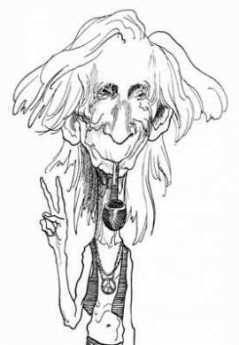
|
| Bertrand Russell in 1960s regalia. |
Bertrand Russell the bomb-thrower accepted the offer and came down to that quiet little lane where the neighbors object to the traffic coming to look at pictures. The five-year contract only lasted three years, when even Barnes got fed up, and summarily dismissed him. The circumstances have not been extensively documented, but they were sufficient to enable Russell to win a lawsuit for a redress of grievances. During that three year period on the Main Line, he had produced a book called History of Western Philosophy, which became a best seller and permanently relieved his financial difficulties, and was the basis for his winning the Nobel Prize in Literature. He spent the rest of his ninety-odd years leading demonstrations against the atom bomb, the Vietnam War, monogamy, religion and so on. There are those who regard Bertrand Russell as the role model for the whole Sixties generation, and, unfairly, the 2004 Democrat candidate for President. However, all that may be, his activity at the Barnes Foundation undoubtedly was a factor in the firm but the unspoken tradition of the Merion Township neighbors that they wanted to get that Art Gallery out of here.
Mind Your Manners
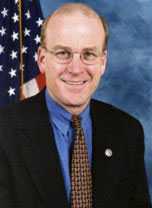
|
| Hoeffel |
In 1948 I was an intern at the old Pennsylvania Hospital, assigned for a while to the accident room. One of the accident-room duties of an intern is to sew up cuts and lacerations that arrive unexpectedly, but some lacerations can be out of your pay-grade and you have to call for help. On the evening in question, the victim had been so thoroughly slashed up that I had to call the chief surgical resident, Dr. Joseph Hoeffel. Hoeffel was big, tall, loud and self-assured, and swept majestically into the accident room with a little fellow trailing him. This follower seemed less than four feet tall but very quick and shifty. He didn't walk so much as he scuttled. Hoeffel bellowed, "Get out here!" and the gnome vanished.
While Joe was examining the laceration problem, the little fellow slipped through a different door to see what was going on. Most of us had the impression this guy might well be the one who inflicted the cuts, but in any event, he didn't belong where he was. "I told you to get out of here, and stay out," bellowed our surgeon. Again the scuttler scuttled away, while Hoeffel put on a sterile gown, sterile rubber gloves, mask, cap, and the whole ceremonial costume. He prepared to do his work, stamping out disease among the sick and injured, when a fist started at the floor. The little guy had slipped into the operating area once more, and soon the fist on the floor quickly flew in a wide arc, ending up on Hoeffel's jaw.
Hoeffel tumbled head over heels across the room, ending up in a corner. I don't think he was knocked out, but he was certainly dazed. The nurses called the police, who made a tumult of their own arriving to do battle. But the little fellow was gone, never to be seen again.
Fifty years later, I had occasion to preside over a meeting of the Right Angle Club, where
Hoeffel's son, the former congressman and current deputy member of the Pennsylvania Governor's cabinet, was the featured speaker. He looked remarkably like his father. I had to wonder if his father's lesson in diplomacy had made any notable effect on his progeny.
Lawn Tennis at the Cricket Club
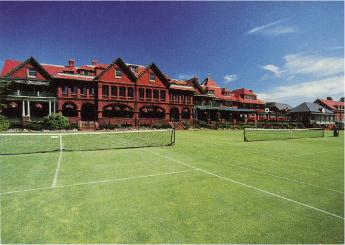
|
| Merion Cricket Club |
Lawn tennis isn't terribly ancient, having originated in England around 1880 as a variation of badminton which was brought back from India during the days of the British Empire. As the name suggests, it was originally played exclusively on grass courts, which proved hard to maintain. It was supplanted for a while by clay courts, and more recently by hard and artificial surfaces. Lawn tennis on lawns has largely become a game for the rich because of the cost and difficulty of maintaining a playable surface in hot weather.
If you wander into the Merion Cricket Club you'll find lawn tennis in the grand style, viewed from luncheon tables under a roofed porch. The long relatively narrow porch is right up against the grass courts, but it's also sort of a Peacock alley where well-groomed young ladies show their stuff, and everybody at the tables wishes to seem to know everyone else. There are times when the athletic entertainment becomes cricket out there on the field beyond the porch, but a larger proportion of the lunchers turn their backs on the field during that season than when exciting tennis championships are reaching the finals.

|
| "Lawn" Tennis |
In addition to being more expensive to maintain the courts, tennis on the grass is a different game from tennis on a hard surface, like clay or asphalt. The ball tends to skid when it hits the grass, so it is more effective to volley it before it hits or before it takes much of a bounce. The bounce tends to be more nearly straight up, while on harder surfaces the ball bounces at a low angle. Either way, the consequence is a tendency for a faster game on grass. The players run harder to get the ball at the bounce, and the advantage goes to those who serve hard and return the ball hard -- and fast.
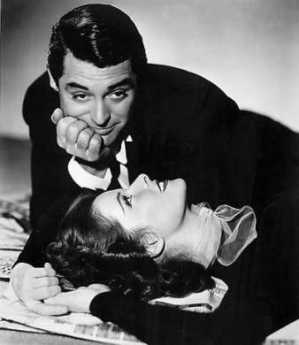
|
| Cary Grant and Kathryn Hepburn |
The rather special nature of the game adds to the up-scale atmosphere. And makes it just as attractive for the Kitty Foyles at the tables, as for the Kathryn Hepburns, both of whom have their own attractions for the Cary Grants. The parking lot is also a good place to form an opinion about the latest in high-priced autos.
www.Philadelphia-Reflections.com/blog/1494.htm
Potts
Rebecca Potts used to say there were three towns in Pennsylvania named after her family -- Pottstown, Pottsville,
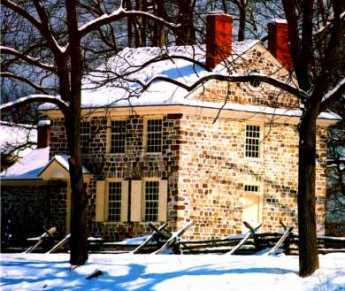
|
| Pottsville biennial |
and Chambersburg. Becky never designed to explain whether Chambersburg was just a joke or whether her very extensive family really had connections in Chambersburg. It's possible either way; there were certainly Potts inValley Forge where Washington's Headquarters, which everyone visits, had been home to Isaac Potts, the third generation of Dutchmen named Potts to live there. Isaac ran a grist mill, the others mostly were ironmasters. The family seat in Pottstown was named Pottsgrove, still open for visitors. Holland Dutch they may have been, but Pottsgrove architecture is definitely of the Welsh style.
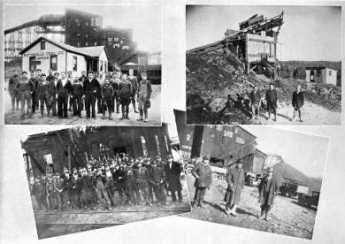
|
| Pottsville Coal |
Pottsville, much further up in the anthracite region, became notable through the novels of John O'Hara, a native son. For a whole generation, just about everybody in Pottsville was uneasy that O'Hara would confirm just who certain characters in his moderately raunchy novels represented in real life. Pottsville's main business for a century was extracting coal for the Girard Estate, which had its coal-mining headquarters in the town, based on Stephen Girard's shrewd purchase of nearly all of Schuylkill County.
The broad sweeping view from the interstate highway going north from Valley Forge makes it easy to see how Pottstown was created by the upheaval of a mountain ridge, which split open to let the Schuylkill River wind through. Pottstown is a water gap. The huge cooling towers of The Limerick nuclear power plant dominate one side of the river cliff and can be seen for miles. The cliff on the other side of the river, behind which hides the town of Pottstown, used to shelter the Wright aircraft factory, much of which was underground. That gave it a railroad (The Reading RR) and ready access to the river, plus privacy from the land side. Down to the right a mile is the Pottstown Hospital, on the edge of town, quite near the campus of the famous Hill School, fierce competitors of the Lawrenceville School in sports. Just about everything in this area is on top of some kind of hill.
Just back of the hospital, seemingly on the grounds of it, rises a peculiar steel tower, which the local workmen report is a sending station for cellular telephones. However, one of the doctors of the hospital relates a somewhat different history. He says he was once called on a medical emergency, told to ring the elevator at the little house beside the steel antenna, and travel down, down, into secret depths. He found himself in the headquarters of the Northeastern Air Defense Command, which was certainly hidden in an ideal place if the story has any truth to it. Unfortunately, that story-teller was a famous cocktail-party raconteur whose wild tales were never to be taken completely seriously. For many years, the hospital on a cliff was surrounded by corn fields, and it is certainly true you could look out the windows at a sea of corn, never suspecting you were very close to a railroad and a river, quite possibly right over an underground aircraft factory. Someday it may be possible to find out the truth of these tales of the Dutch country.
During the American Revolution, the British blockaded the coast and landed troops on the main coastal highways. The Americans responded in a quite natural way by building an inland north-south forest trail, sort of on the order of the Ho Chi Minh Trail. Pottstown was one natural stop on this trail, which tended to intersect with many roads coming up along the banks of the coastal rivers. In one very famous episode, wagon loads of Philadelphia Quakers were arrested and taken up the Schuylkill to Pottstown, then south to internment at Winchester, Virginia. They weren't exactly Tories, but they certainly were not sympathetic to revolutions. One of the most famous of these semi-prisoners was Israel Pemberton, one of the leaders of the Quaker colony. He later reported he was treated well, but onlookers in Pottstown described him as being thoroughly abused.
Pottstown had a century of prosperity during the industrial age, then declined and decayed. In recent years. The interstate highway has brought a migration of exurbanites whose taste in architecture tends toward McMansions. Let's hope they can acquire a dose of local history, starting a new historical revival of a town with great potential, considerable past glory, and a wonderful natural setting.
Radioactive River Bend
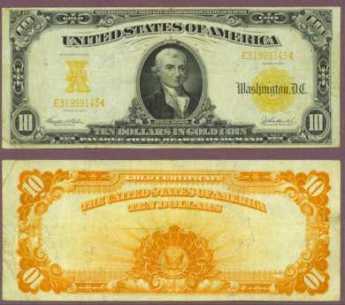
|
| Gold Cert |
A mile or two south of Pottstown, the Schuylkill River encounters a rocky ridge several hundred feet high and makes a bend around it. The first Treasurer of the United States, Michael Hillegas, built a colonial mansion on the point of the bend, and it has been lovingly restored and preserved by a noted Philadelphia surgeon and his wife. Alexander Hamilton, the first Secretary of the Treasury under the Constitution, has his picture on the modern version of a ten-dollar bill. So it is appropriate that Hillegas, the first Treasurer under the Articles of Confederation, had his picture on many versions of a ten-dollar gold note, back in the days when the American dollar was as good as gold. River Bend Farm is not only colonial, charming and maintained in mint condition, but it is also tucked away between the bend in the river and the high ridge to one side, giving it seclusion and privacy.
A high ridge near a river is unfortunately also an ideal place to build a nuclear power plant, and that's where the Limerick plant now looms up, glowing at night, occasionally making faint humming noises. There's a limited-access highway from Philadelphia to Reading which swoops up the valley, and the two high cooling towers of Limerick dominate the landscape for twenty miles. Because of the river bend, you aim straight for those towers for a long time before you swerve off, and the view is much like that from the bomber cockpit of the final scene in the movie "Dr. Strangelove". It gets your attention harmlessly, but it's hard to ignore. In spite of all sorts of official reassurance, everybody knows about Three-Mile Island, and Chernobyl, but few people emphasize there has never been a single injury from an American nuclear plant.
So, in 1981, everybody was ready to go into orbit when a worker named Watrus showed up for work at the nuclear plant and set off all manner of clanging alarms from radioactivity detectors. Panic and pandemonium for weeks, until a remarkable phenomenon was discovered. Watrus wasn't radioactive from the nuclear plant at all, but from having his work clothes laundered in his own basement. It slowly developed that radon gas seeps through the ground in many places in the United States, particularly over rocky ground. The gas then rises into the basement of houses and gets trapped. The more tightly the storm windows are applied and the more carefully sealed the seams of the house, the harder it is for the radon to escape. The Pennsylvania Dutchmen who live around Limerick are a little skeptical of this story and are not inclined to live any closer to the power plant that they have to. They are just as much in favor of oil self-sufficiency as anyone else, but still, no one likes being close to it.
The big winners from all this confusion are the people with radiation detectors, who go around the country testing people's basements for radon, for a fee. But unless you are willing to go live on the Sahara Desert, it isn't easy to see where you are going to go to avoid radon.
Lansdowne
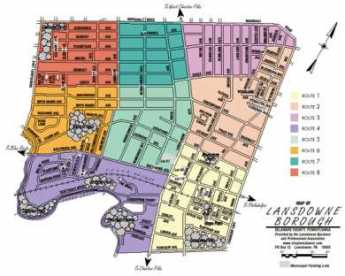
|
| Lansdowne Map |
The Granville, or Lansdowne, the family had so many members important in English history, that the Lansdowne name adorns countless schools, boroughs, colleges, museums and other monuments around the former British empire. It would require undue effort to sort out just why each memorial is named after just which member of the family. In the Philadelphia region, Lansdowne is the name of a small borough in Delaware County,
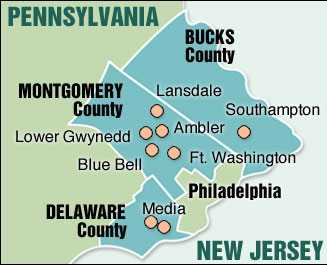
|
| Lansdale |
often annoyingly confused with Lansdale, a small borough in Montgomery County. However, it really seems more appropriate to focus reverence on the Lansdowne mansion, which from 1773 to 1795 was the home in now Fairmount Park of the last colonial Governor. That would have been John Penn, who was one of several Penns who still shared the Proprietorship until 1789, and who shared in the miserly payment which the Legislature of the new Commonwealth made as compensation for expropriating twenty-five million acres of their property. The French Revolution was going on at that time, so there were probably some patriots who would scoff that John Penn was lucky not to be guillotined.
The Penn family could see the Revolution coming, and like everyone else was uncertain who would win. Real decision-making for the Proprietorship rested with Thomas Penn in London, a close friend of the King and his ministers. The strategy employed in this difficult situation was to surrender the right to govern the colony conferred by its original charter and to become mere real estate owners with John their local representative pledging local allegiance. That might have worked for a while, until General Howe's troops captured Philadelphia. Soldiers were dispatched to Lansdowne to tell John Penn he was under detention, to reduce his potential utility to the occupying army.
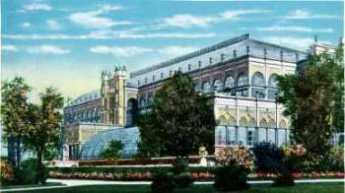
|
| Horticultural Hall |
As matters eventually worked out, some of the Penn descendants remained fairly wealthy after the Revolution, especially those whose wives had inherited substantial assets from other sources. But some were severely impoverished. The stately Georgian mansion burned down in 1854, and the site was then occupied by the Horticultural Hall of the 1876 Centennial Exposition. Perhaps because of misplaced patriotic fervor, it is now difficult to find a picture of Lansdowne.
The elegance of the place, on 140 acres, is suggested by the fact that William Bingham the richest man in America at the time, apparently acquired it from James Greenleaf the partner of Robert Morris, and the nephew by marriage of John Penn, who acquired it from Penn's estate but probably had to give it up in the financial disasters of Morris and his firm. Lansdowne was still a grand manner when it was briefly acquired by Joseph Bonaparte, the former King of Spain. In view of the fact that Bingham had provided President Jefferson with the gold to finance the Louisiana Purchase from Napoleon Bonaparte, and earlier had practically forced the Congress to call off an impending war with France, there was likely a connection here.
And to some extent, the ill-treatment which John Penn received from the Pennsylvania legislature (roughly fifteen cents an acre) in the Divestment Act of 1779 can possibly be traced to the unrelenting hatred by Benjamin Franklin, Pennsylvania's icon. History does not tell us what made these two former friends fall out in 1754, sufficient to make Franklin willing to spend years in London trying to get the colony away from the Penns. The feeling was surely mutual. When John Penn was offered the patronship of the American Philosophical Society, he declined, just because Franklin was its president. In retrospect, that sounds unwise.
Laundered Money
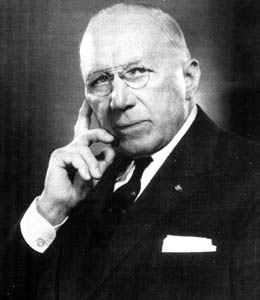
|
| Judge Edwin O. Lewis |
Judge Edwin O. Lewis finally got his way, the Pennsylvania State Government acquired four blocks of Chestnut Street stretching to the East of Independence Hall, and the Federal Government acquired four blocks stretching to the North. Judge Lewis was determined that a real revival of historic Philadelphia required the clearance of a lot of lands. Those who heard him describe it will remember the emphasis, "It must be BIG if it is to serve its purpose."
The open land is rapidly filling in but for a time the movers and shaker of this town had to scratch a little to find something to put there. That's fundamentally why the historic district has a Mint, a Federal Reserve, a Court Houses, a Jail, and a big Federal Building to house various local offices of the landlord, the federal government. It's where you go to visit your congressman, or to renew your passport, or to argue with the Internal Revenue Service. If you have certain kinds of business, there's an office for the FBI and the U.S. Secret Service. The mission of the Secret Service is a little hard to explain with logic.
The Secret Service is a federal police organization, charged with protecting the President of the United States, and enforcing the laws against counterfeiting money. In unguarded moments, the Secret Service officers will tell you they only have one function: to guard three-dollar bills. The President only comes to town from time to time, but the mandate extends to the President's family, and to the extended family of official candidates for election to that office. So, there is usually always a certain amount of activity relating to running behind limousines with one hand on the fender, or poking around rooftops near the speaker's platform at Independence Hall, or talking apparently to a blank wall, using the microphones hidden in their ear canals. The rest of the time is taken up with counterfeiters, but even then the excitement is only occasional, depending on business.
A few years ago, the buzz around the office was that some very good, even exceptionally good, fake hundred dollar bills were in circulation in our neighborhood. The official stance of The Service is that all counterfeits are of very poor quality, easily detected and no threat to the conduct of trade. Unfortunately, some counterfeits are of very good quality, not easily detected, and when that happens, The Service is made to feel a strong sense of urgency by its employers. These particular hundred dollar fakes were of very good quality.
One evening, a call came in. Don't ask me who I am, don't ask me why I am calling. But I can tell you that a very large bag of hundred dollar wallpaper has just been tossed over the side of the Burlington Bristol Bridge, near the Southside on the Jersey end. Goodbye.
Very soon indeed, boats, divers, searchlights, ropes, and hooks discovered that it was true. A pillowcase stuffed with hundred dollar wallpaper of the highest quality was pulled out of the river. By the time the swag was located and spread out for inspection, it was clear that several million dollars were represented, but they were soaked through and through. Most of the jubilant crew were sent home at midnight, and two officers were detailed to count the money and turn it in by 7 AM. The strict rule about these things is that all of the money confiscated in a "raid" was to be counted to the last penny before it could be turned over to the day shift and the last officers could go home to bed. After an hour or so, it was clear that counting millions of dollars of soggy wet sticky paper was just not possible by the deadline. So, partly exhilarated by the successful treasure hunt, and partly exhausted by lack of sleep, the counters began to struggle with their problem. One of them had the idea: there was an all-night laundromat in Pennsauken. Why not put the bills in the automatic drier, so they could be more easily handled and counted? Away we go.
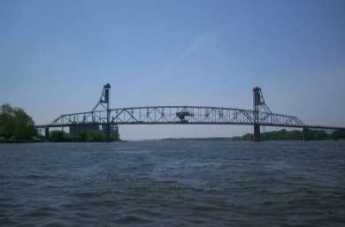
|
| Burlington Bristol Bridge |
At four in the morning, there aren't very many people in a public laundromat, but there was one. A little old lady was doing her wash in the first machine by the door. It was a long narrow place, and the two officers took their bag of soggy paper past the old lady, and down to the very last drying machine on the end. Stuffed the bills into the machine, slammed the door, and turned it on. Most people don't know what happens when you put counterfeit money in a drier, but what happens is they swell up and sort of explode with a terribly loud noise. The machine becomes unbalanced, and the vibration makes even more noise. The little old lady came to the back of the laundromat to see what was going on.
As soon as she got close, she could see hundred dollar bills plastered against the window, and that was all she stopped to see. She headed for the pay telephone near the front of the door. The secret Servicemen followed quickly with waving of hands and earnest explanations, but within minutes there were sirens and flashing lights on the roof of the Pennsauken Police car. Out came wallets and badges, everyone shouting at once, and then everything calmed down as the bewildered local cop was made to understand the huge social distance between a municipal night patrolman and Officers of the U.S. Secret Service. Now, he quickly became a participant in the great adventure and was delegated the job of finding something to do with armloads of (newly dried) counterfeit hundred dollar bills. He had an idea: the local supermarket was also open all night, and they carried plastic garbage bags for sale. Just the thing. But who was going to pay the supermarket for the bags? Immediately, everyone was thinking the same thing.
Fortunately for law and order, the one who first suggested the the obvious idea of passing one the counterfeits was the little old lady. At that, everyone came to his senses. Wouldn't do at all, quite unthinkable. The local cop was sent off for the bags, relying on his ability to persuade the supermarket clerk. And, yes, they did get the money all counted by 7 A.M.
Life On The River (3)
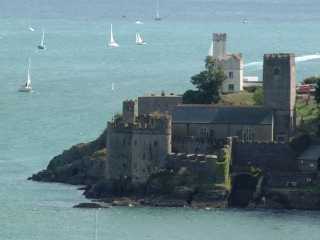
|
| Darth Mouth Castle |
All over Europe the scene is repeated: a market town and seaport at the mouth of a river, with many miles of riverbank castles in the hinterland. The seaports had to be fortified against pirates, the hinterland against marauding brigands. But the two flows of commerce consisted of baronies upriver feeding the seaport, while secondarily their seaports carried on trade with nearby river-organized economies. From time to time, someone like Julius Caesar, Napoleon, Bismarck or Hitler would try to unify the various river economies, usually unsuccessfully. In fact, the same pattern was seen along the Pacific Coast of South America, until the Incas figured out how to go along the mountain ridge in the far interior, and then come down the rivers from the sparsely populated areas to the maritime settlements at the mouth of the river, whose defenses were planned for enemies from the sea. Philadelphia followed the commercial pattern, but without fortresses and castles.
Because of the vagaries of King Charles II, and underneath that, because of marshes and their mosquito-borne diseases, the Delaware Bay was settled fairly late in colonial times -- and almost entirely by Quakers. The Dutch were interested in fur trading rather than settlement, the Dutch were anyway too few, their sovereign too indifferent, and William Penn took care of the Indians. So the English settlers had no one to fight except other Englishmen, once the French stab at Inca-like strategy was put down in 1753. After 1783, or perhaps 1812, the world finally left us alone. The Delaware Bay and River are essentially free of fortresses, Philadelphia has no castles. The peaceful sixty miles of upper Delaware Bay became lined with big farmhouses, or big Federalist and Victorian mansions. For a century, from the Revolutionary War to the Civil War, and even for a time after that, the history of this peaceful pond reads like a novel by Jane Austen.
As a playground for menfolk, it would be hard to improve on Victorian Delaware Bay. The river was full of fish, notably shad. In the fall, the migrating ducks and geese made for marvelous hunting. In the countryside behind the riverfront, houses were found all the sports having to do with horses; fox hunting, racing, horses shows. The kids could putter around in small sailboats, the adult sailors could sail a yacht to Europe if they wanted to. After John Fitch invented the Steamboat, it was possible to take a daily commute to the best male game of all -- trading, investing and gambling in the financial and commercial center of Philadelphia.

|
| Shad |
Marion Willis Rivinus and Katherine Hansel Biddle wrote a little book in 1973 called Lights Along the Delaware which tells the river story from the female point of view. The woman of the house was sort of the mayor of a little city, organizing the staff, supervising the garden, educating the children, planning the household, and organizing the dinners and social events. Educated and trained to the role, she knew what to do and enjoyed doing it. Jane Austen wrote the handbook. And while the menfolk were essential members of the cast of characters, women were the managing directors. The men were off with their horses, or sailboats, or fishing rods, or their faraway big-deal mergers and acquisitions. True, it was not a notably intellectual community, there was no Edith Wharton, Abigail Adams or Emily Dickinson. You might find some of that in Germantown, perhaps. The professions, law, and medicine, lured the more studious male members away from Society, but the international diplomatic circle was seen as the ideal career for any truly graceful graduates of this environment.
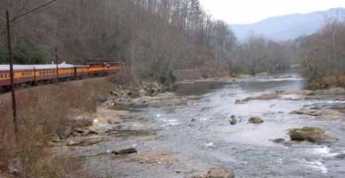
|
| Riverbank Railroad |
As the riverbank was gradually destroyed by railroads and expressways, only a few mansions like Andalusia remain in good repair. Curiously, what endures best are the clubs. The fishing club variously called the Fish House, the Castle, the Colony in Schuylkill, or the Schuylkill Fishing Company of the State in Schuylkill, has moved as many times as the name has changed. Started in 1732, it is the oldest continuously existing men's club in the world. It moved to the Delaware River from the Schuylkill when the Fairmount dam was built, and to its present location at Devon, the estate of William B. Chamberlain in 1937. New members do the cooking, cleaning, and serving, older members tell stories. When the river pollution is finally controlled, they may go back to catching the fish as well as cooking them. There's the Philadelphia Gun Club, which before 1877 was the Public Holiday Shooting Club of Riverton NJ. And then there's the Gloucester (NJ) Fox Hunt, which during the Revolution turned into First Troop, Philadelphia City Cavalry. After escorting George Washington to the battles of Boston Harbor, The Troop has been an active fighting unit of the National Guard (most recently in Bosnia) as well as a devoted center of male horsemanship between wars. The Farmer's Club, the Agricultural Society, and the Horticultural Society all reflect the rural interests that once predominated just behind the riverfront estates, still thriving aloof after 150 years of suburbia, exurbia and urban revival.
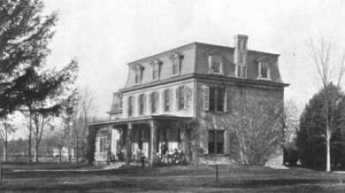
|
| Philadelphia Gun Club |
Although the riverfront industrial slums which destroyed the Philadelphia branch of Jane Austen's gracious living subculture are themselves declining and seem about to go away, it would take a real visionary to imagine how the Grand Life on the River will ever return. The banks of Delaware are much lower than the bank of the Hudson, for example. They make a great place to put high-speed rail lines and even higher speed interstate highways. The patrons of Hyde Park, West Point, and Poughkeepsie are much higher up a cliff and can overlook the river without much noticing an occasional whoosh. The mansions along Delaware have to look right at the tracks. Except for a few places like Bristol which have become isolated on the river side of the tracks and highway, it's not easy to see how you would get from here to there, or when.
Litchfield County, Extended (1771-1775)
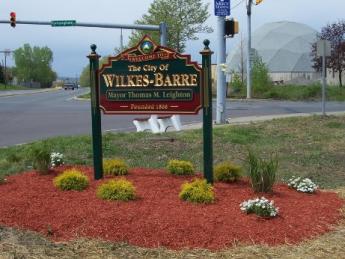
|
| Wilkes-Barre |
FOR four years, the Connecticut settlers considered the apparently peaceful Wyoming Valley of Pennsylvania to be part of Litchfield County, Connecticut, and its main little town was called Westmoreland (now Wilkes-Barre, although it still has a Westmoreland Club). However, the high-living, non-Quaker sons of William Penn were ill content to let matters remain that way. Their response was to sell large tracts of land in the area, on condition the purchasers would do whatever fighting was needed to conquer and hold it. The main purchasers were Scotch-Irish from Lancaster County, and the main speculators were prominent Philadelphians with names like Francis, Tilghman, Shippen, Allen, Morris, and Biddle. This speculative land sale was to be the source of trouble for decades because it conflicted with titles to the same land issued by the Susquehanna Company.
The predictable trouble surfaced in 1775, with the Second Pennamite War. Under the command of a man named >Plunkett, 700 Pennsylvania soldiers marched to liberate Wyoming and were soundly defeated by the Connecticut soldiery under the command of Zebulon Butler. There might have been further fighting in this expanded war, except for the other eleven colonies applying great pressure on these two colonies fighting each other with potential jeopardy to the united rebellion against British rule. While the Penn family were definitely royalist in their sympathies, their colonial property put them in an awkward position with their Scotch-Irish allies, who were, in all colonies, the main leaders in the revolution. The effect was to isolate the Connecticut invaders, even though they were the victors in the fighting.
Slum Creation and Urban Sprawl
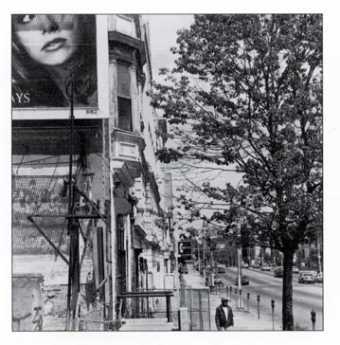
|
| North Philly |
Slum creation, while occasionally deliberate, is most typically caused by an area's abandonment by previous owners, at lower prices, to bargain hunters. When a large employer moves or closes, the employees seek work elsewhere and sell their houses for what they can get. When the influx of new ethnic groups threatens to weaken real estate prices, panic may be created that waiting too long to sell may find the property worthless; nobody wants to be the last one out the door. During the 20th Century, the driving force in Philadelphia was the flight to the suburbs by people who found a better value in suburban schools, shops, and neighborhoods. All of these processes create slums, almost invariably with a net loss of value in the community. Take a look at those deteriorating mansions on North Broad Street, where the Civil War millionaires used to live. In today's terms, they were once worth several million dollars apiece, but in today's real estate market, they are next to worthless. Value disappeared. The community as a whole is poorer than it was. From the Mayor's point of view, the area has lost its tax base.
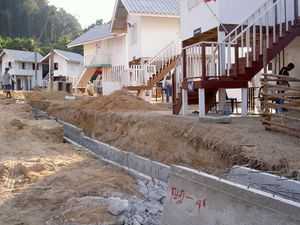
|
| New Construction |
Of all these forces, the flight to the suburbs is probably the least destructive to the region, particularly if it is reasonably slow. Out in the suburbs, value is being created as cornfields turn into suburbia, and that added value must be set against the reduced value of the abandoned slum areas. Viewed from the Mayors' perspectives, however, we have a zero sum. The city loses its tax base, the suburbs gain, and local politics soon degenerate into warfare between the suburbs and the city. Not a nice situation, and it cries out for a new civic design. The city politicians have dreamed for a century of city-suburb consolidation, but Philadelphia tried that in 1850. It didn't cure the problem, and it may have created new problems. In any event, suburban politicians live and die on their anti-city rhetoric, and everybody's behavior in the Legislature deserves no kinder description than -- savage.
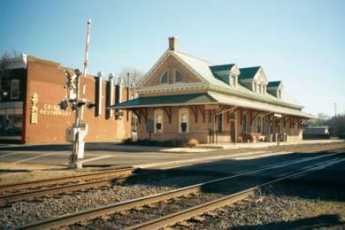
|
| Orange Station |
Because this issue has been the underlying theme of the Pennsylvania Legislature for two centuries, it repeatedly surfaces in ways that are surprising unless you understand the mechanics of suburban sprawl well enough to see the connection. For example, nowadays a real issue is the three-car family.
During the 19th Century, multi-acre estates spread out along the Main Line of the Pennsylvania Railroad, with the coachman and horses taking plutocrats to the station. Smaller houses, for people who walked to the station, clustered nearby, but you didn't have to go very far from the station to find the gated estates. Suburban development spread out in linear and predictable fashion from the city, along the Main Line. The advent of the automobile freed commuters from the tyranny of railroad station orientation, and middle-class residents could flee the city to areas of the suburbs that were fairly far from the railroad and its stations. But not too far, because there was the problem of the lady of the house, who had to get to the stores. To free her up, the family had to have two cars in the garage. Suburban shopping malls helped her problem, somewhat, but the railroad station was still a magnet.
And then, the majority of married women became working wives, confronting the problem of kids getting to the confounded school. The highly questionable solution of giving the kids a collective car as soon as the oldest got a license, made the oldest kid proudly take the role the coachman used to have, and it caused a lot of teenage turmoil that need not be described here. The point to be stressed is that the three-car family sent home-building into cornfields that were not even close to the main road. Since land gets cheaper the further you get from the city, an economic incentive is created to enter uncongenial social environments, and adopt unexamined attitudes about the environment that are ultimately flatly contradictory.
When the kids leave home, the exurban pioneers no longer need the third car, and think about returning to city life. So far, however, they have been returning to Center City, not the residential neighborhoods they used to call home.
Founding Fish

|
| Potomac |
In 2002, John McPhee brought out a perfectly splendid book about fish and fishing history in this region, with particular emphasis on shad. He makes the whole topic remarkably interesting, but you have to be a little wistful about the way he demolished a splendid story of fish in Philadelphia during the Revolutionary War. The book is called The Founding Fish.
As everyone knows, George Washington and the Continental Army were starving and freezing at Valley Forge, a few miles up the Schuylkill, while Major Andre and the other British officers were cavorting downtown with the Tory ladies, grr. The story has long been told that things got to a desperate state at Valley Forge when, lo, the annual shad run was several weeks early and mountains of fish came roaring up the river to the excited shouts of the starving patriots and rescued the raggedy starving Continental Army. It would make a wonderful scene in a movie.
McPhee tells us that George Washington was in fact a shady merchant, having caught and pickled many barrels of shad coming up the Potomac River. The annual shad excitement was no news to him, and it seems quite possible he selected the campsite at Valley Forge with this spring event in mind. Shad was no news to the British, either; there are records of their trying to block off the Schuylkill with nets to prevent the fish from getting upriver to Valley Forge.
Unfortunately, a careful search of letters and records fails to record any shad run earlier than April that year. The rescue of song and story does not appear in contemporary documents. What's more, some unnecessarily diligent scholars have sifted through the garbage heaps of the encampment area, and have only found pig and sheep bones, no shad bones.
Those graduate students undoubtedly deserve to be awarded degrees for their work, especially the digging in garbage part. But nevertheless, it all does seem a pity to ruin a good story that way.
A Few Rooms of Your Own
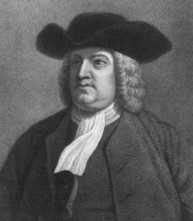
|
| William Penn |
If William Penn could revisit Philadelphia today, he would surely feel disappointed that the Greene Country Towne still hasn't materialized. Even a century after Penn's real visits, Philadelphia at the time of the Revolutionary War still nestled East of Fifth Street. There have been many conjectures about this, perhaps fear of Indian attack, perhaps lack of firewood, desire to be near the port, perhaps a number of things. Let's examine whether it's just the nature of a successful city to organize itself the way it does.
Ancient Athens, for example, was a nice warm place without much rain, which possibly accounts for the miserable little hovels where people lived, contrasting with the magnificent Acropolis, Parthenon, Stoa and other public buildings. It has been speculated that the architecture created the social system, not the other way around; the same contrast between big stone temples and little wooden huts is also seen in the Mayan cities of Yucatan. Hong Kong certainly isn't poor, but it's built like that. Japan cannot claim that lack of land forces the citizens to live in tiny apartments. It's hard to say whether the lowly social state of Japanese women accounts for the contrast between where they live and where their husbands spend most of their time because it's just as easy to believe the proposed cause is really an effect.
The more you look around the world, the more you wonder if it isn't the American suburb that's out of step with the world. When they can afford it, hardly any of the world seems to want to live in the suburbs; their homes are seldom their castles. There's New York City, of course. New Yorkers seem to like living in high-rises.
An architect friend makes short work of construction economics as a driving feature. According to him, it is unduly expensive to live in a high-rise. Just a pointless ego trip. The cost per square foot of usable floor space just keeps going up as the building gets taller, requiring more elevator shafts, more elaborate HVAC. That's heating, ventilating and air conditioning. Everything has to be built with a derrick, the traffic congestion at the base is horrific, high winds can break the window glass. The list rapidly grows convincing. Why does anyone pay all that extra money to live high in the sky? Not my idea of something to do, says Cole Porter.
Notice there is a major difference between sleeping in the suburbs as they do in Japan, and sleeping in apartments right near the center of town, as they do in Budapest, Berlin, Prague, and Vienna. The Orientals are staying close to work for longer hours, while the Central Europeans are staying close to the cafes and theaters to which they flock the moment work is over. Just what to think of the Spanish siesta system isn't clear, but it seems to have the main effect of bringing people back into the center of the town at night. You can't live very far away from work if you have to commute twice a day.
The Lord only knows where everybody in New York is going every Friday night, with return traffic jams in the other direction on Sunday night. The weekly exodus suggests they don't really luxuriate in their penthouses or flock to their entertainment district on weekends; apparently, a cabin in the woods is beckoning. As, by contrast, the empty nesters in the suburbs eventually look around for retirement villages to live, repeating the endless complaint about the nuisance of maintaining a big house and garden. Pennsbury looks like a comfortable place to live, but even William Penn seems to have tired of it. One really does have to wonder whether a heart's desire in architecture all too frequently leads to heart's discontent in lifestyle. Philadelphia appears to be trying a new approach; the suburbs are moving back downtown.
We'll eventually see if it changes our character and lifestyle so somebody can write sociology books about it.
Merging Cities With Their Suburbs
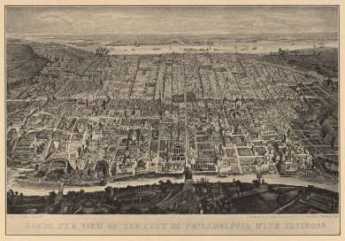
|
| Philadelphia 1854 |
When the City of Philadelphia turned into the County of Philadelphia (or vice versa) in 1854, the area had about 150,000 residents in 1850 but 500,000 in 1860. It qualified as one of the largest cities in America at the time, but what we today call middle-sized cities are about that same size. As a generalization, when a thriving American city approaches a size of about half a million, the business community often gets the idea that the city should expand its limits by annexing the neighboring districts. And, as a further generalization, the metropolitan newspapers are simply ecstatic about the idea of expanding their market reach, while the working classes of both the city and the region it proposes to swallow, are violently opposed. Since the business community typically feels that expansion would be good for business, labor unions are subdued. Leadership of the conservative middle-class rebellion is therefore generally led by the police and volunteer firemen, who are the most organized groups within the combative working class in a metropolitan region. Many citizens of all classes are of course quite indifferent about the matter. As history has turned out, only one such proposal in five will be successfully adopted, but it is almost unheard-of for a successful amalgamation to be reversed once it happens. In recent years, this general pattern has been followed in Indianapolis, Lexington, Jacksonville, Nashville, Baton Rouge, and Louisville. In countless other cities, the effort has been defeated by the voters.
It requires thriving prosperity for the business community to become politically dominant in a city, so the political context of these circuses amounts to a contest between the business "elite", often augmented by "carpet baggers from out of town" threatening comfortable lives within settled neighborhoods by merging them with culturally discordant residents in suburbs or countryside. On a political level, professional urban politicians favor expansion, because increasing the electorate generally makes it more expensive for an outsider to raise the funds to defeat them in an election. Exceptions to this rule occur when the two merging regions have different political parties in control, or when working-class city districts are so opposed that urban politicians fear to anger them. A symptom of this conflict for control of a city machine can be observed in the seemingly unrelated issue of a city charter with a "strong mayor" design. Cities with a strong city council generate greater ability to defeat the machine and are hence more reluctant to see mergers with suburbs. Nevertheless, the attraction which the business community can offer to the politicians is a larger tax base, although in the surrounding suburbs the dynamic is exactly the opposite. In the suburbs, it is the local businesses and professions who feel threatened, and who attempt to agitate the suburban politicians to protect their tax collections.
Although campaign rhetoric in these battles tends to exaggerate or distort the probable economic changes, academic studies find that the actual effect of city expansion is generally of modest subsequent growth, with modest increases in taxes. These effects seem comparatively weak since a metropolitan region is unlikely to produce a successful merger unless the economy is already growing fast enough to generate expansionism, and that vigor is likely to persist after the merger. These political uproars talk a great deal about economics, but in fact, the issue is primarily political. One commentator calls them "chess games pretending to be circuses", and the real force at work is usually an elaborate variation of gerrymandering. Urban minorities who usually vote Democrat can be swallowed up by suburban majorities who usually vote Republican. Or else a thwarted inner-city business community hopes to replace the urban machine with a more favorable suburban set of attitudes. There is seldom a uniform political gradient as the city border is approached from either side, so the chess game takes these patchwork population variants into detailed consideration. It is often argued that crossing a political boundary is unworkable, but since the thriving city of Atlanta is located in two different counties, that must not be a dispositive argument.
In their most elemental form, these expansion efforts have to do with political boundaries. It is therefore not surprising that the people most concerned are politicians. The battle cry is often to create a city without suburbs; failure to act leads to suburbs without a city. In fact, the underlying agendas are much more prosaic.
Country Auction Modernized
Only a decade ago, the Quakertown exit of the Pennsylvania Turnpike made possible a quick trip from the city to the country, letting you off in the cornfields between Sumneytown and Lansdale. Today, the rush hour traffic is as bad as anywhere else, even on the four-lane express highway known as Forty Foot Road. A comfortable two-lane highway would be about forty feet wide, so presumably, the name denotes what was once a modern miracle of a two-lane highway, in this case until quite recently. It's all built up for miles, but almost all the commercial buildings are new. Exurban sprawl has positively lurched across the landscape, making prosperous people rich, and poor people prosperous. It won't be long before the housing subdivisions demand traffic signals to protect the school children, speed limits to reduce the collisions by teenagers, and other things destined to bring high-speed travel to a crawl, all day long. When that happens, it won't be called farm country anymore.

|
| Alderfer Auction Company |
On Fairground Road, where occasionally corn is still growing, a number of large new commercial enterprises have located, among them a moving and storage company with ten or so truck loading platforms in the back. Behind that is another large new building, also with a parking lot for fifty or so cars, the auction house. Different categories come up for auction on different days, so used furniture, for example, comes up every few weeks and has to be stored as things accumulate for the big day. With a moment's thought, you can easily see why the auction is affiliated with or owned by a moving and storage company. As you go through the entrance, you are invited to sign up and identify how you plan to pay, just in case you buy something; the product of this registration is a card with a number in big colored letters. That's your number, your payment arrangement, and soon you will find no one cares anything about you except that number. The auction I was interested in was for used books, one of three or four auctions conducted in different rooms.
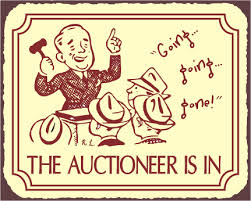
|
| Auctioneer |
Nearly a hundred people had numbers for used books, maybe a similar number for antique furniture and paintings. Obviously, one other purpose of the registration process is to create a mailing list of customers interested in various objects, possibly linked to a program which sends out flyers and announcements. Country auctions have always been a source of local entertainment, so non-buying spectators are able to come and watch if they wish. There seemed to be few if any casual sight-seers; just about everybody is a buyer or a potential buyer. Players, as they say.
Most of the customers probably set their alarm clocks for 5 AM or earlier; the auction is centrally located, but most everybody comes from a considerable distance. At 9 AM, very promptly, the auction began, and from his manner, you could tell the auctioneer was anxious to get started. The object for sale had been on display for a day, but most people arrived around 7 AM to examine the goods, which are frequently sold in lots, meaning a box full of thirty or forty books more or less on the same topic. At the stroke of nine, the auctioneer chanting began, "Do I have ten dollars, yeh, ten, ten, ten, five, five, ten, fifteen, twenty, twenty, sold for fifteen. Your number, sir?" Two assistants took down the customer number, and the lot number, and the price; one of the two recorded the transaction in a computer, the other on a list by hand. One gathers the man without a computer was on the look-out for shills, people trying to bid up to the price without getting stuck for a purchase. The auctioneer repeatedly assured the audience that no one but a real bidder was allowed to bid, you owned it, and no excuses about being confused. When he reached he hundredth sale, he stopped for a drink of water, and proudly noted the first hundred sales took thirty-seven minutes. It required four other assistants to fish out the lots next in line, holding them up for confirmation only, since inspecting them at as the distance was out of the question. After each sale, the assistant dumped the prize in the new owner's lap.
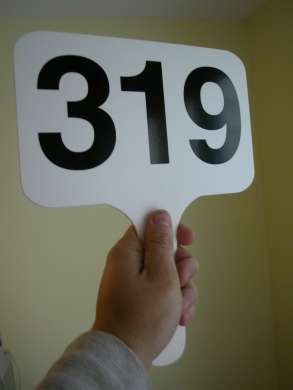
|
| Auction Paddle |
And yet entitled to wonder a little. The ordinary run of books thirty or forty years old will sell for between ten and twenty dollars. Books about golf, just about any old book about golf, "go" for about forty dollars. Children's books are about sixty dollars. And, to my great surprise, boxes or albums of old photographs go for over a hundred dollars. A lady next to me excitedly brought an album of old photos back to her seat and thumbed through them. "Are you a dealer?" Yes. "Who buys this stuff?" I don't know, they come to my store and just buy it. Like the Auctioneer, she had a feeling for what the retail price would be, made a calculation, and knew what she could afford to pay wholesale. What the stuff actually represented, why people wanted it, what was a good one and what was a bad one--these people in the trade had very little idea. But they knew very precisely what a fair price, and gradually lowers it until it sells. Fun Lots of fun. When a familiar insider makes a mistake and pays too much, the others laugh heartily at him. Why this funny system works has long been a mystery, but everyone except a socialist readily acknowledges it does work. At least it works better than any known substitute.
Although the ritual of the country auction has been essentially unchanged for the centuries, it is just another transaction system. In the past fifty years, the world economy has been transformed by computerized efficiencies in transaction systems, with vast prosperity resulting from small saving endlessly repeated. Banking and Wall Street have concentrated most of the standardized transaction, in perfectly astounding volume; lots and lots of people have become immensely rich for producing small efficiencies in high volume. Those of us who have not become immensely rich can easily identify trivial innovations which resulted in wealth, and we easily sense the unfairness of old photos worth more than books of poetry. After all, the country auction is still grossly inefficient; the seller pays the auction company 20% of the price, and the buyer pays another 10%. There's 3% for the credit card company and &% for the sales tax. Forty percent of this transaction is going to the middle man, over and over and over again. The goal is to reduce transaction costs to the level of Wall Street, considerably less than one percent, Which still lots of yachts for middlemen.
As you walk out of the country auction, it doesn't take a mathematical genius to multiply thirty percent times the number of transactions, times a guess at the average sales price. No wonder these auction people are so cheerful, so much in love with their work. But two other parties are cheerful, too. That is, the buyer and the willing seller.
SEPTA's Long Term Planning
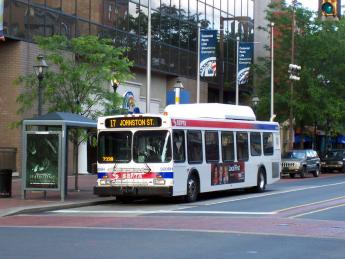
|
| Septa |
Byron S. Comati, the Director of Strategic Planning and Analysis for SEPTA (Southeastern Pennsylvania Transportation Authority), kindly gave the Right Angle Club an inside look at the hopes and plans of SEPTA for the near (five-year) future. Students of large organizations favor a five or six-year planning cycle as both short enough to be realistic, and long enough to expect to see tangible response. If plans continuously readjust to fit the five-year horizon, the concept is that the organization will move forward on these stepping stones, even accounting for setbacks, disappointments, and surprises. Furthermore, a serious level of continuous planning puts an organization in a position to react when funding opportunities arise, such as the sudden demand of the Obama Administration that economic stimulus proposals be "shovel ready."
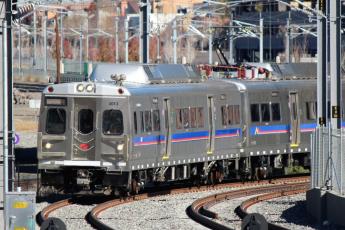
|
| The Silverline V |
So, SEPTA is currently promoting five major expansions, based on the emerging success of an earlier plan, the Silverliner V. Silverline is a set of 120 shiny new cars, built in Korea on the model of electrical multiple units, which are expected in Spring 2011 to replace 73 cars or units which were built in 1963. Obviously, 120 are more expensive than 73, but they are more flexible as well. And less wasteful; most commuters are familiar with the model of three seats abreast which unfortunately conflict with the social preferences of the public, tending to make the car seem crowded even though it is a third empty. When a misjudgment like this is made, it takes fifty years to replace it with something better. For example, there's currently a movement toward "Green construction", which is acknowledged to be "a little bit more expensive". The actual costs and savings of green construction have yet to become firmly agreed on, so there's an advantage to being conservative about what's new and trendy in things that take fifty years to wear out.

|
| Septa Regional Map |
Four of SEPTA's five major proposed projects are in the Pennsylvania suburbs. New Jersey has its own transportation authority, and Philadelphia is thus left to struggle with the much higher costs of urban reconstruction assigned to its declining industrial population. And left unmentioned is the six hundred pound gorilla of the transportation costs of new casinos. A great many people are violently opposed to legalized gambling, and even more upset by the idea of crime emerging in the neighborhoods of gambling enterprises. Even the politicians who enacted this legislation are uncomfortable to see the rather large expenditures which will eat into the net revenue from this development. Nevertheless, if you are running a transportation system, you have an obligation to plan for every large shift in transportation patterns, no matter what you might think of the wisdom of the venture. The alternative is to face an inevitable storm of criticism if casinos come about, but without any preparation having been made for the transportation consequences. At present, the public transportation plan for the casinos is to organize a light rail line along the Delaware waterfront, connecting to the rest of the city through a spur line west up Market Street; it may go to 30th Street Station, or it may stop at City Hall. That sounds a lot like the present Market-Frankford line, so expect some resistance when the cost estimates are revealed. Because all merchants want to have the station stops near them, and almost no residents want a lot of casino foot-traffic near their homes and schools, expect an outcry from those directions, as well. It would be nice to integrate this activity with something which would revive the river wards, but it seems a long stretch to connect with Wilmington on the south, or Trenton on the north.
The planned expansions in the suburban Pennsylvania counties will probably encounter less controversy, although it is the sorry fate of all transportation officials to endure some hostility and criticism for any changes whatever. Generally speaking, the four extensions follow a similar pattern of building along old or abandoned rail lines, following rather than leading the population migrations of the past. When you are organizing mass transit, there is a need to foresee with some certainty that there will be a net increase in commuters in the region under consideration. The one and two passenger automobile is a much more flexible instrument for adjusting to the growth of new development, schools, retail, and industry. Once the region has become established, there is room for an argument that transportation in larger bulk is cheaper, cleaner or whatever.
The Norristown extension follows the existing but underused rail connections to Reading. Route US 422 opened up the region formerly serving the anthracite industry, but now the clamor is rising that US 422 is impossibly crowded and needs to be supplemented with mass transit.
The Quakertown extension follows the rail route abandoned in 1980 to Bethlehem and Allentown, although the extension is only planned as far as Shelly, PA.
The Norristown high-speed extension responds to the almost total lack of public transportation to the King of Prussia shopping center, and will possibly replace the light rail connection to downtown Philadelphia.
And the Paoli extension follows the mainline Amtrak rails as far as Coatesville.
All of these expansions can expect to be greeted with huzzahs by developers, land speculators, and newsmedia, but resistance will inevitably be as fierce as it always is. Local business always fears an expansion of its competitors; the feeling is stronger in the suburbs than the city, but local business always resists and local politicians always follow their lead. To some extent, the suburbs have a point, since radial extensions are usually much cheaper to build than lateral or circumferential transportation media; bus routes are the favored pioneers in connecting one suburb with another. Therefore, the tendency in these present plans remains typical by threatening the suburbs with a need to travel toward the center hub, then take a reverse branch back in the general direction of where they started, in order to go a short distance to a shopping center or school system. The two main river systems around Philadelphia interfere with the construction of big "X" routes from the far distance in one direction to the far distance in the opposite direction. Euclidian geometry makes the circumferential route elongate as the square of the radius. And jealousies between the politicians in three states create rally foci for the special local interests which feel injured. Since it seems to be an established fact that the proportional contribution to mass transportation by the surrounding suburbs of Philadelphia is traditionally (and considerably) lower than the national average, a political reconciliation might do more for the finances of SEPTA than any federal stimulus package could do. For such reconciliation, a few lateral connections in the net might pacify the suburbs enough to justify the extra cost. Unfortunately, the main source of unjustified cost in regional mass transit is the high wage and benefit levels of the employees, a situation inherited from the old days when commuter rail was part of the stockholder-owned regional railroads. Just as featherbedding was the main cause of the destruction of the mainline railroads, health and pension benefits threaten the life of mass transit. In the old days, local governments acted as a megaphone for union demands. So the railroads just gave the commuter system to the local governments, and let them wrestle with the unions themselves. Since the survival of the urban region depends on conquering this financial drain, the problem must be gradually worn down. But it has been remarkable how long the region has been willing to flirt with bankruptcy rather than bite this bullet.
If anything, this friction threatens to get worse. In 2009, for the first time, a majority of union members in America -- work for the government, the one industry which thinks it cannot be destroyed by losing money. True, SEPTA is not exactly a government function, but it has enough in common with a government department to arouse suburban voters, who regularly refer to it as an arm of the urban political machine. SEPTA isn't too big to fail, but there exists little doubt that government at some level would probably try to bail it out if it did.
Willow Grove Park
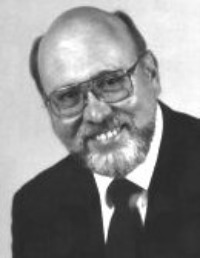
|
| Richard Karschner |
The Right Angle Club was recently highly entertained by a talk by Richard Karschner about the hay day of Willow Grove Park. Mr. Karschner appeared before the club in full uniform of the Marine Marching Band with medals and quickly demonstrated an immersion in this topic that must have taken a lifetime to perfect. He put on a virtuoso performance, a prepared speech perfectly timed to an automated slideshow, which was in turn in perfect synchrony with an automated musical background, exactly tailored to fit the momentary subjects. He concluded with a brilliant brief solo on the cornet (trumpet), using double and triple tongue-ing. To some of us who remember some futile struggling with the trumpet in our high school marching bands, the skill demonstrated was certainly impressive.
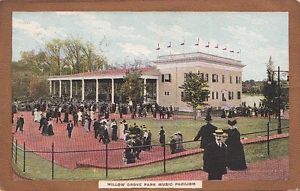
|
| Music Pavilion |
To go back a moment in time, the trolley car was the main method of public transportation in the last half of the 19th Century, blanketing the cities of America and their suburbs, and connecting to the trolley lines of other cities through an interurban network. Somewhere the idea developed of building Amusement Parks out at the far end of suburbs, to attract riders into using the trolleys for more than just commuting; there may have been as many as seventy or eighty such permanent circus grounds in America at one time, with more elaborate attractions that could be managed by traveling circuses. Philadelphia had several such trolley parks, notably Woodside Park in Fairmount Park, serviced by the "Park Trolley". But in 1896 Willow Grove was created on the edge of Abington, far more elaborate than any others, at the intersection of Old York Road and Easton Pike (Rte 611). Its terminal could hold as many as a hundred trolleys at once; the ride from Center City Philadelphia took 70 minutes and cost 15 cents. The area had mineral springs and had long been a favored vacation spot. Horace Trumbauer designed four or five of the buildings, and the Park eventually included a lake with rental boat rides, an arboretum, amusement rides, restaurants, a fun house, silent movie theaters, rodeos, roller coasters, a picnic park, and even an artificial mountain with a slow scenic ride up but a rip-roaring fast descent. By far the most central feature of Willow Grove was the 4000-seat music center, dominated by John Philip Sousa and his band giving four performances a day. Other musical performers were Victor Herbert, Walter Damrosch, Arthur Pryor ("The Whistler and His Dog"). Many of the ideas of Willow Grove are now to be found in the modernized form at Disneyland, but for twenty-five years music under the direction of John Philip Sousa was really the central unifying feature.
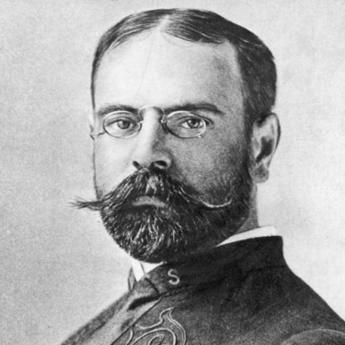
|
| John Philip Sousa |
It's generally held the arrival of radio broadcasting caused the decline of Willow Grove, although "The March King's" immense energy declined toward the end, as he began to enjoy being a multimillionaire. The composition of marches was in fact only a minor part of his musical output, which included among other things 16 full-length Broadway musicals. He was a national champion trap-shooter and a horseman of some note. One arm became nearly useless to him after a fall from his horse. Meyer Davis took over in the last few years, but a major fire pretty well finished the place off just in time to be buffeted by the 1929 crash. There was an attempted resurgence in 1933, but circumstances which made Willow Grove a successful "Virtuoso Solo" just couldn't withstand the competition of the automobile and television, and the land was finally broken up and sold for $3 million in 1976. Remnants of the gilded past are now scattered around the Willow Grove Shopping Mall, for those who wish to renew fond memories from their childhood. Or perhaps their grandparent's childhood.
The Walking Purchase
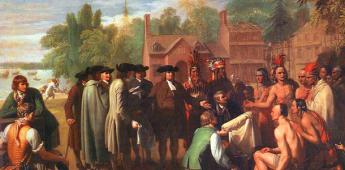
|
| William Penn and the Indians |
Any fair discussion of Quaker relations with the Indians must emphasize that almost all other colonists of the time regarded Indians as subhuman components of the local wilderness. Only William Penn was careful to treat the Indians as fellow human beings, entitled to fair play, dignity, and respect. Like a good politician, he entered into their games with enthusiasm and definitely earned their respect by outdoing them all in the broad jump contests. Even though he had bought the land from King Charles II, he took care to buy it a second time from the Indians, and for many decades was able to enforce the wise rule of never permitting settlers on the land before the Indians agreed to its purchase. After Penn's death, however, and particularly from 1726 to 1736, a major wave of German and Scotch-Irish immigration created an overwhelming population pressure on the seaboard areas, resulting in much unauthorized pioneering and settlement. Since William Penn spent only a few years in the colonies his agents chiefly James Logan, had long set the tone.
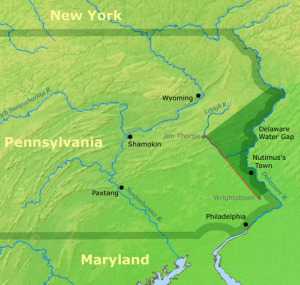
|
| Walking Purchase |
Logan had been equally famous for his many efforts to treat the Indians fairly, and the grounds of Stenton, his manor house, were often filled with Indians come to pay their respects. Against all this evidence of the benign attitudes of both Penn and Logan, there stands the episode of the Walking Purchase of 1737. No doubt about it, the Indians were treated badly.
In the triangle between the Neshaminy Creek and the Delaware River, the Delaware Indians agreed to a sale with the third side of the triangle established at a distance from Wrightstown, as far as a man could walk northward toward the Wind Gap in a day and a half. That was a common form of boundary for Indian land sales, and its distance was fairly well understood. In anticipation of pacing out the distance, the colonists sent out explorers to find the easiest path, then sent out woodsmen to clear a path in the forest, and selected three of the fastest runners in the colony to do the running. The pace was so fast that two of the runners had to drop out, and the third one nearly did so. The resulting boundary was nearly twice as far into the wilderness as was commonly accepted for the measurement, taking advantage of the sharp bend in the river which widened the land in question by a great deal. The Indians were so disgusted they refused to leave the territory. Logan had already made an agreement with the Iroquois nation, to whom the Delawares were subject, and the Delawares only surrendered the land when the Iroquois began to look as though they really would act as enforcers for the bargain. Although serious Indian warfare did not break out for another twenty years, the Walking Purchase went a long way toward convincing the Delaware tribe that the Quakers were no more trustworthy than the settlers in other colonies, and is said to have been on their minds when twenty years later they helped the French decimate General Braddock's army.
There will probably never be a clear resolution of the paradox of Quakers, particularly Logan, behaving in this reprehensible manner within a very long history of the unusually honorable treatment of the Indians. With William Penn now dead and gone, no doubt Logan was caught in a squeeze between the two rather dissolute sons of William Penn, neither of them Quaker, who had over-indebted themselves with high living and were pressing their agent to make land sales to pay for it. Then there was the pressure of the new German and Scotch-Irish immigrants, brought to the New World by real estate promises, and stranded in the seaport unable to complete their land purchases. Under this pressure, Logan may have been unduly persuaded that the 1684 treaties with the Indians, along with many other treaties and understandings, were all the legal justification he needed. Whatever the specifics of the situation at the time, it is now clear the Walking Purchase was a blot on the Quaker record that can never be entirely justified within the Quakers' own standards of fairness. Within the Society of Friends, whatever other English colonists might have done in their position, let alone what French and Spanish regularly did to the Indians, doesn't matter in the slightest.
James A. Michener (1907-1997)
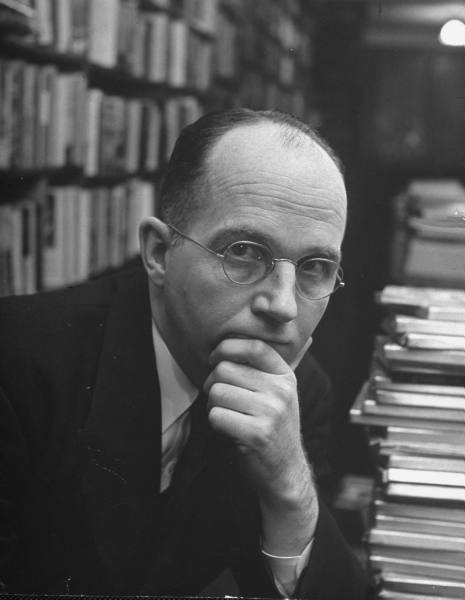
|
| James A. Michener |
James Michener seemed headed for a recognizably Quaker life until show business rearranged his moorings. He was raised as a foundling by Mabel Michener of Doylestown, Pennsylvania, under circumstances that were very plain and poor. Many of his biographers have referred to his boyhood poverty as a defining influence, but they seem to have very little familiarity with Quakers. When the time came, this obviously very bright lad was offered a full scholarship to Swarthmore College, graduated summa cum laude, went on to teach at the George School and Hill Schools after fellowships at the British Museum. And then World War II came along, where he was almost but not exactly a conscientious objector; he enlisted in the Navy with the understanding he would not fight.
While in the Pacific, he had unusual opportunities to see the War from different angles, and wrote little short stories about it. Putting them together, he came back after the War with Tales of the South Pacific. Much of the emphasis was on racial relationships, the Naval Nurse who married a French planter, the upper-class Lieutenant (shades of the Hill School) who had a hopeless affair with a local native girl that was engineered by her ambitious mother, as central characters. Michener himself married a Japanese American, Mari Yoriko Sabusawa, whose family had been interned during the War. There are distinctly Quaker themes running through this story.
And then his book won a Pulitzer Prize, Richard Rodgers and Oscar Hammerstein made it into a Broadway musical hit, then a movie emerged. The simple Quaker life was then struck by the Tsunami of Broadway, Hollywood, show biz and enormous unexpected wealth. Just to imagine this simple Bucks County schoolteacher in the same room with Josh Logan the play doctor is to see the immovable object being tested by the irresistible force. Michener retreated into an impregnable fortress of work. He produced forty books, traveled incessantly, ran for Congress unsuccessfully, and was a member of many national commissions on a remarkably diverse range of topics. Although he lived his life in a simple Doylestown tract house, he gave away more than $100 million to various charities and educational institutions.
In his 91st year, he was on chronic renal dialysis. He finally told the doctors to turn it off.
Doylestown

|
| James Michener |
Caught between the expansion of two metropolitan areas, Bucks County is inevitably doomed to extinction as a culture. Chester County and Bucks are in similar situations, as the suburbia devours exurbia, in this case, the Quaker farm communities. So you better go have a look, while they still survive to some degree.
The political unit of the area has been the county, and the county seat is in Doylestown, population about 8000. Within a few decades, it seems safe to predict the county population will approach a million. The town has lots of pride in itself and is just as cute as any town could possibly be. New Castle, Delaware has been preserved with the same pride but is uniform of a single period of architecture; Doylestown is a carefully preserved jumble of styles and periods, sizes and shapes. Like Princeton, NJ, and Odessa, DE, it is so attractive it brings hordes of visitors, which in turn quickly strangle it with traffic and lack of available parking space. There is an attempt to rescue the town with a by-pass highway, and blessings on the attempt. But the problem for these exurban jewels is not that people want to go around them, the problem is they are the main destination.
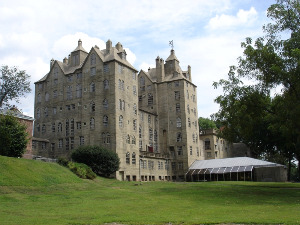
|
| Mercer Museum |
Doylestown was created in 1745 when William Doyle built a tavern at the crossroads. The county seat brings the courthouse with eleven judges and who knows how many lawyers, and the hospital. Henry Chapman Mercer brought three astonishing buildings, his 44-room mansion on 70 acres in the center of town, his famous Mercer tile factory in his back yard, and his multi-story museum of tools and crafts. All three of Mercer's buildings are made of concrete, built by craftsmen and himself with essentially unlimited personal funds derived from fabric manufacture in New England. And then this last bastion of the crafts movement embraced the artist colony established by Redfield at New Hope, and both of them attracted all those rich Broadway stars and publishing moguls. Right in the center of town, the Mercer crafts museum sits across the street from the James A. Michener Art Museum, small but very tasteful, the museum home of the Pennsylvania Impressionist school of art. The essence of this style is a smooth careful background, overlaid with quick thick foreground brushwork, producing a strong three-dimensional effect.
Schoolchildren in buses delight in the dolls house aspects, tourists admire the very fine art, everybody likes the cute little jumble of well-preserved eclectic buildings. It's all in a setting of Quaker farmhouses for the time being, but the split-levels and the McMansions by the thousands are coming. Visitors throng to see, and the residents are proud of what they have. But, really, does everybody have to bring his car?
Broad Street North and South
Following the instructions of William Penn, all of Philadelphia's original numbered streets are laid out by the compass, due North and South. Without getting into a history of how the street names then got modified somewhat, Broad Street by the present system would be 14th Street. Center Square of the original five parks is placed at the intersection of Broad and Market Streets. After a period functioning as the city water-works, the intersection has been occupied by City Hall for over a century. Originally intended to be the tallest building in the world, the tower of City Hall still dominates the landscape in all four directions for a considerable distance. It also stands at the foot of the diagonal Benjamin Franklin Parkway, so City Hall stands like a Parisian intersection rather than the Scotch Irish Diamond it once was. Nevertheless, when you look down the long canyon of each intersecting street, the tower in the middle of the street dominates the view. Let's begin a tour of the whole extent of the longest street in Philadelphia, at the southernmost end of Broad Street, at the Philadelphia Navy Yard.
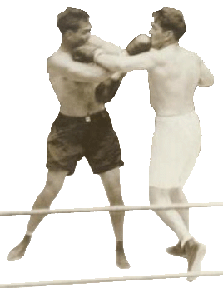
|
| Gene Tunney vs Jack Dempsey |
Although the guard will be happy to tell you it's a dumb regulation, you aren't allowed to take pictures of the Navy Yard, or visit without a pass, in spite of the fact the area of the yard is fast being converted into business properties. A great many of the warships that won our wars were built in this yard, and many rests in a sort of floating Navy graveyard, or mothball fleet, which is best seen from the elevated highway nearby, Interstate 95. The shipyards rest on the filled-in area around Hog Island, home of the hoagie sandwich. Just north of the Navy Yard are several sports stadiums and a great deal of parking space to service them. Much muttering is heard about the tax cost of this stadium farm, whose many-million-dollar facilities are only used for between eight and eighty home games apiece each year. The stadium-sprouting process began with Municipal Stadium which was built for the Dempsey Tunney prize fight, and held 110,000 spectators. In the time it housed the annual Army-Navy football game, but not much else, and has since been demolished. It certainly seemed to be the windiest, coldest place on earth, but that's just a child's recollection. At that time and for many years the area around the stadium was one huge garbage dump, and before that it was a huge swamp, the source of mosquitoes, malaria, typhoid and yellow fever. Fish like to eat mosquitoes, so filling in the South Philadelphia swamp badly injured the seafood industry of Delaware Bay, while admittedly ridding us of Yellow Fever epidemics. The swamp once extended as far as Gray's Ferry where the University of Pennsylvania now looms, with patches of quite rich farmland scattered in the swamp. Stephen Girard had a large farm just to the West of what is now South Broad Street where he cultivated vegetables necessary for the French cooking he favored.
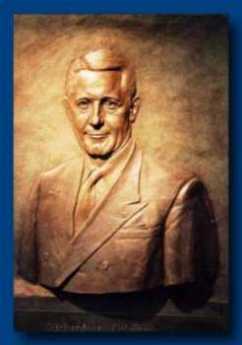
|
| Mayor Richardson Dilworth |
As you drive north on Broad you begin to notice the quaint Philadelphia custom of parking your car in the center of the wide street. Mayor Dilworth once announced this had to stop, but the uproar from local residents forced even this ex-Marine officer to retreat. Down the side-streets a variation is seen; when the local resident drives off, he leaves trash cans in the street, indicating it is private property. Rumor has it that people who ignore the warning can get their windshields smashed with a brick. This area is as urbanized as you can get, but the spirit of the wild, wild West nevertheless prevails.
Pennsbury Manor
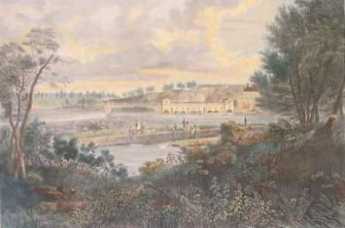
|
| Fairmount |
William Penn once had his pick of the best home sites in three states, because of course he more or less owned all three (states, that is). Aside from Philadelphia townhouses, he first picked Faire Mount, where the Philadelphia Art Museum now stands. For some reason, he gave up that idea and built Pennsbury, his country estate, across the river from what is now Trenton. It's in the crook of a sharp bend in the river but is rather puzzlingly surrounded by what most of us would call swamps. The estate has been elegantly restored and is visited by hosts of visitors, sometimes two thousand in a day. On other days it is deserted, so it's worth telephoning in advance to plan a trip.
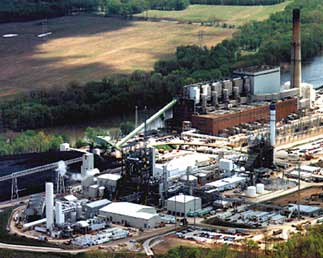
|
| Gasified Garbage |
After World War II, a giant steel plant was placed nearby in Morrisville, thriving on shiploads of iron ore from Labrador, but now closed. Morrisville had a brief flurry of prosperity, now seemingly lost forever. However, as you drive through the area you can see huge recycling and waste disposal plants, and you can tell from the verdant soil heaps that the recycled waste is filling in the swamps. It doesn't take much imagination to foresee swamps turning into lakes surrounded by lawns, on top of which will be many exurban houses. How much of this will be planned communities and how much simply sold off to local developers, surely depends on the decisions of some remote corporate Board of Directors.
However, it's intriguing to imagine the dreams of best-case planners. Radiating from Pennsbury, there are two strips of charming waterfront extending for miles, north to Washingtons Crossing, and West to Bristol. If you arrange for a dozen lakes in the middle of this promontory, surround them with lawns nurtured by recycled waste, you could imagine a resort community, a new city, an upscale exurban paradise, or all three combined. It's sad to think that whether this happens here or on the comparable New Jersey side of the river depends on state taxes. Inevitably, that means that lobbying and corruption will rule the day and the pace of progress.
Meanwhile, take a trip from Washingtons Crossing to Bristol, by way of Pennsbury. It can be done in an hour, plus an extra hour or so to tour Penn's mansion if the school kids aren't there. Add a tour of Bristol to make it a morning, and some tours of the remaining riverbank mansions, to make a day of it.
Lambertville and Lewis Island
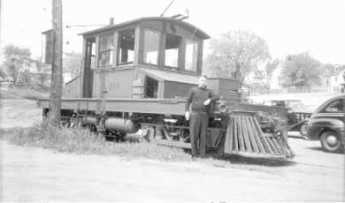 |
| Atlantic Shore Railroad |
Recall that open Atlantic shoreline once stretched from Perth Amboy to New Castle, Delaware. Glaciers pulverized the nearby mountains and dumped a huge moraine of sand into the ocean, creating southern New Jersey as an offshore island in geological times. The bay silted up and eventually attached that island to New Jersey. The silting-up probably would have continued for another sixty miles, making Philadelphia a land-locked inland city, except that the true
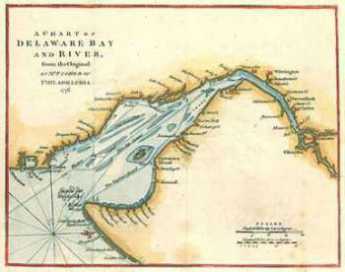 |
| Delaware River |
Delaware River came tumbling down from the mountains to Trenton, turning sharply right and then maintaining an open shallow channel to the sea. From Lambertville to Trenton, the river drops over a series of small falls or rapids, easily visible except when heavy rains "drown" them.
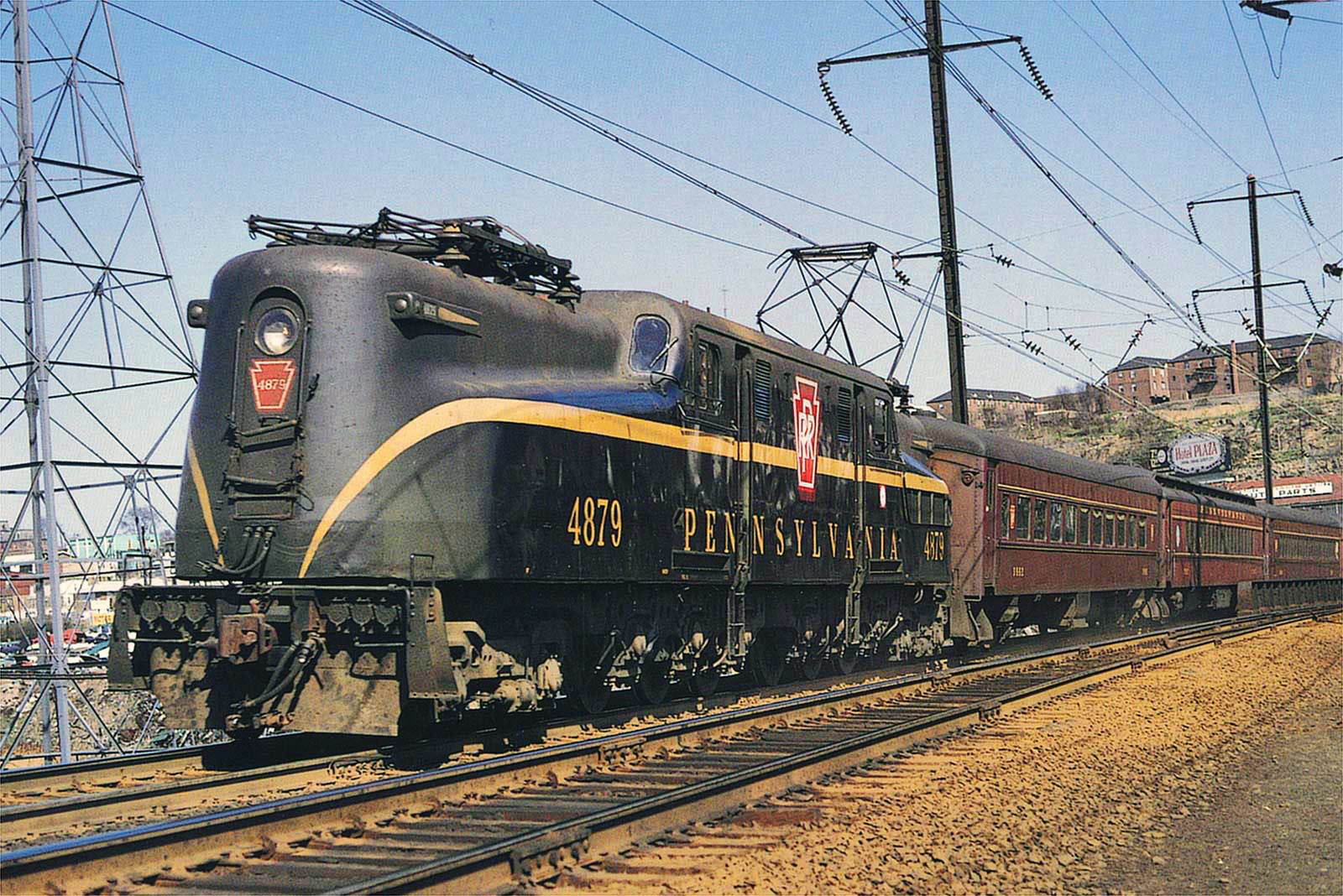 |
| Pennsylvania Railroad |
So, geography accounts for the scenery and early history of the upper end of Delaware Bay. It's still a beautiful hilly countryside with small antique villages, sparsely populated in spite of two nearby cities. Water power at the Fall Line, and then anthracite from the upstate mountains once encouraged early industry in an area that was rather poor farm country. But the Pennsylvania Railroad then rearranged commerce so that a blossoming New Jersey industrial area withered into quaintness. The early railroads mostly all ran East-West along the rivers, since investors in Atlantic port cities obtained both finance and protection from their state legislatures; railroads had almost reached the Mississippi before any were able to establish North-South connecting spurs. A seaboard trunk line was almost impossible to imagine. Finally, a consortium organized by
J.P. Morgan bullied through the main trunk line running through the bituminous coal areas of Pennsylvania and on to the West, with the major port cities connected by the great Northeast Corridor of the Pennsy. This corridor would run on the Pennsylvania side of Delaware. Industry on the bypassed New Jersey side would just wither and decline, and eventually so would the anthracite cities. Since the original colonies and states all ran from the ocean to the interior, each had a vital political interest in resisting this outcome. Only a strong and brutal corporation could bring it off.
When George Washington was circling around Trenton to attack it on Christmas, a narrow spot up-river with a dozen houses on either side was called Coryell's Crossing or Ferry. That's now Coryell Street in Lambertville, linked to the other side of the river at New Hope, after first crossing a narrow wooden bridge to Lewis Island, the center of shad fishing, or at least shad fishing culture.
The Lewis family still has a house on Lewis Island, and they know a lot about shad fishing, entertaining hundreds of visitors to the shad festival in the last week of April. The river is cleaning up its pollution, the shad are coming back, but they, unfortunately, took a vacation in 2006. At the promised hour, a boatload of men with large deltoids attached one end of a dragnet to the shore, rowed to the middle of the river, floated downstream and towed the other end of the net back to the shore. The original anchor end of the net was then lifted and carried downstream to make a loop around the tip of Lewis Island, and then both ends were pulled in to capture the fish. There were fifty or so fish in the net, but only two shad of adequate size; since it was Sunday, the fish were all thrown back.
But it was a nice day, and fun, and the nice Lewis lady who explained things knew a lot. Remember, the center of the river is a border separating two states. You would have to have a fishing license in both states to cross the center of the river with your net; game wardens can come upon you quickly with a power boat. But the nature of fishing with a dragnet from the shore anyway makes it more practical to stop in the middle, where shotguns from the other side are unlikely to reach you. An even more persuasive force for law and order is provided by the fish. Fish like to feed when the sky is overcast, so there is a tendency on a North-South river for the fish to be on the Pennsylvania (West) side of the river in the morning, and the New Jersey (East) side in the evening. During the 19th Century when shad were abundant, work schedules at the local mills and factories were arranged to give the New Jersey workers time off to fish in the afternoon, while Pennsylvania employers delayed the starting time at their factories until morning fishing was over.
Somehow, underneath this tradition one senses a local Quaker somewhere with a scheme to maintain the peace without using force. Right now, there aren't enough fish to justify either stratagem or force, but one can hope.
Helis the Whale

|
| Beluga Whale |
Helis the beluga whale, male, 12 feet long, said to be 30 years old in a species with a life expectancy of about 35, made an appearance in the upper Delaware River in the spring of 2005. A scar on his back was recognized as having been seen on the St. Lawrence River, where Beluga whales are more commonly observed. Needless to say, there was a local sensation, with crowds of whale-watchers along the banks of the river, sharing binoculars, and buying special whale cookies, t-shirts and the like from opportunistic vendors. Helis arrived April 14, 2005, in time to pay income taxes, go to Trenton, cruising Trenton to Burlington and back, eating shad. Experts saying he is happy as a clam, shad fishermen grumbling a little. Crowds of excited people tried to take snapshots of themselves with Helis in the background.
He stayed with us another week, going back and forth between Burlington and Trenton. Not many other events took place, so the newspapers had front-page stories by Beluga whale experts, sought out for fifteen minutes of fame. Will he come back? How big do Belugas get to be? Frantic calls by reporters obtained the information that Belugas like icy arctic waters, seldom travel alone or this far south. The suggestion was made that Helis may have been banished by the male whales he usually swims with, but others pointed out the unusually good shad run this year and conjectured Helis was an adventurous loner who had discovered a private river of goodies.
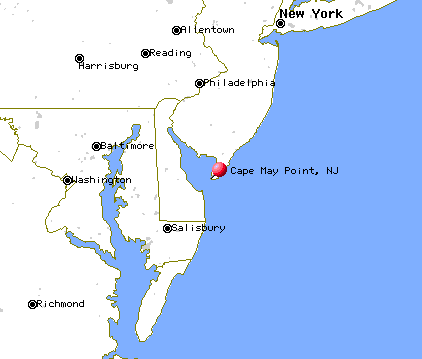
|
| Cape May NJ |
We were informed that lots of whales are sighted off Cape May every year; there's a rather large whale sight-seeing industry. Mammals don't breathe the Delaware pollution, but like other mammalian swimmers, they swallow some. So here's a sign that river pollution maybe can't be too bad.
The French Canadians call him "ee-lus" but don't expect that to catch on around here. What's helis mean, anyway? This seems to be the most southern sighting of a Beluga. Reminds us that Kingston New York, a hundred miles up the Hudson, used to be a big whaling port. that Ahab of Melville's Moby Dick was a Quaker, Nantucket variety. Cape May Quakers are related to them more than to Philadelphia Yearly Meeting. After all, Philadelphians are whale-lovers.
Unless someone harpoons Helis, we are all hoping he will bring back lots of his friends next year. Even the shad fishermen recognize that if the whales are searching for shad, there have to be a lot of shad to be attractive. And the whale-memento industry will surely be ready for them.
Bristol, PA
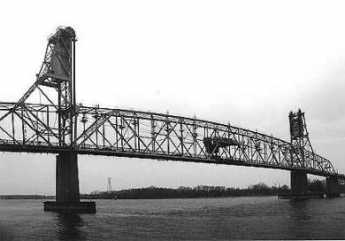
|
| Burlington Bristol Bridge |
In 1681, Samuel Clift activated a local land conveyance, written to go into effect as soon as King Charles II signed the overall land grant to William Penn. In this way, Bristol claims to be the oldest settlement in English Pennsylvania; Clift got here before Penn did. He chose the narrowest spot in the river as an excellent place to run a ferry which was only replaced by the Burlington Bristol Bridge in 1930. A ferry landing is an excellent place for an Inn, which he also built there. The town he founded was called Buckingham, and the surrounding county became Buckinghamshire, Bucks for short. The name later changed to Bristol. The New Jersey town on the other end of the ferry ride was called Bridlington, later Burlington. North of this narrow spot in the river was a several-mile extent of marsh and swampy inlets, and then the river turns abruptly northwest at what used to be called the falls at Trenton.
William Penn had considered building his house sixty miles south of there at the Southern end of Philadelphia Bay, at Chester, then pondered building it on the Faire Mount where the Philadelphia Art Museum now overlooks the Schuylkill. In the end, he built a Philadelphia house near Dock Creek (subsequently covered over and renamed Dock Street) and a palatial manor house, Pennsbury, in the swampy marshes above Bristol, where a tourist visit is now a valuable experience.
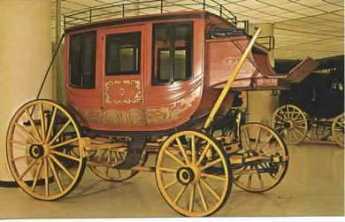
|
| Stagecoach |
No doubt being near the Proprietor's estate gave Bristol some class, but it was also half-way on a two-day stagecoach ride from Philadelphia to New York. A succession of inns and resorts grew up in Bristol, and it became a busy transshipment place, a good place to build schooners. A local Captain John Cleve Green is celebrated as first to carry the American flag to China, although it must be admitted his cargo included opium; Green is regarded as the financial founder of the nearby Lawrenceville School. The terminus of the Delaware canal brought coal from the anthracite region in 1827; more prosperity ensued as coal was loaded on ships in Delaware, or utilized instead of water power for the Bristol Mills which had been founded by Samuel Carpenter in 1701. John Fitch invented the first steamboat and tried it out here; more prosperity ensued, although not for poor Fitch, who committed suicide. Little Bristol gradually filled up with imposing waterfront mansions, the declining shells of which can still be admired.
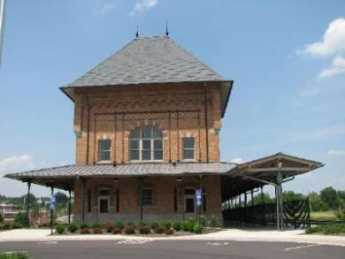
|
| Bristol Railroad |
The advent of the railroad isolated Bristol when it cut off the corner of the bend in the Delaware River. Four-lane highways eventually consolidated the isolation of the little river town, but the turning point was around the time of the Civil War. For nearly a century, between the Revolution and the Civil War, Bristol was the booming little queen of northern Philadelphia Bay, and the Bay itself was an American Lake Como, lined with Federalist and Victorian mansions, their lawns sweeping down to the water's edge. Small wonder there was so much social interaction between the railroad-isolated Bristol, and planters of Chesapeake Bay. The strip of quiet charm begins at Pennsbury Manor and pretty continuously extends to Bristol, where you can go under the rail embankment and on to Philadelphia, or alternatively cross the Burlington Bristol Bridge to New Jersey. A couple of miles further south, the river edge is a little ragged but includes some yacht clubs and several famous mansions, notably Nicholas Biddle's Andalusia, the Foerderer family's Glen Ford, and the former mansion of Saint Katherine Drexel.
The Bristol area has had moments of fame. George Washington had originally planned to attack Trenton from both the north and the south simultaneously. He came over what is now called Washington's Crossing amid the ice floes on the north side of the Pennsbury delta, and General Cadwalader was to cross Delaware at Bristol, on the south side of the marshes. As it turned out, the ice was worse at Bristol and the river wider, so Cadwalader was late for Trenton but caught up with Washington to help with the battle at Princeton. President Tyler's daughter married a dashing gentleman from Bristol. Republican politicians from Bristol teamed up with some others in West Chester to decide that favorite-son Seward couldn't win, so they backed Abraham Lincoln for the presidential nomination, and Pennsylvania was therefore in time richly rewarded for its political acumen. Despite the arts and crafts group that moved in around New Hope PA, Bucks County has remained a Republican stronghold ever since. The region's influence was long symbolized by Joseph P. Grundy, the gentle Quaker manufacturer from Bristol whose name struck terror in Republican politicians as well as Democrat ones, but for opposite reasons.
The Burlington Bristol Bridge is now getting a little narrow and ancient, but is still serviceable. It long charged only a dime's toll because that was enough for painting and upkeep. Together with the Tacony Palmyra Bridge, which charged the same low toll, these locally owned bridges stuck a thumb in the eye of the tax-and-spend folks who owned the Philadelphia bridges and who wanted to charge three dollars toll, spending most of it on non-bridge activities. As Tacony Palmyra Bridge rests on both sides of the river, the local politics gradually shifted enough to permit a restoration of toll "equity".
Washington Lurks in Bucks County, Waiting for Howe to Make a Move
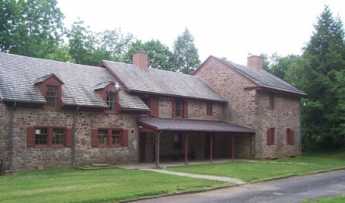
|
| Moland House |
Although Bucks County, Pennsylvania, is staunchly Republican, it has been home to Broadway playwrights for decades; this handful of Democrats have long been referred to as lions in a den of Daniels. One of them really ought to make a comic play out of the two weeks in August 1777, when John Moland's house in Warwick Township was the headquarters of the Continental Army.
John Moland died in 1762, but his personality hovered over his house for many years. He was a lawyer, trained at the Inner Temple and thus one of the few lawyers in American who had gone to law school. He is best known today as the mentor for John Dickinson, the author of the Articles of Confederation. Our playwright might note that Dickinson played a strong role in the Declaration of Independence, but then refused to sign it. Moland, for his part, stipulated in his will that his wife would be the life tenant of his house, provided -- that she never speak to his eldest son.
Enter George Washington on horseback, dithering about the plans of the Howe brothers, accompanied by seven generals of fame, and twenty-six mounted bodyguards. Mrs. Moland made him sleep on the floor with the rest.
Enter a messenger; Lord Howe's fleet had been sighted off Patuxent, Maryland. Washington declared it was a feint, and Howe would soon turn around and join Burgoyne on the Hudson River. Washington had his usual bottle of Madeira with supper.
A court-martial was held for "Light Horse Harry" Lee, for cowardice. Lee was exonerated.
Kasimir Pulaski made himself known to the General, offering a letter of introduction from Benjamin Franklin, which letters Franklin noted had been requested by Pulaski himself. As it turned out, Pulaski subsequently distinguished himself as the father of the American cavalry and was killed at the Battle of Savannah.
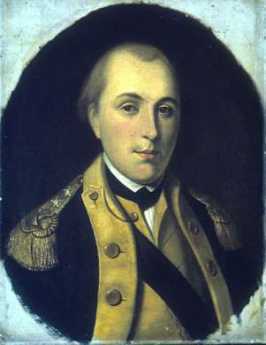
|
| Lafayette |
And then a 19 year-old French aristocrat, the Marquis de Lafayette, made an appearance. Unable to speak a word of English, he nevertheless made it clear that he expected to be made a Major General in spite of having zero battlefield experience. He presented a letter from Silas Deane, in spite of Washington having complained he was tired of Ambassadors in Paris sending a stream of unqualified fortune hunters to pester the fighting army. Deane did, however, manage to make it clear that the Marquis had two unusually strong military credentials. He was immensely rich, and he was a dancing partner, ahem, of Marie Antoinette.
In Mrs. Moland's parlor, Washington sat down with Lafayette to tap-dance around his new diplomatic problem. It was clear America needed France as an ally, and particularly needed money to buy supplies. But it was also clearly impossible to take a regiment away from some American general, a veteran of real fighting, and give that regiment to a Frenchman who could not speak English and who admitted he had no military experience. Fumbling around, Washington offered him the title of Major General, but without any soldiers under his command, at least until later when his English improved. To sweeten it a little, Washington seems to have said something to the effect that Lafayette should think of Washington as talking to him as if he were his father. There, that should do it.
It seems just barely possible that Lafayette misunderstood the words. At any rate, he promptly wrote everybody he knew -- and he knew lots of important people -- that he was the adopted son of George Washington.
Well, Broadway, you take it from there. At about that moment, another messenger arrived, announcing Lord Howe at this moment was unloading troops at Elkton, Maryland. General Howe might have been able to present his credentials to Moland House in person, except that his horses were nearly crippled from spending three weeks in the hold of a ship and needed time to recover. Heavy rains were coming.
(Exunt Omnes).
Suggested Stage Manager: Warren Williams
George Washington Defends Philadelphia in New Jersey
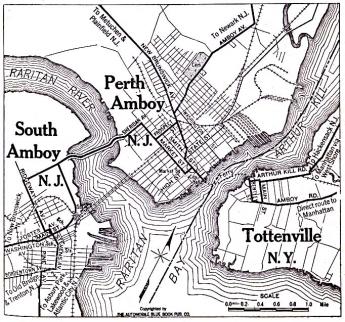
|
| Perth Amboy Map |
Not everyone would think of the New Jersey town of Perth Amboy as part of Philadelphia history or culture, but it certainly was so in colonial times. Sadly, the town is now somewhat run-down.
To understand the strategic importance of Perth Amboy to Colonial America, remember that King James thought of New Jersey as the land between the North (Hudson) River and the South (Delaware) River. This land has a narrow pinched waist in the middle. New York Bay pinches on one side, Perth Amboy marking the deepest penetration of that pinch on the East. The Western pinch is from Delaware Bay, which has a sharp angle at Trenton marked by waterfall rapids in Colonial times, where the Delaware River makes an abrupt turn from Easterly to Northwesterly. Quite naturally in the Nineteenth Century, a canal was eventually constructed along this narrow waist between two large bays, and it is easy to see why the Seventeenth Century regarded the connecting strip of land as the likely future site of important political and commercial development. The two large and dissimilar land masses adjoining this strip -- sandy South Jersey, and mountainous North Jersey -- were sparsely inhabited and largely ignored in colonial times.
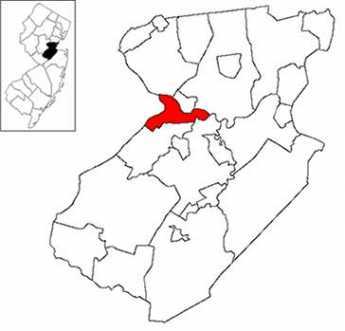
|
| New Brunswick |
The name, Perth Amboy, is modified from local Indian word with the Perth part reflecting that East Jersey was primarily settled by Scottish Quakers. Like Pittsburgh at the conjunction of three rivers, Perth Amboy's local importance was that it sits at the mouth of the Raritan Bay extension of the Raritan River as it empties into New York Bay, just inside Sandy Hook. The second "river" of the fork is really just a channel between New Jersey and Staten Island. Viewed from the sea, Perth Amboy sits on a bluff, commanding that junction. (Staten Island, in a sense, here seems more naturally a part of New Jersey than New York). Amboy was the original ocean port in the area, soon overtaken by New Brunswick further upriver, as increasing commerce required safer harbors. It was the capital of East Jersey, and then the first capital of New Jersey after East and West Jersey were joined in 1704. The Royal Governor's mansion still stands there in much reduced circumstance. The grand houses of the Proprietors and Judges overlooked the banks of the bay. The last Royal Governor was William Franklin, an illegitimate son of our Benjamin. When Benjamin was stationed in London as a representative of Pennsylvania and Massachusetts, the appointment of William to a plush job in the colonies was just the normal method of government, made somewhat shabbier by King George III. Urged on to be a really King-like King by his mother, George III had considerably expanded the system of buying the loyalty of important people by giving them jobs and favors. Where people were already rich and powerful, they were offered monopolies and protective tariffs in return for their loyalty, and irritation at such intrusions into the trade was to be a main incitement of the American Revolution. William and Benjamin eventually had a permanent falling-out over political matters, and naturally American historians take the side of the father. However, it would appear that William was in fact a very good governor, a charming and diplomatic person, who used his considerable talents to smooth over the local conflicts between his King and his neighbors. Even after hostilities broke out and the rebels took over the government, William Franklin stayed on trying to calm things down, instead of fleeing behind the British lines as most Loyalists tended to do. His reward was to be packed off to confinement in Connecticut.
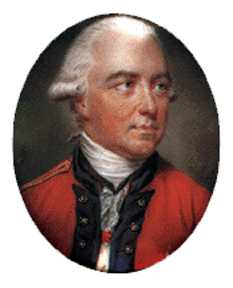
|
| Sir Henry Clinton |
Speaking geologically, the Raritan River is a little trickle running along the path of what was once the northern entrance to Delaware Bay. In prehistoric days, southern New Jersey was a sandy barrier island, but the gap gradually filled in along the route from Perth Amboy to Trenton, leaving sheltered harbors at both ends of a strip of unusually fine farmland attractive to early settlers. By the time of the Revolution, the strip was comfortably settled by rich farmers who tended to favor the Loyalist cause, while the pine barrens to the South and the hilly woods to the North were inhabited by newer immigrants who tended to be poor and hence favored the rebel cause. In his autobiography, Benjamin Franklin relates how, a boy, he came from Boston to Philadelphia by coming down from Perth Amboy (the capital of East Jersey) to Trenton and nearby Burlington (the capital of West Jersey), and then down Delaware to Philadelphia. Later on, Washington was to retreat down the same path from his defeats in New York, hotly pursued by the British. After the battle of Trenton, Washington promptly chased the British back up the Raritan to New Brunswick and Perth Amboy and bottled them up there by establishing winter quarters in Morristown. Much later, when the British General Henry Clinton later abandoned Philadelphia, which General Howe had captured by coming in the back door from the Chesapeake, the British marched back up the same Raritan waist of New Jersey by first crossing the Delaware to Haddonfield, up the king's Highway to Trenton/Burlington, and then East to New Brunswick and the British fleet. This was the main highway of the middle colonies, and the persisting term "King's Highway" was once completely appropriate.
When considering the relationships between New Jersey's Raritan Strip and Philadelphia in later decades, the names of Aaron Burr, Thomas Edison, Albert Einstein, Robert Oppenheimer, Doris Duke, and Charles Lindbergh come up, along with a number of others whose tales need retelling. College football was invented in a game between Rutgers and Princeton, eighteen miles apart, and Woodrow Wilson started the movement to put an end to college fraternities, called eating clubs at Princeton. But the strip itself seems to have been glorified only by Thornton Wilder.
A short play called A Happy Journey To Trenton and Camden has been a favorite production by the drama societies of Rutgers, Princeton and Lawrenceville for almost a century. As written by Wilder during the time when he was a school teacher at Lawrenceville, the occupants of a Model T rattle and bump along the strip, commenting on the passing scene. Both the play and the strip deserve more attention than they usually get.
Howe's Choice: To Philadelphia, or Saratoga?

|
| General Howe |
Nations at war traditionally vilify the leader of the enemy, and so Sir William Howe has usually been portrayed as a lazy, illegitimate uncle of the King, a womanizer lacking in military savvy, and a former parliamentary member of the minority party supporting peace with the colonies. But to go on this way is quite unfair to Washington, who outfoxed and out-generaled a tough and very clever soldier who was by no means a pushover, and who fought hard to win.
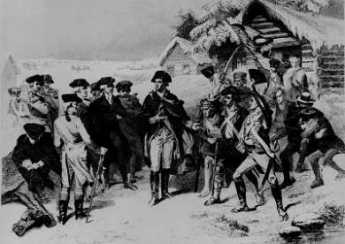
|
| Winter 1777 |
In retrospect, it can be seen that Howe's army was crammed into winter quarters on the Perth Amboy-New Brunswick bluff across the river from Staten Island in the winter of 1777, following the defeat at Trenton. Washington's troops were meanwhile in a fairly impregnable position around Morristown. If Howe went back along the Raritan toward Trenton and Philadelphia, he could expect to be butchered by snipers behind trees. If he embarked on his ships, he would be vulnerable during the two days of so required to break camp and load the ships. Washington's problem was actually just as bad. He had no way of knowing whether he had to defend against an encircling movement at Morristown, against a renewed invasion toward Trenton and Philadelphia, or against a quick movement at sea by the battleships. If Howe embarked, he might be going to Albany to rescue Burgoyne, or to Fort Lee to encircle Morristown, or to Philadelphia, or even to Charlestown. Anyone of these choices would mean that Washington would have to hurry overland to catch him.
It now seems clear that Howe had decided it was safe to abandon Burgoyne. He might have tried to capture Philadelphia and get back to Albany by September, but evidently, this seemed too ambitious and fraught with unexpected accidents, as events later proved to be true. Clear and unambiguous orders by Lord Germain in London were mislaid and never reached him. By implication, he was being told to use his best judgment. So he decided on a double option. He would send sorties out in all directions to keep Washington guessing and to entice him to come down from his mountain fastness into a pitched battle with British regulars. Failing that, he would get on his ships and take Philadelphia. Furthermore, Howe never told another soul what his plans were, except by sending a spy with misleading plans sewed into his coat, intending for him to be captured by the rebels. Washington, however, essentially refused to budge.
Finally, Howe ordered an embarkation onto his ships, and actually loaded a contingent of Hessians on board. Although Washington was mistrustful of a trick, his officers persuaded him to attack the "vulnerable" British while they were loading onto the transports. As soon as Howe heard of Washington's movement he immediately issued orders to turn the whole army around and trap Washington. He thought he now had his chance to catch and destroy the Continental army.
As things turned out, it didn't work and Washington escaped with most of his troops. Fearful of another such trap, he then held back perhaps too long and helplessly watched the ships load, weigh anchor, and sail out to sea. Where were they going? Not another person on the British (or Loyalist) side knew the answer, and the ships were far out to sea, invisible before they turned in whatever direction they were going. Was it North, or South?
A week later, word came to Washington that the fleet had been sighted off the mouth of Delaware. It was time to move South, in a big hurry, on foot. Howe was going to go to Norfolk, but it wasn't even certain whether he was coming back up the Chesapeake, or going still further South to Charleston. It remained conceivable that he would wait for Washington to move his troops South, then double back to New York and Albany to Join Burgoyne.
As we now know, Howe did turn up the Chesapeake to land in the rear of Philadelphia. And then Washington also guessed right and lined up his troops at Chadds Ford of the Brandywine Creek. Both of them were shrewd and very quick. Howe had won a major victory with superior resources. But as we shall see, Washington wasn't through with him.
REFERENCES
| The Uncertain Revolution: Washington and the Continental Army at Morristown: John T. Cunningham: ISBN-13: 978-1593220280 | Amazon |
Tales of the Troop
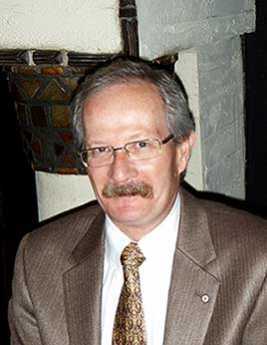 |
| Dennis Boylan |
Dennis Boylan, the former commander of the First Troop, Philadelphia City Cavalry, has been poking around in the archives up at the Armory, and was invited to tell the Right Angle Club about it. In all its history, there have only been 2500 members of the troop, but they have been a colorful lot, leaving lots of history in bits and pieces. The troop boasts that it has seen active duty in every armed conflict of America, and means to continue to fight as a unit of the Pennsylvania National Guard. However, we have lately had so many actions, the troop has had to split off units to be able to go to the Sinai Peninsula, Bosnia, Kosovo, Iraq, Afghanistan and whatever is going to come next. An eighteen month tour of active duty takes a lot out of a citizen soldier's life, but no one is complaining, and there is no fall-off in volunteers.
Although most troopers are polite and taciturn, it is probably hard to remain unaffected by association with people like A.J. Drexel Biddle, a pioneer of the bayonet and hand-to-hand fighting, much sought after for training other units of the military. Or George C.Thomas, who was a golf course architect, but also a seaplane expert, responsible for the seaplane ramps next to the Corinthian Yacht Club along Delaware. Or Rodman Wannamaker, responsible for aeronautic development, also down in the marshes where the Schuylkill joins Delaware. Robert Glendinning, who was notable for other adventures, was also an early pioneer in airplanes. As a matter of fact, Henry Watt had himself flown from Society Hill to Wall Street in a seaplane, when he was President of the New York Stock Exchange.
It's hard to believe, but a former trooper named Eadweard Muybridge distinguished himself in the art world, as a result of a bet with Leland Stopford, that a horse at a gallop reaches a point where all four feet are simultaneously off the ground. The consequence was a famous set of rapid-sequence photographs which are quite famous at the Pennsylvania Academy of Fine Arts. There are elephants, horses, people in various states of undress which remain as interesting artworks as well as scientific evidence that horses feet do indeed leave the ground. But in case anyone believes that Muybridge was some sort of sissy from the art world, there is the story that he caught his wife in an affair and shot the other man dead. As one might expect, the jury found him not guilty, on the grounds of justifiable homicide. With a name like Eadwaerd, it's probably necessary to demonstrate your manliness.
Robert Glendinning, class of 1888 at Penn, became Governor of the New York Stock Exchange, founded Chestnut Hill Hospital and the Philadelphia School for the Deaf. And Thomas Leiper makes a pretty good claim for starting the first railroad in America. It was only 2 miles long, in Swarthmore, and built because he was not permitted to extend his canal for the purpose of transporting stone from upstate quarries. The railroad developed into the Pennsylvania Railroad; Leiper's house, "Strathaven" is still an important Delaware County landmark.
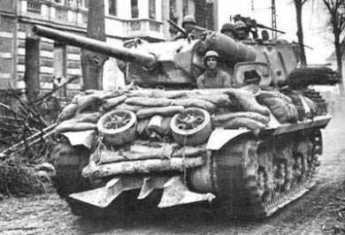 |
| Tank in Philadelphia |
And then, there's the story of the salute to the QE2. When the liner made a tour up the Delaware, a search was made for cannons to provide a proper salute, and the call came to the Troop. Well, they had a tank, and they could fit a simulator on the tank's gun. So, the tank rumbled down Broad street to do its duty. South Philadelphia responded in character, too. Instead of stopping to admire the novelty of a moving tank, the drivers just honked their horns and drove around it.
Camden NJ: The Third, or Irish, Tenth
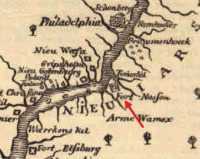
|
| Camden in 1662 |
The early Swedish and Dutch settlers tended to sail up the Delaware Bay, and settle on the right-hand bank, which we now call New Jersey. In time, Seventeenth-century settlers, even William Penn, switched over to the left, or Pennsylvania, side. The Dutch, who had experience with dikes on the Zuider Zee, knew that it was quicker and easier to drain the lowlands than to chop down big trees and dig up the roots. Although the Dutch were more interested in fur trading than agriculture, they had to eat. Fish, crabs, oysters and truck gardens were enough for that purpose. After establishing a Fort Nassau at what is now the town of Gloucester, on the south edge of Camden, fur trading on the New Jersey side began to fall off, and the Dutch settlement was moved across the river as Fort Casimir, next to the mouth of the hidden river, the Schuylkill, just south of what is now the international airport. That was fine for the Dutch to stay close to their ships, but the Indians on the far side of the swamp resisted coming down the swampy river and held back to do their fur trading at Gray's Landing, on the high ground between Bartram's Gardens and the University of Pennsylvania. For the Dutch it was a pleasant paddle up from the mouth of the river at Fort Casimir, and anyway you never know about strangers.
William Penn followed the same path, buying and reselling farmland in New Jersey for a decade before he asked for, and King Charles gave him, Pennsylvania. Skipping many of the details, northern New Jersey, called East Jersey, was given to Scottish Quakers, while what we call South Jersey and they called West Jersey, was divided into ten parts among the English Quakers. The Third Tenth around the Cooper River roughly corresponds to Camden County, and was mainly purchased by Irish Quakers and for a while was called the "Irish Tenth". In time, Gloucester County was split off from Camden County, which was mainly known originally as Newton Township. After a century, the Irish origins of the local inhabitants of Newton and Haddonfield were largely forgotten. The town of Gloucester, however, was situated on the river next to what was to be the vast shipyards of New York Shipbuilding Corp.(1899-1967). First addressing the oak forests of West Jersey for the masts of sailing ships, sailing ships were built with lumber logs floated down the Susquehanna River in rafts during the Nineteenth century. This industry attracted later Irish immigrants during the time of the great Irish migrations, and still more were attracted when World War I made Camden a major steamship building center. The experience was repeated during World War II, reaching its eventual high point when the nuclear Aircraft carrier Eisenhower could be seen under construction by commuters going over the Walt Whitman Bridge.
Shipbuilding, like other heavy industry of the rust belt, moved abroad seeking cheaper labor, and what little remained on American soil moved to Norfolk, Virginia. The response of protectionist legislation made America even less attractive for unionized industry. The wiser workers saw what was happening and sought jobs in other industries, elsewhere. But Gloucester City, underneath the bridge girders and surrounded by winding creeks, held out as an oasis of working-class Irish as the southern anchor of crumbling, decaying Camden. About a thousand homes had been built by the federal government during the labor shortages of World War I, as Fairview. These two little Irish enclaves, 97% Caucasian, continue to hold out for a day that will likely never return, gathering in their taverns to sing songs about old martyrs, fighting to maintain control of the industrial unions, and dominating the Democrat politics of the county. There was a time when leverage might have established political control of South Jersey, and through that to the domination of the whole state, but that gets progressively less likely. Tough politics essentially met more than its match in the river towns of North Jersey, other groups learned to play the ethnic game, and the recent uproar about child molestation has loosened the hold of their church on young adherents with school children. The same pattern seems to be emerging on the Pennsylvania side of the river in Delaware County, where however the political machine has historically been Republican.
Meanwhile, just a little to the north, the city of Camden steadily decays and deteriorates. Now only half the size of its 125,000 "Citadel of Republicanism" in 1950, the title of America's poorest city is applied to an average income of $18,000, and various statistics of violent crime make it the first or second most dangerous place in America to live. The City is 53% black, 29% of Puerto Rican origin, and 44% below the official poverty level. In 2001, its Mayor was sent to jail as an affiliate of the Mafia, and the state took over the running of the city. In 2009, a state auditor reported that the books were in such chaotic condition that it was impossible to say where they stood, financially. Along the way to this sorry state, RCA Victor (1901-1986) finally moved out, after decades of watching its employees migrate to the suburbs, taking their tax revenue with them. Although Campbell Soup loyally maintains and is even expanding its national headquarters in Camden, the soup is made elsewhere. Frozen chicken dinners are made by the hundreds of thousands in Delaware, assembling the tinfoil, chickens, and peas from hundreds of miles to the moment when it is packaged mechanically in a manner that would shame the Japanese. There was a time in living memory when truckloads of Jersey tomatoes were lined up at the Camden soup factory for miles, but all that has moved to California. Jersey tomatoes ripened sequentially throughout the season, requiring human tomato pickers to tell green ones from red ones. A new form of hybrid tomato ripens all the fruit simultaneously, allowing it to be mechanically harvested, and taking advantage of three crops a year in California. The Golden State on our western coast seems to be having labor and tax trouble, too; but that is small comfort to Camden.
As factories close, people abandon their homes, slums result. The schools deteriorate, migration and crime increase. Most people would say it is a mess. A recent sociological study, called Camden After the Fall describes in painful detail how every idea anyone has ever had about how to turn Camden around -- has been tried, amply funded and found to be an utter and discouraging failure. The highway system has been modernized, only to allow commuters to buzz through Camden somewhat faster. Public buildings have been built, only to underline the fact that no new construction has taken place with private money in decades. Building a prison in the center of town created jobs, and now more jobs are being created to tear it down. Rutgers, the state university, has a branch under the shadow of the Ben Franklin Bridge. The battleship New Jersey is at anchor in a lovely riverside park, there's a nice little minor league baseball park. Anything you can build with tax money has been built. There's just no private industry, or business, or profession. Anyone who has a bright idea is welcome to read Camden After the Fall . It's just possible something to try has been overlooked, though it isn't very likely. Except for law, order and good schools.
After decades of watching Camden get steadily worse as I commuted hastily through it, I would say there actually is sort of a plan visible. As houses decay, they are torn down, and the grass is planted. It seems likely that the plan is to wait until a large enough plot of land is cleared and planted to grass, so it eventually becomes attractive to a developer. And then the developer will make tons of money with raw land that even the Indians in 1640 could see was very well situated.
Philadelphia City-County Consolidation of 1854
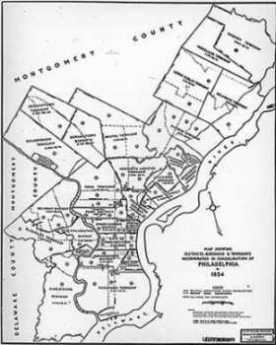
|
| Consolidation Map 1854 |
Philadelphia is still referred to as a city of neighborhoods. Prior to 1854, most of those neighborhoods were towns, boroughs, and townships, until the Act of City-County Consolidation merged them all into a countywide city. It was a time of tumultuous growth, with the city population growing from 120,000 to over 500,000 between the 1850 and 1860 census. There can be little doubt that disorderly growth was disruptive for both local loyalties and the ability of the small jurisdictions to cope with their problems, making consolidation politically much more achievable. A century later, there were still two hundred farms left in the county which was otherwise completely urbanized and industrialized. For seventy-five years, Philadelphia had the only major urban Republican political machine. By 1900 (and by using some carefully chosen definitions) it was possible to claim that Philadelphia was the richest city in the world, although this dizzy growth came to an abrupt end with the 1929 stock market crash, and the population of Philadelphia now shrinks every year. In answering the question of whether consolidation with the suburbs was a good thing or a bad thing, it was clearly a good thing. But since Philadelphia is suffering from decline, it becomes legitimate to ask whether its political boundaries might now be too large.
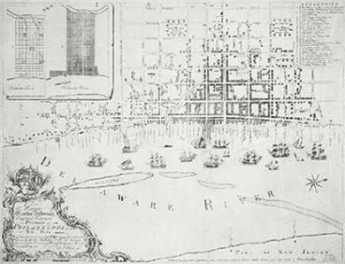
|
| Philadelphia Map 1762 |
The possible legitimacy of this suggestion is easily demonstrated by a train trip from New York to Washington. The borders of the city on both the north and the south are quickly noticed out the train window, as the place where prosperity ends and slums abruptly begin. In 1854 it was just the other way around, just as is still the case in many European cities like Paris and Madrid. But as the train gets closer to the station in the center of the city, it can also be noticed that the slums of the decaying city do not spread out from a rotten core. Center City reappears as a shining city on a hill, surrounded by a wide band of decay. The dynamic thrusting city once grew out to its political border, and then when population shrank, left a wide ring of abandonment. It had outgrown its blood supply. Prohibitively high gasoline taxes in Europe inhibit the American phenomenon of commuter suburbs. The economic advantage of cheap land overcomes the cost of building high-rise apartments upward, but there is some level of gasoline taxation which overcomes that advantage. Without meaning to impute duplicitous motives to anyone, it really is another legitimate question whether some current "green" environmental concerns might have some urban-suburban real estate competition mixed with concern about global warming. Let's skip hurriedly past that inflammatory observation, however, because the thought before us is not whether to manipulate gas taxes, but whether it might be useful to help post-industrial cities by contracting their political borders.
Before reaching that conclusion, however, it seems worthwhile to clarify the post-industrial concept. America certainly does have a rust belt of dying cities once centered on "heavy" industry which has now largely migrated abroad to underdeveloped nations. But while it is true that our national balance of trade shows weakness trying to export as much as we import, it is not true at all that we manufacture less than we once did. Rather, manufacturing productivity has increased so substantially that we actually manufacture more goods, but we do it with less manpower and less pollution, too. The productivity revolution is even more advanced in agriculture, which once was the main activity of everyone, but now employs less than 2% of the working population. This is not a quibble or a digression; it is mentioned in order to forestall any idea that cities would resume outward physical growth if only we could manipulate tariffs or monetary exchange rates or elect more protectionist politicians to Congress. Projecting demographics and economics into the far future, the physical diameters of most American cities are unlikely to widen, more likely to shrink. If other cities repeat the Philadelphia pattern, the vacant land for easy exploitation lies in the ruined band of property within the present political boundaries of cities, or if you please, between the prosperous urban center and the prosperous suburban ring.
Many American cities with populations of about 500,000 do need more room to grow, so let them do it just as Philadelphia did a century ago, by annexing suburbs. But there are other cities which have lost at least 500,000 population and thus have available low-cost low-tax land which would mostly enhance the neighborhood if existing structures were leveled to the ground. Curiously, both the shrunken urban core and the bumptious thriving suburbs could compete better for redeveloping this urban desert if the obstacles, mostly political and emotional, of the political boundary, could be more easily modified. But that's also just a political problem, and not necessarily an unsolvable one.
The Wyoming Massacre of July 3, 1778
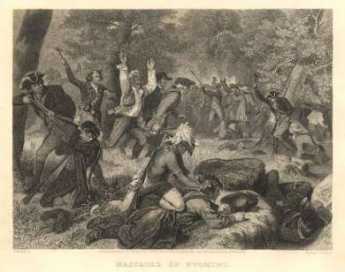
|
| The Wyoming Massacre |
The six nations of Iroquois dominated Northeastern America by the same means the Incas dominated Peru -- commanding the headwaters of several rivers, the Hudson, the Delaware, and the Susquehanna, as well as the long finger lakes of New York, leading like rivers toward Lakes Ontario and Erie. They were thus able to strike quickly by canoe over a large territory. Iroquois were quite loyal to the British because of the efforts of Sir William Johnson, who settled among them and helped them advance to quite a sophisticated civilization. It even seems likely that another fifty years of peace would have brought them to an approximately western level of culture. Aside from Johnson, who was treated as almost a God, their leader was a Dartmouth graduate named Brant.
Brant, The Noble Savage
The mixed nature of the Iroquois is illustrated by the fact, on the one hand, that Sachem Brant translated the Bible into Mohawk and traveled in England raising money for his church. On the other hand, his biographers trouble to praise him for never killing women and children with his own hands. British loyalty to these fierce but promising pupils was one of the main reasons for the 1768 proclamation forbidding colonist settlement to the West of what we now call the Appalachian Trail, which on the other hand was itself one of the main grievances of the rebellious land-speculating colonists. The Indians, for their part, saw the proclamation line as their last hope for survival. After Burgoyne's defeat at Saratoga, the Indian allies were free to, and probably urged to, attack Wyoming Valley.
It is now politically incorrect to dwell on Indian massacres, but this one was both exceptionally savage, and very close to home. The Iroquois set about systematically exterminating the rather large Connecticut sub-colony and came pretty close to doing so. Children were thrown into bonfires, women were systematically scalped and butchered. The common soldiers who survived were forced to lie on a flat rock while Queen Esther, "a squaw of political prominence, passed around the circle singing a war-song and dashing out their brains." That was for common soldiers. The officers were singled out and shot in the thigh bone so they would be available to be tortured to death after the battle. The Wyoming Massacre was a hideous event, by any standard, and it went on for days afterward, as fugitives were hunted down and outlying settlements burned to the ground.
It's pretty hard to defend a massacre of this degree of savagery, but the Indians did have a point. They quite rightly saw that white settler penetration of the Proclamation Line would inevitably lead to more penetration, and eventually to the total loss of their homeland. The defeat of a whole British Army under Burgoyne showed them that they were all alone. It was do or die, now or never. Countless other civilizations have been extinguished by provoking a remorseless revenge in preference to a meek surrender.
Houses of the Penn Family
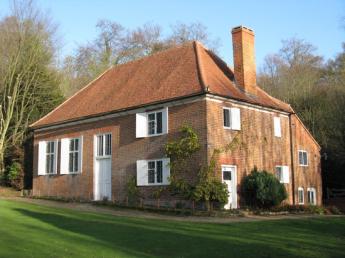
|
| Jordan Meetinghouse |
The name Penn seems to be derived from the Welsh name for hill; hills are abundant in Wales. There is a reason to suppose the family was of royal descent. William's birthplace is now disputed, possibly in London near the Tower, possibly in Ireland at Sharry Estate, possibly the Church of All Hallows, Barking, England. Much better known and much-visited is Jordans, the place where he is buried in the simple buying ground of the Jordans Meeting House in Buckinghamshire, on a by-road running between Chalfont St. Peter and Beaconsfield. The present grave markers were added later since early Friends generally declined to have their names on tombstones. He lived most of his life and actually died in the family estate in Berkshire called Ruscombe where he had usually attended Friends Meeting in nearby Reading. At the time of his death, his fortunes were much reduced, having been betrayed by his steward Ford, and imprisoned for nine months.
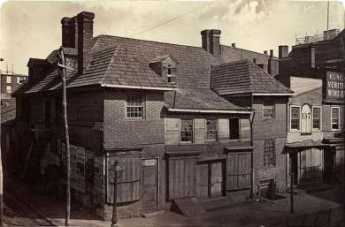
|
| Slate Roof House |
When he lived in Philadelphia, William lived in the "Slate Roof House" on Second, between Chestnut and Walnut (a small park commemorates the building lot), and the Letitia Street House. His plans originally were to build a manor house where the Art Museum stands today, on Faire Mount, but somehow he changed his mind and moved to Pennsbury on the Delaware River near Trenton. This manor also did not survive, but its careful restoration is now well worth a visit.

|
| Horticultural Hall |
William Penn had thirteen children, a circumstance adding much difficulty for genealogists. John Penn, the nephew of William's son Thomas, was the grandson who acted as Proprietary Agent and Governor prior to the American Revolution, although Thomas remained in London as a close friend of the King, and exercised firm control of the policies of the Proprietorship. John built a fine mansion on the Schuylkill called Lansdowne at the site of what was to become Horticultural Hall in the 1876 Centennial. About all that can now be visited is the glen on the estate, over which a bridge is still usable. It was here that he was apprehended by Revolutionaries, and taken to house arrest in New Jersey.
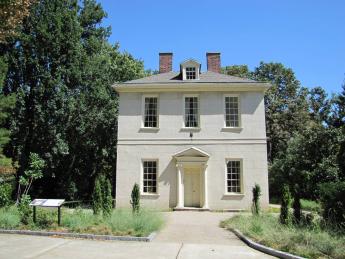
|
| Solitude House |
Lansdowne burned in the early 19th Century and pictures of it are hard to find. A smaller house of John Penn's, called Solitude, still stands near what is now the Zoo. John was arrested by rebel troops while living at Lansdowne and held prisoner at another house confusingly called Solitude, on the grounds of what became Union Forge, later the Union Forge Ironworks, subsequently the Taylor Iron and Steel Company. All of this is located in High Bridge, New Jersey, where subsequently five generations of the Taylor family lived until 1938. The Union Forge Heritage Association/Solitude House Museum welcomes visitors.
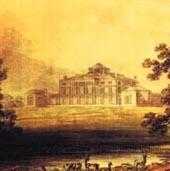
|
| Stoke Mansion |
A different John Penn, who called himself John Penn of Stoke, inherited a much larger portion of the final payment for the Proprietorship lands in Pennsylvania in 1789 because he was the son rather than the nephew of Thomas Penn. Thomas had purchased the historic Manor House in Stoke Poges in England. Although this splendid palace dated back to 1066 and Elizabeth I had visited it, it was by 1790 so dilapidated that John Penn demolished three-quarters of it. In its place, he built a proper palace, called Stoke Park. The family fortunes seem to have declined after that, perhaps because of the extravagance of an estate he could not afford.
Harvard Men Suggest a Cold Place for Yale
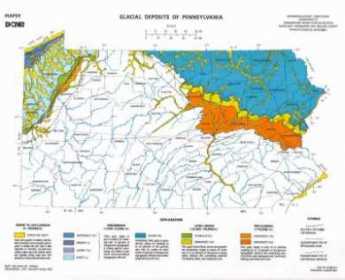
THE Colonial disputes with Great Britain were settled in 1783, creating great opportunities for the Colonies to resume their disputes with each other. Because of the unfortunate earlier action of the Penn Proprietors in selling land already occupied by Connecticut settlers, the legislatures of Connecticut and Pennsylvania behaved in ways that do them no credit. The situation could easily have led to more armed conflict, and it could even have gone from local war to fragmentation of the nation. So, although New York was close enough to know better, they joined with Massachusetts in offering to consider carving a new state out of Pennsylvania's northeast corner. The proposal was rejected, but the geological idea remains.
The northeast corner was once covered by glacier, and the region remains separated from the rest of Pennsylvania by a "terminal moraine", which is the huge pile of rocks and stones left behind after a glacier recedes. There are thirteen counties of rather desolate woods in this corner, with five or six more counties of moraine. Even today, some upper counties have only five or six thousand residents scattered in little settlements. The whole idea of creating a new state died when people got a chance to walk around and actually look at the region. Although one county is named Wyoming, this was not Wyoming, Fair Wyoming, at all; this was a pile of rocks. Moraines were what the Connecticut settlers were trying to escape.
However, their grandchildren might be unsure. Tremendous deposits of anthracite were soon discovered in the region, and then oil in Bradford County. Present residents of New York City will apparently commute endlessly to escape taxes, so an interstate highway or two would probably quickly make the area into Little Brooklyn.
The central point in all this was beginning to emerge. Since the Constitution was ratified, it simply no longer matters what state you were living in, as long as you can trust the legislature and the courts to be reasonably fair. These two combative legislatures and affiliated courts were once quite obviously behaving in a manner too obscenely partisan to be tolerated. Everybody involved in this mess could see the advantage offered by the ability to appeal to a superior power dominated by the other eleven (now, forty-nine) states. Carving out a separate state was not a compromise, at all. It was a threat, just as unsatisfactory to one combatant as the other.
Although it was clearly time to put aside the grievances and vengeances of a land dispute which had got out of hand, currents of other wild and headstrong ideas continued to swirl into the northeastern corner of Pennsylvania. In April 1786 Ethan Allen himself showed up in this region, wearing full Regimental uniform. He declared he had formed one new state and that with one hundred of his Green Mountain Boys and two hundred riflemen, he could establish another one. There is some reason to suppose Allen was responding to an action of the Susquehanna Company of Connecticut, which had held a meeting the previous September where Oliver Wolcott drafted a constitution for a new state named Westmoreland. William Judd was to be governor, John Franklin lieutenant governor and Ethan Allen was to be in command of the militia. The Assemblies of both Connecticut and Pennsylvania immediately reacted with outrage to renounce the whole State of Westmoreland idea; when John Franklin persisted, he was dragged to Philadelphia and thrown into jail to calm his rebellious spirit. Nevertheless, the point was dramatized that -- even five years after the Decision of Trenton had supposedly settled the matter, and after all sensible neighbors urgently wanted this dispute terminated -- something else needed to be done to strengthen the Articles of Confederation, or preferably replace them entirely.
Disorderly Retreat: From Trenton Back to Perth Amboy
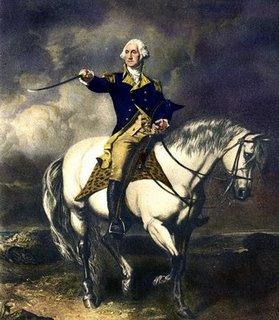
|
| George Washington on a Horse |
A week later, they got a bad jolt; Washington declined to play by their winter rules. At the Battle of Trenton, Washington was 44 years old, six feet four inches tall or more, a horseman and athlete of outstanding skill, and as the husband of the richest woman in Virginia, accustomed to housing, feeding, transporting and getting cooperation from two hundred slaves. All of those qualities may have been of some use in the battle. But after the Battle of Trenton, Washington also emerged as a remarkably bold and creative General. In the Battle of Trenton ca-----------------999999 seen the elements of audacity, timing and courage that were notable in Stonewall Jackson, George Patton -- Virginians, both -- the Normandy Invasion, and the Inchon Landing. He forged, if he did not create, the American military tradition of inspired risk-taking. And he did it with a collection of starving amateurs, up against the best Army in the world at the time. Probably without realizing it, his coming victory at Trenton also gave Benjamin Franklin in Paris a major enticement for the French King to support the American cause. Washington produced a significant achievement, but just to make sure, Franklin exaggerated it just as much as he could.
On December 21, Washington thought Howe was immediately going to sweep on through Trenton to Philadelphia. In a day or two, he saw that wasn't the plan, organized the famous re-crossing of Delaware in bad weather, and caught and captured a thousand Hessians with a three-pronged attack which cut off their retreat and made resistance useless. The main military feature of this attack was not Christmas drunkenness among the Hessians, but the fact that General Knox had somehow transported eighteen cannon to the occasion. Nowadays, the event is marked by a reenactment on Christmas Morning, although it took place on December 26, 1776. The timing did not have to do with religious observance, it had to do with hangovers. To the great disappointment of his troops, he made them abandon the great stores of booze in Trenton because a second detachment of Hessians was in nearby Bordentown, and meanwhile, he retreated back to the Pennsylvania side of the river. As might be imagined, Howe's Cornwallis promptly came charging down from New Brunswick to exact bitter vengeance. Instead of trying to rescue their comrades in Princeton, the Bordentown Hessians took off for New Brunswick. Defiantly, Washington taunted his enemies by again recrossing Delaware to the New Jersey side, put up fortifications, just waited for them to make something of it.
Well, that's the way it was meant to seem. On the night of January 2, the two armies were facing each other with about five thousand men on both sides, but with the British much better trained and equipped. The Americans had the advantage of not being exhausted by a fifty mile forced march, except for about a thousand who had been deployed forward to skirmish and delay the British advance with sniping from the bushes. The Americans made a great deal of noise and lit many bonfires behind their fortifications. But when they advanced the next morning, the British found out where the Americans really were -- by hearing distant cannon fire coming from Princeton, ten miles back toward the north.
Washington had slipped five thousand men wide around the enemy flank during the night and had taken a parallel country road to Princeton where he defeated a rear guard of British at the Battle of Princeton. An infuriated Cornwallis wheeled his army around in pursuit, and the race was on for the supplies left undefended in New Brunswick. Washington might have been able to get there first, except his men were too exhausted, and he was afraid to risk his long-run strategy, which was to avoid head-on collisions with the main British Army.
So Washington went into winter quarters in Morristown still further to the north, and thousands of British soldiers were thus bottled up in winter quarters in Perth Amboy and New Brunswick, where scurvy, lack of firewood and smallpox gave them a few months to consider their miscalculations. But the most important action of all was getting the news to Benjamin Franklin in Paris, to tell the French king of the victory. Franklin even dressed it up a little.
REFERENCES
| New Jersey in the American Revolution: Barbara J. Mitnick: ISBN-13: 978-0813540955 | Amazon |
Edward Hicks: Peaceable Kingdoms

|
| Peaceable Kingdoms |
Edward Hicks (1780-1849), the most important folk artist of American art, was born and lived all his life in Bucks County, Pennsylvania. About a hundred of his paintings survive, 62 of which are versions of "The Peaceable Kingdom". Recently, his Peaceable Kingdoms have been selling for more than $4 million apiece, and the other works at more than a million. As is so often the case, he was born in poverty and spent his life in poverty, so the financial benefits have all gone to middle-men.
Hicks had to overcome an additional handicap. Quakers disapproved of painting things up just for show, and they strongly disapproved of the vanity underlying the act of having a portrait painted of yourself. In fact, the early Quakers would not even permit their names to be placed on their tombstones.
Hicks was apprenticed into the wagon business and showed a talent for painting them. From that, entirely self-taught, he migrated into the business of painting business signs in an age of limited literacy. The Blue Anchor Tavern, the King of Prussia Inn, the Crossed Keys Tavern and the signs of various tradesmen were an essential part of conducting business. It is easy to see these tradesmen signs in the easel paintings of Hicks' later career, which reduce themselves to rearrangements of such individual sign paintings to make a coherent canvas.
If you have seen one "Peaceable Kingdom" you haven't seen them all, but you only need to see one to be able to recognize the others at sight. They generally form a group of wild animals and an occasional child in the right foreground, with a grouping of Quakers and Indians in the left background, taken from Benjamin West's famous portrayal of Penn signing the treaty of peace with the Delaware Indians. The scene is taken from Chapter 11 of Isaiah, in which the lion lies down with the lamb.
Hicks was not a successful farmer, and he had to overcome Quaker resistance even to sell religious paintings with a Quaker moral. No doubt the resistance was strengthened by the fact that his cousin Elias Hicks had split the Quaker church into two (Conservatives and Hicksites) in 1827, and Edward was himself a strong itinerant preacher. Although the plain message of the Peaceable Kingdom is reconciliation between the two branches of Quakerism, he probably encountered a fair amount of coolness among the Conservative opposition.
Hicks was neither an educated nor a sophisticated man. It is forgivable that he made such a strong Old Testament statement when he and his cousin represented a dissenting sect that was gravely doubtful about the wisdom of allowing your life to be ruled by biblical verses.
Greenhouses

|
There are lots of mundane activities involved in having a prize show garden, like compost heaps, cold frames, mud rooms, and the like, which competitive show-gardeners never think of talking about, let alone putting on display. However, someone who feels very competitive about the garden usually lets that competitiveness spill over into the greenhouse. Most working greenhouses are muddy and disreputable-looking. When you see a big greenhouse with a spotless floor, however, you know you are learning something about the owner. When tidiness extends to spotless tools and well-sharpened pencils, there's a message. This greenhouse is not merely a tool shed, it's part of the display.
Let's talk about three outstanding greenhouses in the Philadelphia region which are adjuncts to three outstanding horticultural competitors. To spare the feelings of all concerned, the names of the owners will not be mentioned. In one case, the plants are preponderantly indoor plants, a second one is preponderantly filled with outdoor plants, and the third is full of rarities.
The greenhouse full of indoor plants reflects an owner who primarily competes in flower shows in that type of plant, it is true. But this lady obviously brings the flowers to a peak of perfection and then shifts them into the house. The result is a dining area with twenty-five potted flowers scattered tastefully around, dressing up the house. One presumes the flower pots go back to the greenhouse when they start to wilt a little, and probably an effort is made to have plants which flower at different seasons of the year. Back out in the greenhouse, there are dozens of blue ribbons arranged within picture frames to produce pleasing arrangements in themselves. Although this is a famous horticulturalist of long standing, the blue ribbons on display are only awards from fairly recent shows.

|
The second greenhouse to be mentioned is primarily devoted to outdoor plants, being bred and hybridized in controlled circumstances. The owner has created a garden in the interior of a suburban block on the Main Line, and although the houses are all part of the estate, the effect is one of the certain types of plantings in several backyards, a set of sculpted topiaries in one, a formal arrangement of boxwood designs in another, annuals in another. Although the rotation of plantings back and forth from the greenhouse is here probably more of a one-way trip, essentially the greenhouse is serving the same function as the one servicing the indoor display, a place to nurture plantings which are not quite ready for prime time.

|
And the third greenhouse is primarily run by a husband and wife team of horticultural competitors. The other two gardens look as though they employed a dozen or so gardeners, while this one looks like it supports a two-person hobby. It contains a most unusual fern with its own nickname, and dozens of other display specimens of rare and unusual plants to compete in specialty shows of particular varieties. This greenhouse is just as spotless as the ones with much larger staff to do the cleaning, but it seems to have a wider variety of gardener conveniences to lighten the load and increase productivity. One quickly senses that the husband of the team pores over greenhouse catalogs and quickly adopts labor-saving devices. Space is at a premium in this greenhouse, and one guesses its results as much from a need to conserve steps as to conserve space. The effect faintly starts to resemble the jam-packed cockpit of a space-ship.
One technology advance seems to be so superior they all have it. The exterior surface of the greenhouses is not made of glass, but of polycarbonate plastic, sometimes known as "bullet-proof glass". Greenhouses seem a safe enough use for polycarbonate, although widespread use in disposable plastic water bottles seems a more questionable direction for environmental enthusiasm. This transparent material admits the light of a much wider wavelength, particularly ultra-violet, and no doubt greatly extends the season and the effectiveness of indoor nurture. From the photographer's point of view, the resulting pictures are far more pleasing, with diffused light and greater color brilliance. Thus, science has finally achieved for the Philadelphia region the same striking color of light that was so attractive to French Impressionists in southern France, and to vacationers in Hawaii.
The other thing this plastic invention has done has been to increase the general attractiveness of greenhouses. Until rather recently, it was the custom to paint white-wash on the glass and let it slowly weather away as increased sunlight is needed for the plants. Thus, greenhouses once almost always looked shabby and disreputable; not a place you would want seeing by visitors. But nowadays, you just keep them spic and span. And hold a cocktail party there.
REFERENCES
| Standardized Plant Names: American Joint Committee on Horticultural, Frederick Law Olmsted | Google Books |
Henry Mercer's Rathskeller
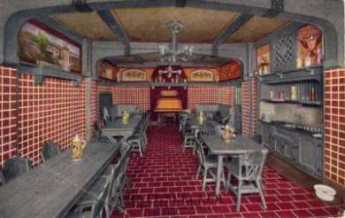
|
| Racquet Club |
RRathskeller was originally the name for a restaurant in the basement of a German City Hall, where the town Council would gather privately and make deals. That's quite different, by the way, from a Bavarian beer garden, which is a restaurant attached to a brewery where the public sings patriotic songs. Philadelphia used to have lots of both beer gardens and rathskellers, until World War I made German culture unpopular here, and the Volstead Act made beer illegal. In many ways, the most important surviving rathskeller in Philadelphia is in the basement of the Racquet Club. Surprisingly, it has only been a rathskeller for about twenty years.
Horace Trumbauer built the club on 16th Street in 1906, but by 1907 parts of it were still unfinished. He invited a fellow member of the club, Henry Mercer, to design the hang-out in the basement. Mercer, who was then known mainly as the curator of the University of Pennsylvania Museum of Archeology, was to go on to become famous for his factory producing tiles of burnt clay in Doylestown. The grotto in the Racquet Club basement was to be his laboratory for developing a style of poured-in-place concrete construction, with "Mercer" tiles embedded in the walls and particularly the floor. Mercer's own mansion and museum, built in Mercer style, are next to his pottery in Doylestown; not everyone is thrilled with the Mercer style, but it is not easily forgotten.
The grill room, or wine room, of the Racquet Club was built around a concept. It was to have an enormous stove or grill, serving club members oysters, steaks and chops with lots of beer, twenty-four hours a day, seven days a week. That sort of eating and drinking is now uncommon, and one club historian has remarked that most of the members who enjoyed that sort of lifestyle, probably died of it. To symbolize that the door to the grill was always open, the key was buried under a Mercer tile in the huge fireplace. Inscribed on the tile was the Latin motto, "DUM CLAIM TEAM". Off in a side area were four bowling alleys, now covered over because of disuse. With a huge fireplace and an even huger grand grill lit twenty-four hours a day, the place was said to get a little warm in the summer. The area has since been air-conditioned, but its popularity will probably return only when Prohibition does.
Henry Mercer liked poured concrete walls, which at their best are gloomy grey, and with a big fireplace can soon get dark and dirty. As the lights in Mercer's home, the light bulbs were dim, even flickering. It is impossible to imagine a college fraternity house with more appeal to young males than the wine room of Philadelphia's socialite Racquet Club. However, with the decline in popularity of the room which parallels Philadelphia's restaurant revolution, the idea finally gained acceptance that salvation lay in pepping up the grotto.
So, in the 1980s, the walls were painted white, the light bulbs were increased in strength, the ceiling was lowered, and four ceramic wine barrels were placed next to the fireplace. As a final touch, several dozen flags of various nations were stuck in the walls around the room. The historic laboratory in which the Mercer style was developed and made famous, was transformed into somebody's idea of a Rathskeller. At Friday lunch, the rafters ring with the gaiety of the Right Angle Club, most of whose members have heard of Mercer, but somehow never had time to go look at his museum.
Quilts, Patchwork Style
 Although quilting can be found in the tombs of ancient Egypt, American farm women are correct that they invented an art form. 
|
| Dr. Fisher |
In the days when transport was primitive, art forms were invented in many places at once, mostly responding to new materials and new technologies. It's irrelevant to the genius of creation, for archivists to pounce on evidence that an art form surfaced a decade or two earlier in one place than another. Creative art could easily have been -- and often was -- invented by five or six people in different regions, each with a just claim to inventing without copying. In the case of quilts, there is a semantic wrinkle, too. If you define quilting as the process of anchoring three layers of cloth together with stitches, then quilts have been found in ruins of ancient China and ancient Egypt. The underlying principle was that three layers of cloth were warmer and stronger than single sheets of cloth or animal skins, so quilting was used for shoes, pants, jackets, and underneath suits of armor. Mary Queen of Scots spent a lot of time in confinement, and examples still survive of tapestries she made with the quilting process. None of this is what American farm women mean when they say that "quilts" are an American invention, and a new art form.

|
| Quilt, Patchwork Style |
What they mean is patchwork-quilting of bedspreads or counterpanes. To make that specific kind of quilt, you pretty much have to wait for the industrial revolution to provide decorated cotton cloth, then for it to become cheap enough to be used as sacks for flour. That attracts frugal farm wives salvaging material for dresses and shirts, and later re-salvaging pieces of it for patches. Somewhere the idea caught on that decoration was needed for the tops of beds; if these ornaments were usable for extra warmth it was even better. And so, we got patchwork counterpane quilts, incorporating different colored patches into designs. They start appearing around 1750 but gained real popularity around 1830. Since no one was keeping records, it's hard to know if the common diamond design was an outgrowth of the Scotch-Irish street "diamond", or an outgrowth of the hex signs which are commonly believed to have originated in the monastery in Germantown. The path of westward migration would have carried such traditions to the rest of the country, so this analysis has some plausibility. However, the ideas are so simple it would surely be impossible to trace them. What is so unique about this folk art is that the design can be oriented around a piece of a favorite grandparent's shirt or dress, evoking that person's presence and personality in a manner largely incomprehensible to anyone except the immediate family. This intimate quality is easily lost, even in third and later generations of the family, although family traditions can be maintained in the designs and by hearsay.
There may be other traditions of folk art evoking a particular individual who is unrecognizable to outsiders. They might admire features of the design but have no way of knowing the personality of the person celebrated, or making associations with the piece of cloth. But this quilt art becomes established as a family heirloom as almost nothing else could be. Its sweetness is oblivious to the fashion police who contribute a rather aggressive undertone to so much of the art world. For example, in the period between the first World War and the Korean War, it was just about impossible to have a non-modernist painting accepted for a juried show. The same juries who enforced such competitive dictates seemed to forget they denounced the "conservative" academics who excluded impressionist painting a century earlier. During the modernist period, disk jockeys and band leaders likewise serially enforced the various fashions of jazz music; classical music was totally banished. Book reviewers, now a dwindling race, similarly laid down standards of obedience for authors and playwrights on behalf of a style now commonly praised as "liberal". Publishers and producers defied such dictates at their peril, and now must reorient to the coming new standard, called post-modernism.
By contrast, the isolated troubadours of home quilting artistry continue to create as they please, primarily speaking to their families and selling a few less treasured products -- to uncomprehending strangers.
Gettysburg
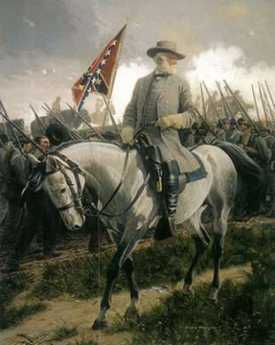
|
| General Robert E. Lee |
It's quite a long drive from Philadelphia to Gettysburg, but General Lee was attempting to disrupt supplies to the "Arsenal of the North" by capturing the railroad center at Harrisburg. Furthermore, Philadelphia reacted as if Lee's advance was aimed straight at us, creating hysterical preparations for an invasion which had to be stopped before it got here. And finally, George Gordon Meade, the Union commander, was a Philadelphia home town boy. So, regard the Battle of Gettysburg as part of Philadelphia history, please.
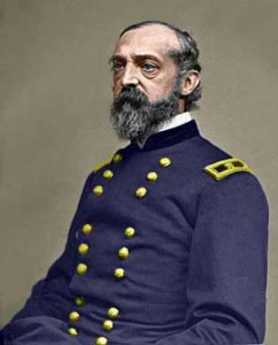
|
| General George Gordon Meade |
Major (ret.) Lawrence Swesey is a West Point graduate and currently Administrator of the 1st City Troop; because of his enthusiasm for the subject, he runs a tour agency which specializes in battlefields, especially Gettysburg. From him, the Right Angle Club recently learned much that made the whole episode comprehensible. Such as Lee's purpose in going there, which appears to have been based on the growing recognition that the South was likely to lose the war, and desperately needed some major victory in Northern territory, both to take the pressure off the Southern homeland and to improve whatever terms might be extracted at a peace negotiation. To fight successive battles against a larger enemy, with larger economic resources, was to doom the South eventually as resources and men were depleted with no hope of replacing them. Sooner or later, some Union General like Grant would settle down to a grinding unrelenting assault, with the willingness to trade one death for another, until only the larger side was left standing. That's quite different from guerilla warfare of the type Washington fought, where the way to win was simply to avoid losing until the stronger side lost its civilian support. Lee could feel the South beginning to lose its nerve to fight on indefinitely, without any visible route to victory. Although Grant eventually did defeat him by attrition, Grant's own opinion appears to have been more personalized. In every war, he was later to say, there comes a time when both sides want to quit. The side that wins is the one with a general who keeps fighting for no particular reason until the other side finally quits and he wins the war.
Major Swesey emphasizes that rifles were available, but they cost four times as much as smooth-bore muskets which were only effective for twenty or thirty yards. Rifles were reserved for sharpshooters, and the enemy at a distance was bombarded by artillery as the two sides approached. So, in Pickett's famous charge, most of the casualties took place in the last fifty yards. Pickett's men had to contend with trudging stoically through an exploding field of cannon fire, unable to fire effectively at the Union men behind a stone wall, who were also supposed to lie passively on the ground while the Confederate artillery pounded at a stationary target. Somehow, most of the Southern artillery fire went over the Union heads and landed beyond the crouching line; in many ways, this was the main factor in the Union victory.
As the waves of attackers got within musket shot of the wall, they formed into three ranks. Since it took about a minute to reload the musket, a more or less continuous fire could be maintained by rotating three successive volleys rank by rank, at more or less point blank range. Then, fix bayonets, and the real slaughter became a hand to hand, in the blazing heat of summer.
www.Philadelphia-Reflections.com/blog/1436.htm
Albert C. Barnes, M.D.
A private investor has the general goal of accumulating enough wealth so, come what may, there will be a little left when he dies. If he has dependents or heirs, he needs somewhat more. Either way, he is not planning for perpetuity or thinking in astronomical time periods. Albert C. Barnes (1872-1951) had to switch his investment goals, in the 1920s, from investing for a comfortable retirement to investing for a perpetual art foundation. Perpetual.
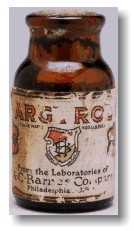
|
| A bottle of Argyrol |
Having graduated from medical school (University of Pennsylvania) in 1902, and then writing a doctoral thesis in chemistry and pharmacology at the Universities of Berlin and Heidelberg, Barnes invented a patent medicine that quickly made him rich. Argyrol was a mildly effective silver-containing antiseptic with the unfortunate tendency to turn its users permanently slate-gray. The advent of antibiotics has since made Argyrol almost sound like quackery, but it was effective enough at the time to require factories in America, Europe, and Australia, and Barnes became immensely rich with it. The American Medical Association strongly disapproves of physicians who patent remedies, so Barnes was never held in high regard by his colleagues; but it could well be argued that he had as much training as a chemist as a physician, and spent his entire professional life as a chemist, manufacturer, and investor.
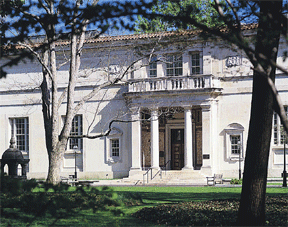
|
| The Barnes Gallery |
Barnes was eccentric, all right, but on Wall Street, the saying goes, "What everyone knows, isn't worth knowing." Guided by that principle, in 1929 he sold his company at the very peak of market euphoria, getting out of common stocks at the top of the market. It is small wonder that he soon instructed his Foundation to invest its endowment entirely in bonds. During the 1930s, commodities were extremely cheap because no one had any money. Barnes, of course, had a potful of money and bought hundreds, even thousands, of artworks very cheaply. He also bought 137 acres of Chester County, PA, real estate, and a 12-acre arboretum in Merion Township on the Main Line. Although he is famous for acquiring hundreds of French Impressionist paintings with the advice of Gertrude Stein and her brother Leo, he also bought great quantities of Greek and Roman classical art, African art, and the art of the Pennsylvania German community. He picked up a notable collection of metallic art objects. Most of these "losers" are down in the basement because he had so many Renoirs, Matisse, and Picasso (some of them may be worth $200 million apiece) that the upstairs galleries were pretty well stuffed with them. Viewed from the perspective of an investor with a goal of perpetuity, of course, the things in the basement just happen to be temporarily out of fashion, just like those bonds in the portfolio.
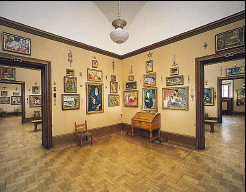
|
| A view inside the Barnes gallery |
Since the Foundation is currently strapped for ready cash, Judge Stanley Ott of the Montgomery County Orphans Court is now being urged to allow the Foundation to break Barnes' will in some way or other. Move the museum to downtown Philadelphia where it can attract more paying visitors. Sell some of that land. Sell some of those paintings in the cellar. Fire some of those employees. But all of these suggestions are short-term solutions, which may injure the long term. Everybody has an idea of what Barnes the rich eccentric would have done if he were alive to do it, but I suspect he would have rejected the whole lot. Barnes the shrewd investor would have taken the most expensive painting off the wall, and sold it to the highest bidder. Buy low, sell high, and the niceties of non-profit professionals are damned. Barnes wasn't in love with one single painting, or one particular school of painterly interpretation, he was in love with Art.
Investment theory has improved in the past fifty years; there have even been some Nobel prizes awarded for new insights. But it still isn't possible to put an investment portfolio on autopilot for perpetuity. Every museum, university, and the foundation has the same problem, with the result that the landscape is littered with the bones of perpetual organizations destroyed by following a fixed formula. With the singular success that Barnes displayed, it isn't surprising that he went a little too far with instructing his successor trustees in what to invest in. Never sell the paintings or the real estate, avoid the common stock, were ideas that worked brilliantly, and may even work most of the time. But sooner or later, the institution will be endangered by following them too literally. Somebody has to have some flexibility. But there is something else that is inevitable, too. Sooner or later, whether it takes fifty years or five hundred years, sooner or later someone will be given the responsibility and the necessary flexibility -- but will try to run off with the boodle, for himself. The balance between necessary prudence and necessary flexibility is impossible to maintain forever, and the Judge will surely have a hard time deciding what Barnes would have decided.
Bring Your Own Hammer
Stonehenge in England is a ring of big stones standing on the edge, but only recently has it been discovered that they chime when you hit them with a hammer. The British didn't discover the phenomenon, however. Long ago the Quakers of Pennsylvania knew they had ringing rocks in a moraine dumped at the edge of a receded glacier in Bucks County. The County has made it a recreation park which is mostly deserted, except when a drove of cars appears, bearing dozens of Cub Scouts or other excursionists.
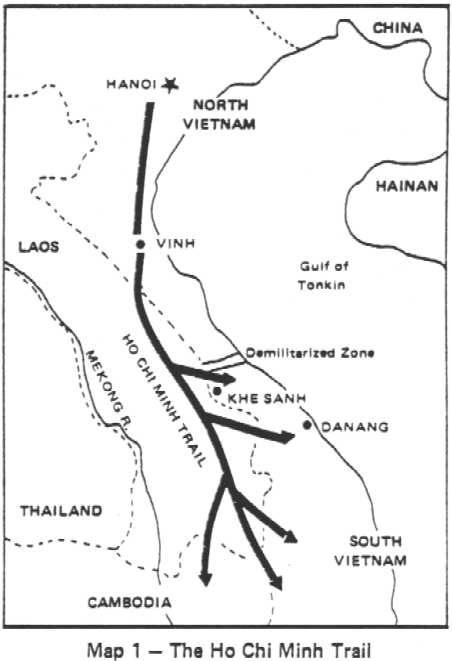
|
| Ho Chi Minh Trail |
Just what makes these boulders chime when you hit them with a hammer, isn't entirely clear. It's certainly a good topic for a geologist to use for a thesis, but right now none of the visitors to the park cares very much. It can easily be seen that the moraine marks the edge of the fertile plain surrounding Philadelphia, to the north of which the ground breaks up and has mining as its main industry. The farms suddenly become smaller and less prosperous on the moraine plateau, and fancy exurban restaurants yield place to auto dumps and parks of pickup trucks. In certain seasons, it is possible to imagine the gun racks above the front seats. Some of the areas suit itself for summer cottages in the hot weather, usually close to a stream or lake. This is the area where the Shenandoah Valley extended, narrowing down to the Delaware Water Gap. George Washington didn't just cross Delaware once near here, it was a sort of a Ho Chi Minh Trail out of reach of the British Fleet during the Revolutionary War. The main arsenal of the Revolution was in Reading. The valley meets what used to be an industrial area along Delaware, coming up from Philadelphia. Before that, the Seneca Indians had made it their headquarters, and after that, people like Stephen Girard discovered and exploited the minerals once exposed by the glaciers to the north. There's a "wind gap" (cleft in the mountain without water at the relatively high base), and the water gap. William Penn terminated his line separating East from West Jersey at Dingman's Ferry within this region, and later his sons' agents cheated the Indians with the Walking Purchase nearby. The politics of Bucks County are easily imagined by looking at prosperous Doylestown and comparing it with nearby rundown Easton. This is really just the center of Bucks County, half of which extends to the North, and all of which must have an interesting political history.

|
| Ringing Rocks County Park |
Abruptly, turning a corner amidst the summer cottages, is a neat little park, the Ringing Rocks County Park. At times it is deserted, at other times you can hardly find a place to park your car. Fields of boulders, three to ten feet in diameter, extend down the hill to the river. It's easy to go down, not so easy to get back up to your car. People pile out of their cars, carrying brand-new hammers, and you can see dozens of (probably disappointed) pockmarks on the rocks near the parking area. If you thought it was going to be easy, you are quickly disappointed.

|
| Japanese Beetle |
But the legions of cub scouts, happily swinging their hammers, swarm down on the rock piles, hitting every rock as they go. If there are enough of them, you hear plenty of clunks, but also an occasional ringing chime is heard, and the other cubs soon swarm around. At a rather daunting distance from the edge of the rock field, one cub scout after another discovers a rock that chimes like a cowbell. He attracts his friends, who have a whack at it. The chimes never quite outnumber the clunks, but the music rises as the scouts swarm over the property on agile little feet that soon defeat their elders' lumbering climb. A sudden thundershower made the rocks too slippery even for kids, and the place quickly emptied out. When we got back to the top of the hill, soaking wet, there were only a few cars still there.
Using the Delaware River as a Weapon

|
| George Washington on a Horse |
After the Battle of Trenton, Washington emerged as a remarkably bold and creative General. In this battle of maneuver can be seen the elements of audacity, timing and courage that were notable in Stonewall Jackson, George Patton -- Virginians, both -- the Normandy Invasion, and the Inchon Landing. He forged, if he did not create, the American military tradition of inspired risk-taking. And he did it with a collection of starving amateurs, up against the best Army in the world at the time. Probably without realizing it, his coming victory at Trenton also gave Benjamin Franklin in Paris a major enticement to the French King to support the American cause. Washington produced a significant achievement, but just to make sure, Franklin exaggerated it just as much as he could.
On December 21, Washington thought Howe was immediately going to sweep on through Trenton to Philadelphia. In a day or two, he saw that wasn't the plan, organized the famous re-crossing of Delaware in horrible weather, and caught and captured a thousand Hessians with a three-pronged attack which cut off their retreat and made resistance useless. Nowadays, the event is marked by a reenactment on Christmas Morning, although it took place on December 26, 1776. The timing did not have to do with religious observance, it had to do with hangovers. To the great disappointment of his troops, he made them abandon the great stores of booze in Trenton because a second detachment of Hessians was in nearby Bordentown, and retreated back to the Pennsylvania side of the river. As you might imagine, Howe's Cornwallis promptly came charging down from New Brunswick to exact bitter vengeance. Instead of trying to rescue their comrades in Princeton, the Bordentown Hessians took off for New Brunswick. Defiantly, Washington taunted his enemies by again recrossing Delaware to the New Jersey side, putting up fortifications, just waiting for them to make something of it.
Well, that's the way it was meant to seem. On the night of January 2, the two armies were facing each other with about five thousand men on both sides, but with the British much better trained and equipped. The Americans had the advantage of not being exhausted by a fifty mile forced march, except for about a thousand who had been deployed forward to skirmish and delay the British advance with sniping from the bushes. The Americans made a great deal of noise and had many bonfires behind their fortifications. But when they advanced the next morning, the British found out where the Americans really were by hearing distant cannon fire coming from Princeton, ten miles away.
Washington had slipped five thousand men wide around the enemy flank during the night and had taken a parallel country road to Princeton where a major detachment of British was then defeated at the Battle of Princeton. An infuriated Cornwallis wheeled his army around in pursuit, and the race was on for the supplies left undefended in New Brunswick. Washington might have been able to get there first, except his men were too exhausted, and he was afraid to risk his long-run strategy, which was to avoid head-on collisions with the main British Army.
So Washington went into winter quarters in nearby Morristown, and thousands of British soldiers were thus bottled up in winter quarters in Perth Amboy and New Brunswick, where scurvy, lack of firewood and smallpox gave them a few months to consider their miscalculations. But the most important action of all was getting the news to Benjamin Franklin in Paris, to tell the French king of the victory. Franklin even dressed it up a little.
.
Bi-state Fishing
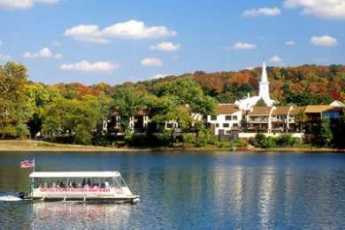
|
| Coryell's Crossing |
The Lewis family still has a house on Lewes Island, and they know a lot about shad fishing, entertaining hundreds of visitors to the shad festival in the last week of April. The river is cleaning up its pollution, the shad are coming back, but they, unfortunately, took a vacation in 2006. At the promised hour, a boatload of men with large deltoids attached one end of a dragnet to the shore, rowed to the middle of the river, floated downstream and towed the other end of the net back to the shore. The original anchor end of the net was then lifted and carried downstream to make a loop around the tip of Lewis Island, and then both ends were pulled in to capture the fish. There were fifty or so fish in the net, but only two shad of adequate size; since it was Sunday, the fish were all thrown back.
But it was a nice day, and fun, and the nice Lewis lady who explained things knew a lot. Remember, the center of the river is a border separating two states. You would have to have a fishing license in both states to cross the center of the river with your net; game wardens can come upon you quickly with a powerboat. But the nature of fishing with a dragnet from the shore makes it quite practical to stop in the middle, where shotguns from the other side are unlikely to reach you. An even more persuasive force for law and order is provided by the fish. Fish like to feed when the sky is overcast, so there is a tendency on a North-South river for the fish to be on the Pennsylvania (West) side of the river in the morning, and the New Jersey (East) side in the evening. During the 19th Century when shad were abundant, work schedules at the local mills and factories were arranged to give the New Jersey workers time off to fish in the afternoon, while Pennsylvania employers delayed the starting time at their factories until morning fishing was over.
Somehow, underneath this tradition one senses a local Quaker somewhere with a scheme to maintain the peace without using force. Right now, there aren't enough fish to justify either stratagem or force, but one can hope.
Secret Service Visits Burlington Bristol Bridge
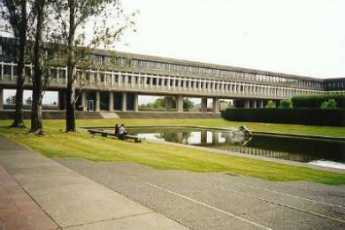
|
| Secret Service Head Quarters |
A few years ago, the buzz around local Secret Service headquarters was that some very good, even exceptionally good, fake hundred dollar bills were in circulation in our neighborhood. The official stance of The Service is that all counterfeits are of very poor quality, easily detected and no threat to the conduct of trade. Unfortunately, some counterfeits are of very good quality, not easily detected, and when that happens, The Service is made to feel a strong sense of urgency by its employers. These particular hundred dollar fakes were of very good quality.

|
| Burlington Bristol Bridge |
One evening, a call came in. Don't ask me who I am, don't ask me why I am calling. But I can tell you that a very large bag of hundred dollar wallpaper has just been tossed over the side of the Burlington Bristol Bridge, near the Southside on the Jersey end. Goodbye.
Very soon indeed, boats, divers, searchlights, ropes, and hooks discovered that it was true. A pillowcase stuffed with hundred dollar wallpaper of the highest quality was pulled out of the river. By the time the swag was located and spread out for inspection, it was clear that several million dollars were represented, but they were soaked through and through. Most of the jubilant crew were sent home at midnight, and two officers were detailed to count the money and turn it in by 7 AM. The strict rule about these things is that all of the money confiscated in a "raid" was to be counted to the last penny before it could be turned over to the day shift and the last officers could go home to bed. After an hour or so, it was clear that counting millions of dollars of soggy wet sticky paper was just not possible by the deadline. So, partly exhilarated by the successful treasure hunt, and partly exhausted by lack of sleep, the counters began to struggle with their problem. One of them had the idea: there was an all-night laundromat in Pennsauken. Why not put the bills in the automatic drier, so they could be more easily handled and counted? Away we go.
At four in the morning, there aren't very many people in a public laundromat, but there was one. A little old lady was doing her wash in the first machine by the door. It was a long narrow place, and the two officers took their bag of soggy paper past the old lady, and down to the very last drying machine on the end. Stuffed the bills into the machine, slammed the door, and turned it on. Most people don't know what happens when you put counterfeit money in a drier, but what happens is they swell up and sort of explode with a terribly loud noise. The machine becomes unbalanced, and the vibration makes even more noise. The little old lady came to the back of the laundromat to see what was going on.
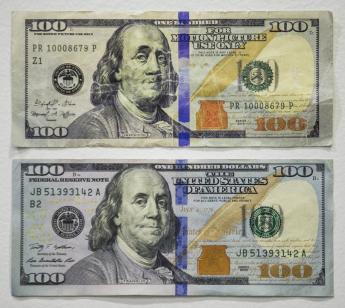
|
| Counterfeit 100's |
As soon as she got close, she could see hundred dollar bills plastered against the window, and that was all she stopped to see. She headed for the pay telephone near the front of the door. The secret Servicemen followed quickly with waving of hands and earnest explanations, but within minutes there were sirens and flashing lights on the roof of the Pennsauken Police car. Out came wallets and badges, everyone shouting at once, and then everything calmed down as the bewildered local cop was made to understand the huge social distance between a municipal night patrolman and Officers of the U.S. Secret Service. Now, he quickly became a participant in the great adventure and was delegated the job of finding something to do with armloads of (newly dried) counterfeit hundred dollar bills. He had an idea: the local supermarket was also open all night, and they carried plastic garbage bags for sale. Just the thing. But who was going to pay the supermarket for the bags? Immediately, everyone was thinking the same thing.
Fortunately for law and order, the one who first suggested the the obvious idea of passing one the counterfeits was the little old lady. At that, everyone came to his senses. Wouldn't do at all, quite unthinkable. The local cop was sent off for the bags, relying on his ability to persuade the supermarket clerk. And, yes, they did get the money all counted by 7 A.M.
Rebel Hill
The Schuylkill River, hence Schuylkill Expressway and also Amtrak, all take a big bend westward about ten miles from Philadelphia. They are making a detour around a big hill or minor mountain, tending to position the sun in the eyes of many commuters at certain hours of the day. Real estate developers are apparently responsible for naming the place Rebel Hill, and it's getting pretty crowded with houses. The Rebel they had in mind was George Washington.
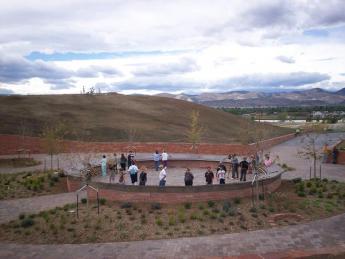
|
| Rebel Hill |
The father of our country was in retreat from the battle of Germantown, having crossed the river at Matson's Ford, then following Matsonford Road over and beyond the big hill, and pausing for water at the spring in the gulch formed by Gulch Creek, now more decorously called Gulph Creek. The creek tumbles down the side of a long ridge forming the south side of the Great Valley; the gulch or gulf is really a crevasse in that ridge, which in a sense makes Rebel Hill just a split-off extension of that ridge. Consequently, the gulch makes a water-level route from the Schuylkill to Valley Forge, which anyone would take to get there in a hurry. Valley Forge is a misleading term; it's a hill in the middle of the Great Valley, as the center of an angel food cake tin, and was thus defensible in all directions. The cleft in the southern ridge is where you would normally travel to get to the base of the bastion of Valley Forge.
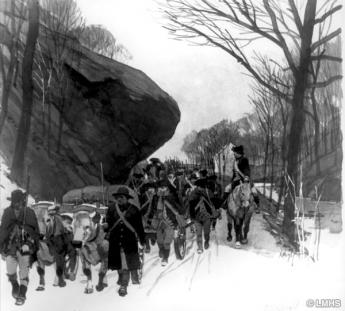
|
| Old Gulph Road |
So, everyone still takes that route, following Montgomery Avenue after it turns into South Gulph Road, but before it turns into North Gulph Road. The road up along the southern ridge is called Old Gulph Road, while the newer extension from the river is called New Gulph Road. All of these winding roads are compressed within the narrow defile beside Gulph Creek, reachable by splashing through the fords in the creek, although that is discouraged after ice forms in the winter. And, yes, a new road has come in at a restored old farmhouse, called New Gulph Road. The restoration has created a fancy restaurant, which somehow forgets that at the time we are talking about, it was the headquarters of (Major) Aaron Burr. The giant highway cloverleaf ahead on South Gulph Road tends to obscure the fact that it was the direct road to Valley Forge, now further obscured by lots of shopping center. If you persist and keep a lookout for the street signs, you will eventually get to the Memorial Arch, log cabins and National Park Service facilities of Valley Forge.
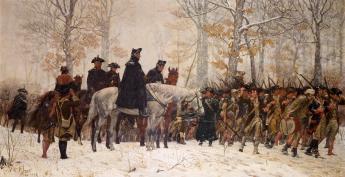
|
| Valley Forge |
Back in the gulch, however, is the spring where Washington's troops refreshed their canteens. Just beyond it is a great big rock, much mentioned in memoirs of the episode. Around 1950, the highway engineers decided to blast this rock out of the way of widening a road that badly needs widening. The Daughters of the American Revolution saved the day. Creating a giant fuss, the DAR succeeded in limiting the engineers to chiseling the bottom of the rock away. A gentleman in his eighties recently remarked he had driven past that rock thousands of times, and always wondered what it was there for. Now he knows.
Main Line Oligarchy
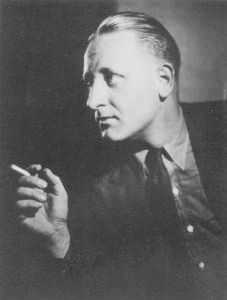
|
| John Gunther |
"In the Philadelphia suburbs, set in an autumnal landscape so ripe and misty that it might have been painted by Constable....lives an oligarchy more compact, more tightly and more complacently entrenched than any in the United States, with the possible exception of that along the North Shore of Long Island....The Main Line lives on the Main Line all year around...It is one of the few places in the country where it doesn't matter on what side of the tracks you are. These are very superior tracks.....What does the Main Line believe in most? Privilege."
John Gunther -- Inside U.S.A.
Governor Keith's House
Route 611 begins at Philadelphia's City Hall and goes due north, headed for the Delaware Water Gap. In 1717 Lieutenant Governor Sir William Keith had decided he needed a summer residence to compliment his in-town establishment on Second Street, and acquired the 1200 acres of land of Samuel Carpenter on Easton Road, now Route 611. Sam had been entrusted with 2000 pounds against a possible French invasion, which Keith transferred to himself by taking Carpenter's land in lieu of it. The ethics of everybody in this transaction are now a little murky. The selected farm area was cool and tranquil, with creeks and level land, so a suitable three-story mansion was built of local stone, with outbuildings. A large mushroom-shaped rock was carved, polished and set on a pedestal beside the house. Tradition has it that Governor Keith asked servants and slaves to lift the stone as a test of physical strength. Keith had several negro slaves, eight or ten indentured servants, and others who were simply hired help for a rather large farm. Criticism was heard for the elaborate luxury of a mansion fifteen miles from town which it took five or six hours to reach.
Governor Keith was an interesting person. He inherited a Scottish baronetcy from his father and is the only Governor of Pennsylvania with a claim to noble blood. His finances were meager, however, and his life was a succession of efforts to advance his own wealth and position, which he regularly consumed with high living. He involved himself in coups and rebellions in Scotland, probably out of expectation of reward from the exiled King James. Efforts at court were finally rewarded by Queen Anne making him Surveyor-General of English land from Pennsylvania to Jamaica, but only after his nearly being hanged for treason for suspected efforts on behalf of the exiled former King James. Keith lost this essentially tax-collector position which he had performed creditably when the Hanoverian King George I took over the throne. After William Penn encountered difficulties which returned him to England, he and the Penn family were in need of an administrator in America, and Keith was at pains to ingratiate himself with Hannah Penn after William suffered several strokes from which he was to die in 1718. Most who met him felt that Keith was charming, although some regarded him as a charming rogue; he succeeded in ingratiating himself to the Penns and was appointed Lieutenant Governor of Pennsylvania in 1716, incurring substantial debts to transfer his family to America in style. After taking office, he wasted no time starting schemes and devices to enrich himself, while at the same time pursuing a populist political style which involved him in more or less constant controversy. There are many echoes in his career of that enduring subsequent conflict in America between creditors and debtors; as probably the most indebted man in Pennsylvania, his populism was highly troubling to conservative Quaker farmers. He pushed hard for paper currency, always popular among debtors, and probably sought to soften the feelings of the Quakers by pushing hard for the replacement of legally binding oaths with secular "affirmations". By doing so, however, Keith infuriated the vestry of Christ Church, representing widely held Anglican support for requiring oaths. Keith's pandering to differing viewpoints succeeded in infuriating James Logan, the secretary of the Penn proprietorship, into setting sail for England to seek Keith's removal from office. Logan only returned with a letter of admonishment from Hannah Penn, and controversy continued to simmer. Reduced to its essentials, a case can be made that Keith behaved like an unrestrained modern machine politician exploiting every opportunity he could find.
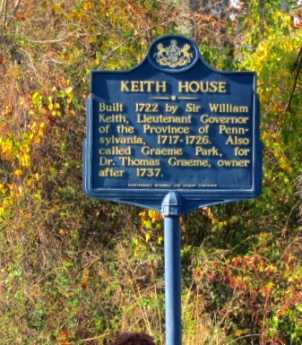
However, certain things can be said in Keith's defense. There is no doubt the Quaker farmers were hypersensitive about the display of wealth which a Scottish baronet would find quite appropriate for a man in his station. His mansion, for example, would barely qualify today as a five-bedroom house in the suburbs, and it is a little quaint to recall that generations of Penrose's and Strawbridge's subsequently lived on the property quite proudly, or even defiantly in view of their ample means. Paper money is indeed always the favorite of debtors who seek to dishonor their debts, but the colonies in Keith's times were suffering from a severe lack of space which can now be explained as the consequence of colonial terms of trade but which at that time was a severe economic hardship. His efforts to stop the practice of executing debtors may well have been made with his own indebtedness in the back of his mind, but still, it seems like a step in the right direction. Even the inventory of his property probably exaggerates the ostentation of his lifestyle. True, he had 144 chairs in the house, but the shortage of currency at that time had converted chairs into a form of exchangeable value, employed by almost every shopkeeper. Land was similarly used as a form of currency, although here most people would raise their eyebrows at a governor accumulating in eight years a list of property including not only this country estate and the downtown house in Society Hill, but a dozen rather large estates in other colonies, and a particularly troublesome investment in a copper mine on the west side of the Susquehanna. To some degree, Keith was a good Governor but was forced into a number of conflicts between the wishes of the settlers and the best interest of the Penn proprietors. Three thousand miles from the Court of St. James, he would scarcely be expected to display universal agility in shifting allegiance between the Stuart Kings, Queen Anne and the Hanoverian King George I, not to mention the Penn family and the settlers on their land. Keith did maintain reasonable stability in the colony while seeming to undermine the best interests of the Penn family. He was said to have made shrewd business decisions for the whole region converting surplus grain into malt at a time of money shortages in the colony, even though it particularly profited his own acreage. In some ways, his reputation remains chiefly tarnished by his treatment of Benjamin Franklin. Encouraging Franklin to go to England to buy some printing equipment, Keith promised letters of credit for what was presumably intended as a joint venture. The letters were never forthcoming, Franklin was stranded for months in England without means to return home. Franklin got his revenge years later in his autobiography. This was not the only example of Franklin nursing a grudge for decades. Poor Keith returned to England to defend himself against dismissal by the Penns because of all the turmoil and factionalism, but essentially never got another job and died in debtors prison. During that time he published extensively about current affairs and economics, but the value of that writing is now difficult to judge.
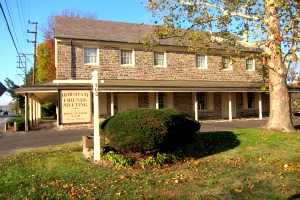
|
| Horsham Friends Meeting |
After Keith returned to England in 1726, presumably to defend his interests and possibly to evade his creditors, the mansion and estate on County Line Road was sold to Keith's son in law, Dr. Thomas Graeme who was a physician at the founding of the Pennsylvania Hospital in 1751 and evidently had become quite prosperous. Graeme paneled the interior of the mansion in high Georgian style, revised the floor plan, generally making the place elegant. Records of how the region between the counties became named Graeme Park, but presumably Graeme would now put up no objection to it. A second house on the property was home to several generations of Penrose's and Strawbridge's; the Strawbridge family donated the estate as a park. Governor Keith having left his wife forever to her distress alone, fathered two illegitimate children in England, making his prevailing emotions subject to uncertainty.
Around the corner, so to speak, on Route 611 the Horsham Friends Meeting is built of the same sort of stonework, with dates which suggest the meeting itself was present well before Keith appeared on the scene, and the string of similar but tavern-like buildings along 611 suggest the highway to Easton was a busy one even at an early time. Increasing traffic and construction carry an ominous prediction that growth of the area will eventually swallow both Graeme Park and Horsham Meeting in a sea of subdivisions and industrial parks. Placing a turnpike entrance nearby almost certainly hastened that fate.
Mennonites: The Pennsylvania Swiss
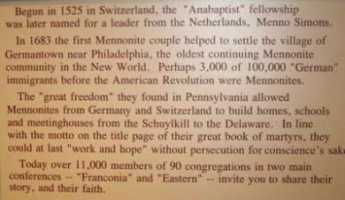
|
| On the Wall of the Mennonite Heritage Center |
Anabaptism, originally attributed to Ulrich Zwingli around 1525, centers around believing a baby is too young to understand baptism, so adults need to be re-baptized. The idea arose independently in Switzerland and Holland, and probably thousands of believers were unmercifully martyred for holding the belief. Because the worst persecutions took place during the War of Austrian Succession (1740-50), they are often attributed to the Roman Catholic Inquisition, but Magisterial Protestants, believing in the separation of church and state, were often also responsible. Many seemingly unrelated issues were introduced locally, and this period of unrest is known as the French and Indian War in America; its major battle took place in Louisburg, Nova Scotia, although George Washington's skirmish around Fort Duquesne (Pittsburgh) has acquired local fame as a major American manifestation.
The Swiss adherents moved to the Rhineland Palatinate, and from there were among the first to accept William Penn's offer of religious freedom. They were the settlers of Germantown, but have mainly moved a few miles west to southern Montgomery County, where the confusion about Pennsylvania Dutchmen is further confounded by the fact that they were Swiss. Menno the Dutchman gave his name to the order, but they themselves regard their true ethnic background as Swiss from the Zurich region. That, by the way, is not to be confused with Calvinism, which also comes from Switzerland, but by way of Geneva, not Zurich. The pacifism of the Mennonites made them mutually attractive with the English Quakers, who had made an appearance fifty or so years later in the region around Manchester, England; each group seems to have adopted some of the features of the other.
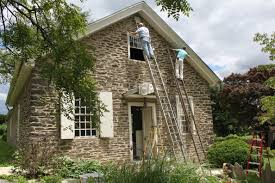
|
| Franconia Mennonite Meetinghouse |
Determined use of the German language has always held the Mennonites apart, however. From the start, it was really necessary to be somewhat bilingual in Montgomery County, using English for business conversation, and German at home and in the church. The idea of using a foreign language is based on the hope it would thus maintain a sense of distinctiveness or even remoteness from non-believers, without adopting the least hostility to them. It almost inevitably follows that the group has used its own schools, attached to their meeting houses. This sense of remoteness has persisted for almost four hundred years, surrounded by entirely different cultures. Starting only around 1960, this attitude has gradually softened, however, and it is widely assumed that in another few decades Mennonites will come to resemble the people in their environment a great deal more than they do at present. If you want to know where to find them, Harleysville is a good place to start. As the tinge of Pennsylvania Dutch accent gradually fades, and fewer of them wear the old costumes, a curious remaining hallmark of their presence can be noticed: an avoidance of foundation planting around their houses. The Mennonites themselves seem to be entirely oblivious to this unintended distinctiveness, which is however quite striking to non-Mennonite passers-by. Those who work in the fields all day have little interest in digging around their houses for decoration; those who have moved away from farming have seemingly adopted the bush-less style as a natural way of arranging things. There's no particular reason to change it, and so, there's no particular reason to notice it.
History of the Mennonites
Heavenly House
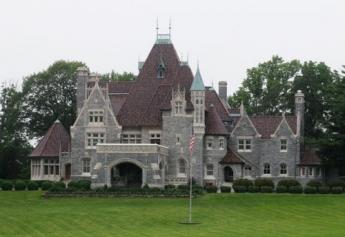
|
| Father Divine House |
While prosperous people, on deciding to enter a retirement community, are often heard to say they are tired of managing a big house, it can also be noticed that people who get the foreign travel bug usually drift around to see the palaces, castles, and estates of kings and emperors. The king's bathroom plumbing is a stop on most tours. Places like Buckingham Palace, the Vatican, the Temples of Karnak, Fortresses of Mogul Conquerors of India, or similar places in Cambodia, are all vast looming piles of stone dedicated to the memory of departed leaders who Had it All. That's probably all you need know, to understand that Americans who have it all tend to build huge show places, too. A great many do discover the castles to become just too much bother. Safe protection and privacy are somewhat separate issues, reasons given for putting up with a big place past the time the thrill has worn off. Perhaps such jaded feelings appear at the end of the wealth cycle. Nevertheless with enough affluence, if you had unlimited money and inclination, where around Philadelphia would you put a dream palace, one built for a modern Maharajah? Answer: close to Conshohocken.
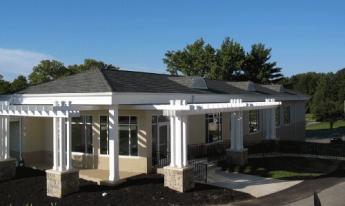
|
| The Philadelphia Country Club |
The Schuylkill takes a sharp bend at Conshohocken because it flows around a big cliff on the west side of the river. It was there the White Steel Company built the first wire suspension bridge in the world, as distinguished from cable (twisted wire) suspension bridges invented by Roebling at Trenton. The bridge was swept away by a flood, the steel mill replaced by the Alan J. Wood Steel Company. Alan Wood prospered mightily, and built his mansion ("Woodmont") on 75 acres on the top of the big rock on the west side of the Schuylkill, in such a way he could watch the smoke rising from his factory down below at the foot of the cliff. The Philadelphia Country Club is across the road from Alan Wood's mansion, with fairways clinging to the cliffs, a Gun Club for trap shooters who want to aim away from houses and toward mountainsides, and a cliff-top road leading straight for Gladwyne between dozens of mansions with five-acre lots. Down the hill, however, rocky projections force the road to funnel into a winding crooked road which ends up near the filling stations of Conshohocken, passing ancient farm structures on the way. Railroads and expressways tend to fill the valley, the old White bridge is gone, and two distinct cultures are within a few hundred oblivious yards of each other. To the west stretches the Main Line, now filled with houses almost as large as the mansion, but air-conditioned and filled with other modern amenities. Seventy acres of a lawn is nice, but it's a lot of grass to cut.
The Alan Wood Steel Company had a hard time in 1929, recovered somewhat after World War II, and then declined to the point where Lukens and Phoenix Steel took over. And then Indians from India took over the lot, forming part of the largest steel complex in the world, now headquartered abroad. In 1952, one of Father Divine's religious followers named John Devoute gave Father the Wood mansion; which then became the new headquarters of his religious sect. He died in 1965 but Mother Divine still lives there in stately and tasteful semi-seclusion. The grounds of the estate are beautifully tended by various of the twenty-five attendants of Mother. Father's mausoleum is near the house.
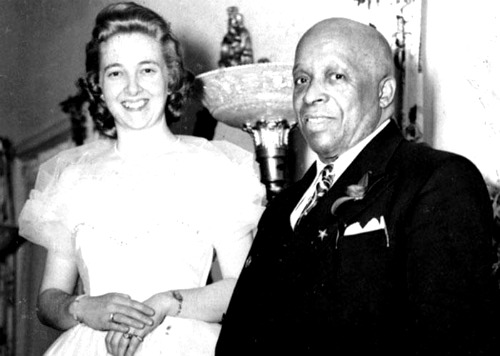
|
| Father and Mother Divine |
The house itself is patterned after Biltmore in Asheville, NC, although perhaps only a quarter as large. Just inside its portecachier, the oak-paneled living room has a ceiling 45 feet high, and many oriental rugs. There is a music room, off to the side of which is Father's former office, bearing a strong resemblance to the Oval Office in the White House in Washington. As planned, the living room window looks down the valley to the site of the old steel mills, although when the trees are leafed out it may be difficult to see. The dining table probably seats forty people, although the paneled dining room was fitted with electronics and used to broadcast sermons to religious adherents across the country. In the living room are testimonies to the many who seemed to rise from the dead, or who had their blinded sight restored, or who were crippled but enabled to walk. The attendants take visitors on tours, but Mother Divine likes to meet them, coming down the sweeping staircase without noticeably showing her age. The greeting of "Peace" replaces the usual "hello" and "goodbye".
At one time, the Religion housed a large number of single women in several hotels, and the invested proceeds of their work as domestics still supports the Religion. The religion frowned on gambling, drinking, smoking, and sex. However, celibacy inevitably leads to a decline of numbers, particularly evident since the death of the founder.
Relocation

|
| Moving Truck |
For many decades, at least since the Second World War, the Northeastern part of the country has been losing population. And business, and wealth. In recent years, New Jersey has been the state with the greatest net loss, and the Governor who is making the greatest fuss about it. Statisticians have raised this observation to the level of proven fact, although lots of people are even moving into New Jersey at the same time. This is a net figure, and it remains debatable what sort of person you would want to gain, hate to lose; so it's hard for politicians to be certain whether New Jersey's demographic shifts are currently a good thing or a bad thing.
Take the prison population, for example. Most people in New Jersey would think it was a good thing if the felons all moved to some other state because it would imply less crime and law enforcement costs. But one of the major recent causes of a decline in violent crime seems to be the universal presence of a portable telephone in everyone's pocket. Just let someone yell, "Stick 'em up!" loud enough, and thirty cell phones are apt to emerge, all dialing 911. On the other hand, cell phones are the universal communication vehicle for sales of illicit drugs and other illegal recreations, and the increase in automobile accidents is a serious business for inattentive drivers. Add to this confusion the data that capital punishment is more expensive for the State than incarceration is, and you start to see the near futility of knowing what is best to have more, or less, of.
What the Governor and his Department of Treasury mostly want to know is whether certain taxes end up producing a good net revenue for the State. That is, whether more revenue is produced by raising certain taxes more than others, or whether some taxes are a big component of the Laffer Curve, causing revenue to be lost by driving business, or business owners, out of state, in spite of the immediate revenue gain. The studies which have been done are fairly conclusive that executives tend to be most outraged by property taxes, since they have a hidden effect on the sale price of the house, and the amount of money available for school improvements. At least at present levels, a Governor is better off taking abuse for raising income or sales taxes, even though the apparent tax revenue might be the same as a rise in property taxes. Since property taxes are mostly set by a local municipal government, while sales and income taxes are usually set by state governments, a decision to raise one sort of tax or another can have unexpected consequences, or require obscure manipulations to accomplish.
Some politicians who believe their voting strength does not lie in the middle class, would normally want to hold up property values, not taxes because the data show that higher home prices drive away from the middle class and in certain circumstances are positively attractive to wealthy ones. Higher prices appeal to home sellers, at least up to a point. Wealthier people who are buying houses are likely to have an old one to sell; that's less true of first-time home buyers or people presently renting. Certain issues can even be reduced to rough formulas: a 1% increase in income tax would cause a 1% loss of population, but a 5% loss of people earning more than $125,000. A $10,000 increase in average home prices, on the other hand, causes a net loss of population, but mostly those with lower income. One important feature of tinkering with average home prices and property taxes is that these effects are "durable" -- they do not fade away over time.

|
| Laffer Curve |
New Jersey is financially a bad state to die in, but the decision to move to Delaware, Florida or Texas is often made over a long period of years in advance of actually doing it. It has been hard to compile statistics relating changes in inheritance tax law to net migration of retirees and to present such dry data in an effective manner to counteract the grumblings that rich people are undeserving of tax relief, or dead people are unable to complain. But rich old folks are very likely to own or control businesses, and if you drive them out of state, you may drive away a considerably larger amount of taxation relating to the business in other ways. This is the underlying complaint of Unions about Jobs, Jobs, Jobs; but state revenue also relates to sales taxes of the business, business taxes, employee taxes, real estate taxes on the business property, etc, etc. Sometimes these effects are more noticeable in the region they affect; the huge population growth of the Lehigh Valley in recent years is mainly composed of former New Jersey suburbanites, who formerly earned their income in New York. The taxes of three different states interact, in places like that.
The audience of a group I recently attended contained a great many people who make a living trying to persuade businesses to move into one of the three Quaker states of the Delaware Valley. The side-bar badinage of these people tended to agree that many of the decisions to relocate a business are based on seemingly capricious thinking. The decision to consider relocation to the Delaware Valley is often prompted by such things as the wife of an executive having gone to school on the Main Line. Following that, the professional persuaders move in with data about tax rates, average home prices, and the ranking of local school quality by analysts. Having compiled a short list of places to consider by this process, it all seemingly comes back to the same capriciousness. The wife of the C.E.O. had a roommate at college who still lives in the area. And she says the Philadelphia Flower Show is the best there is. So, fourteen thousand employees soon get a letter, telling them we are going to move.
And, the poor Governor is left out of the real decision-making entirely, except to the degree he recognizes that home property taxes have the largest provable effect on personal relocation. And lowering the corporate income tax has the biggest demonstrable effect on moving businesses. But the largest un-provable effect is dependent on the comparative level of the state's inheritance tax.
Main Line: Overbrook to Paoli
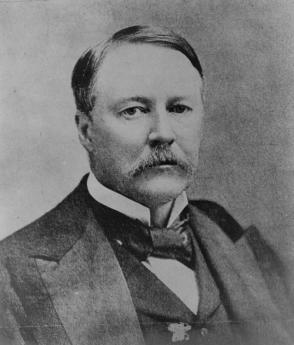
|
| Alexander Cassatt |
Greg Pritchard, who has made scholarship of the Main Line a central part of his life, recently addressed a meeting of the Right Angle Club. To Greg, the Main Line is the set of commuter rail stops from Overbrook to Paoli, representing what was once the heart of the Pennsylvania RR. It changed into a spur of the real main line, running from New York to Chicago, the central monument left by Alexander Cassatt, its president. Times really do change a lot. There is now only one dingy daily passenger train from New York to Harrisburg, which Amtrak would dearly like to eliminate entirely. The Pennsylvania Turnpike was just too much competition, and air travel has eliminated all railroad passenger interest in further points like Pittsburgh, Chicago, and points west. The real main line of long-distance rail on the East Coast now runs north-south, called the Northeast Corridor, essentially beginning in Boston and ending at Washington DC. Philadelphia is central to all of these versions of main lines, although a thirteen-year lawsuit was required to break combined Pennsylvania and New York Central railroads into SEPTA, Amtrak, and Conrail. At the moment, Conrail the freight line is making tons of money, Amtrak the passenger long-haul line would soon die without government subsidy, and all commuter railroads are subsidized by their local communities. There is a lot of talk about billion dollar investments in high-speed trains like they have in Japan and France, but anyone familiar with the economics of rail transportation just shudders at the thought. Railroads are profitable ways to haul long-range bulk cargo. Passenger lines, long and short, can only be justified if they cost less than expanding highway and airline transportation, which the public obviously prefers. Philadelphia is in the peculiar position that the real estate investment has already been made in passenger rail; is it cheaper to build on what already exists, or is that a doomed relic of the past?
But back to Greg's favorite topic, the revered and treasured 19th Century stations on The Main Line. They were mostly built from 1860 to 1890, along the path of what was then the main line to Chicago, but destined to become a spur leading to the real center of east-west traffic, which went from New York to Chicago further north from Philadelphia, intersecting with what became the Philadelphia spur at Paoli. In the days when Philadelphia was one of the richest cities in the world, the spur was a glamorous suburban real estate development. The stations were built, the mansions scattered along at some distance, and servants houses clustered around the stations. The towns were renamed with Welsh names like Bryn Mawr (instead of Humphryville). A culture was built up, probably unique in the world for being centered on railroad executives, and novels like Kitty Foyle and movies like The Philadelphia Story celebrated the glamor of it all. It's probably true that you can find more fifty-room mansions there than just about anywhere else, but the automobile and good public schools mainly drove the prosperity of the 20th Century, as the railroads dwindled away.
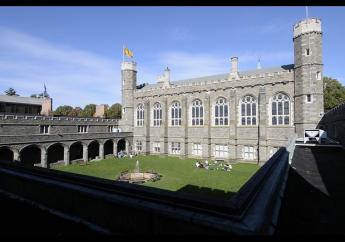
|
| Bryn Mawr College |
The stops on the Main Line begin with Overbrook and continue on through Merion, Narberth, Wynnewood, Ardmore, Haverford, Bryn Mawr, Rosemont, Villanova, Radnor, St. David's, Wayne, Strafford, Devon, Berwin, Daylesford, and Paoli. The main line starts where Philadelphia taxes end and gets progressively newer in harness with the gradual construction of fashionable homes as you get further from the city. At first, Paoli was a place where the out of service trains was stored, but gradually became a fashionable area, which is beginning to leapfrog over the King of Prussia shopping center into the farmlands to the north. The center of gravity of suburban aspirations moves steadily further into the surrounding countryside but is outgrowing the old commuter rail system, and there is something of a movement back to the city. That is to say, urban sprawl is running into the discovery that it's just too traffic-jammed to commute that far, except by train. Most folks are familiar with the jingle that "Old Maids Never Wed And Have Babies" which is supposed to help commuters remember what stop they are approaching. However, the topic mentioned by the jingle and the fact that it ends with Babies (Bryn Mawr) instead of Paoli, strongly implies it was written by a student at Bryn Mawr College for Women.
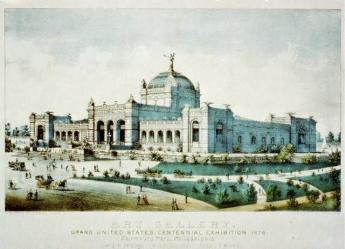
|
| Centennial Exhibition in Fairmount Park |
The old brick stations have been adopted by affectionate commuters, turned into historical preservation societies. They have a varied history, but quite often the station master lived upstairs, and the first floor housed a branch of the post office. When the railroad straightens out its right of way, the stations have to be moved, often at great expense. As they progressed further into the countryside, sometimes grand resort hotels were built for those who wanted to escape the summer heat in the city, or in 1876, to house attendees to the Centennial Exhibition in Fairmount Park. As these hotels lost popularity, they became excellent bargain real estate for a new college, to begin with, a lessened expense, and the upscale neighborhood which soon clustered about the area insisted, that these colleges move up-scale and get good ratings in U.S. News and World Report. Alexander Cassatt insisted that all transcontinental trains must make a stop in Paoli near his home, and there are even a few stations like Upton which were for the sole use of a single estate. So, at one time when ignorant non-Philadelphians on the transcontinental trains would sniff, "Why would the trains all stop out here in the country?", the Philadelphians in the know would just bury themselves in their newspapers.
Footnote: This interesting talk stimulated me to go read some of the history posted in the Main Line station houses, and in particular the one in Narberth. Narberth was a village long before the railroad came along, and it still holds itself a little aloof from the rest. These and similar places relate that Narberth used to be Libertyville, Bryn Mawr used to be Humphrysville, Cynwyd was once Academyville, Marionville became Merion, and Narberth was purchased from William Penn in 1682 by Edward Reese Price. It is also noted that William Thomas donated his property to the PRR in 1851, and the PRR purchased the struggling "Old Columbia" railroad, formerly the "MainLine of Railroads and Canals", from the state in 1857. Narberth quickly became the center of fashionable summer hotels.
Philadelphia's Real Estate Gridlock
IT was spoken hurriedly, and I don't remember who said it. But the gist was that Philadelphia had been the richest city in the world in 1900. In the World, mind you. I can scarcely believe that, but the way it stuck with me shows it had some substance. Rather than comparing Philadelphia with London, New York City, or Paris, I must now compare that exuberance with the dirty, dejected, defeated old wreck of a Philadelphia I first encountered in 1948. Baltimore, Newark and a dozen old American cities sort of crumbled into dust after 1929, but Philadelphia briefly seemed to be picking up in 1948. Richardson Dilworth was getting ready to run for Mayor, and the town's newspapers even enjoyed the idea of a Philadelphia revival. But then the Pennsylvania Railroad collapsed, and after that, we just struggled along, neither dying nor recovering. Some of both, perhaps, but more dying than recovering, and making it credible to believe that Philadelphia just never did recover from the 1929 crash. Just think of that; from top to bottom in thirty years. There just had to be some better explanation than bad management of one railroad.
Until recently, I had accepted the general wisdom that stock market crashes are followed by depressions. Perhaps I am a little slow, but there never seemed to be any question of that analysis, since all major crashes really were followed by recessions, going back to 1792 when Philadelphia had the first American version, and the first financier villain, someone named William Duer. Or maybe it was Robert Morris. Or maybe it was Thomas Mifflin, but in any event, it was someone very rich who did something very reprehensible which toppled the stock market and plunged the rest of us poor victims into protracted suffering. In other scenes of carnage, it had been John Bull, or William Whitney, or Nicholas Biddle. Or J.P. Morgan, that monster. In the 2007 crash, it wasn't so much one villain as one company, Goldman Sachs, or maybe Lehman Brothers. Since the recent crash was so recent, and news coverage so rapid, it might be easier to trace out who the villain was. But there was no one real villain, and even if we found one, it was hard to see why a few days of choked markets would still be causing unemployment seven years later. No one seemed to know, or at least no one wanted to tell me, why stock market crashes cause depressions. They are certainly followed by depressions.
And then suddenly I realized, or maybe someone just broke the news to me, that I had it all backward. Market crashes don't cause depressions, depressions cause market crashes. First, the markets get overheated, everyone gets uneasy, but everyone is making the most money in his life. Suddenly, someone sells out, like shouting "fire" in a crowded theater, and everyone tries to get out the door at the same time. The catastrophe makes everyone see that stocks or real estate, bonds or tulip bulbs, had become ridiculously overpriced, so nobody will buy them at any price. But let's not get down into the weeds of market technicality; prices got disconnected from real values. We overproduced something or even everything, and things wouldn't improve until somebody needed something he had stopped needing, several years earlier. Maybe there were villains, there are always plenty of villains. But we wanted somebody to blame because otherwise, everybody has to take some blame. We needed, in short, a scapegoat.
So let's ask the question again: what caused the great depression of the thirties? And the best answer to come back was the First World War. Philadelphia was the arsenal of democracy, the maker of ships and gunpowder and uniforms. The great transatlantic ocean port, the embarkation point. If we weren't sending troops we were sending tanks and airplanes. The duPonts were sending gunpowder to France, a way of paying back Beaumarchais for sending gunpowder from France to the Battle of Trenton. After their wars were over, one Frenchman went back to making wristwatches and writing plays, and the other munition maker swore off gunpowder and concentrated on nylon stockings. That's far too simple. Philadelphia had expanded and expanded to exploit its wartime advantages. When the war was over the boom was over, but the Roaring Twenties roared. They built mansions, clear out to Paoli and beyond. Movies were written about our hero, who left their jewelry in the vaults of the Girard Bank after the opera while they went back to the horse country at four in the morning. It seems a virtual certainty that no one who acted like that knew what every MBA from Temple now knows: real estate is just about the only link for ordinary people between interest rates and consumption. All assets contribute somewhat to the "Wealth Effect", but real estate is usually the only channel the average person can find, as a way to translate major assets into consumer goods. And since a stock market crash will lower interest rates, the ensuing low cost of mortgages stimulates a real estate boom. Office buildings in the city, mansions in the horse country. But then the city loses its postwar boom and soon loses a million or more population. Result: empty office buildings, empty mansions. Along Spruce and Pine Streets, people moved out of the grand houses and into the servants' houses in the back alleys. Easier to heat.
A friend of mine, whose occupation is locating real estate for businesses, tells me the startling news that land around Philadelphia is too expensive for factories. It seemed hardly credible that real estate could seem so hard to sell, with "For Sale" signs lining the curbs, and yet seem too overpriced for a company to locate here. Suburban Philadelphia house prices were depressed during the Depression so that a seven bedroom Main Line house couldn't find a buyer, but the land was still too expensive for a factory, and anyway, the zoning wouldn't permit a business. Our suburban and exurban land got chopped up into residential real estate, streets were built, sewer lines were extended for miles, trees and ornamentals were planted. Schools and shopping centers were built, maybe some museums and hospitals. But none of that was attractive for a business, and you can't attract an executive to residential real estate without a place to go to work. The features attractive to his wife were not enough to attract him and his business. He wants cheap open land to build factories and vast parking spaces for employees. He doesn't want to get fifty miles away from the port that made Philadelphia prosperous. And he particularly doesn't want to spend his time going to protest meetings about smoke and pollution or go to court to defend his ownership of what someone else polluted, a century earlier. He particularly doesn't want to go to Planned Parenthood meetings with his wife, in order to be hassled about carbon fuels or greenhouse gases in China. Sorry, he's going to build his new plant in North Carolina. And the residential real estate couldn't be made cheap enough for that purpose without tearing down the house, and the schools, and maybe the shopping center. Once the land becomes dedicated, you have to choose: either a nice suburb or a place favorable for a business.
A former President of a Federal Reserve Bank located a thousand miles from Philadelphia was recently here for a conference, and at loose ends for someone to chat with. To my astonishment, he exploded with rage when he contemplated Mr. Obama's refusal to sign permission to build a pipeline from Canada to the Gulf of Mexico. To him, it was obvious that the main thing holding back the American economy was a refusal of American businesses to invest in new plants and equipment. The banks were stuffed with money, but the business refused to borrow it. The Federal Reserve was powerless to stimulate an economy that didn't want to expand, forever pointing to uncertainties of expanding in the face of a regulatory authority which seemed determined to thwart them, to browbeat and humiliate them in front of the TV. It isn't personal, it is serious; because the quarrel is ultimately about important economics. A dollar in 1913 when the Federal Reserve was created, is now worth a penny, and there is every indication of administration eagerness to see the present dollar only worth a penny, far sooner than a century from now. The man speaking was obviously sincere and deeply upset, and what seemed to bother him most was the perception that "the environmentalists" are equally sincere, and thus equally unready to give an inch. The economist regarded the argument of the environmentalists as irrelevant to what was really important, just as surely as the environmentalists were heedless of any legitimacy in the arguments for savaging wildlife. Neither side saw this in terms of the city versus suburbs, or agriculture versus commuters. Neither seemed to acknowledge that a city based on concentric rings had to break the ring pattern in order to maintain a harmonious balance between living well and making a living. That is until the two sides recognize they are talking about the same problem on some level, it will be a dialogue of the deaf, offering no possible resolution except war to the death. It's become a religious conflict, with both sides heedless of things vital to the other side.
They say the main function of real estate brokers is to maintain high prices for property values. But in the long run, if a region isn't prosperous, its residential property will lose value, not gain it.
Barnes Arboretum
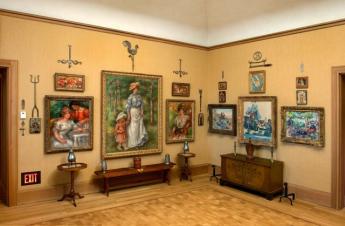
|
| The Barnes Foundation |
If you want to live on City Line Avenue, safely in Montgomery County, you put your entrance on Latches Lane, which is parallel to City Line. It used to be said that the Barnes Foundation was next to Episcopal Academy, but that has moved further West, and St. Joseph's University now owns the property. When St. Joseph's decides what to do with the land, we can possibly describe a better landmark. The Barnes Foundation has always faced away from Philadelphia and is a little hard to find, all of which may have something to do with Dr. Barnes' strong dislike of the City.
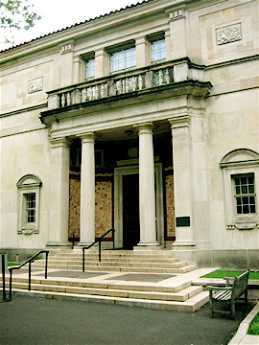
|
| The Barnes Museum |
When you go there now, the old Museum is still there, but already showing signs of neglect. The house the Barnes family lived in is still, right next door. But it's harder to move an Arboretum than a group of paintings, so the Arboretum School, which was Mrs. Barnes' hobby, is still at the same place, likely to stay awhile. It's still a very nice place to visit, especially right at Labor Day when the very large Franklinia Trees are in full bloom. Like all Franklinia trees, these are direct descendants of the only example John Bartram was able to find, in Georgia or anywhere else.

|
| Medicinal Garden |
We're going to have to leave the decision to former Governor Rendell, about what you do with an empty museum since he is said to have had a lot to do with making it that way. We came to see the Arboretum.
The first thing which strikes you is that many of the big old trees are much older than the Barnes Foundation would have been. The brochure helpfully explains that a 19th Century tree fancier started it in 1880, and the Barnes acquired it in 1922. That still wouldn't account for a massive tree which is lying on the ground all cut up, opposite the Medicinal Garden. The base of the tree must be three or more hundred years old, so perhaps there was a grove of old oaks, just over the line of William Penn's city, which every owner tended carefully until the bugs got it. There are a considerable number of Chinese trees that look about right for 1880, but without a guide, it's pretty conjectural.

|
| Japanese Beetle |
Ever since someone imported the Japanese beetle along with some plants, to Moorestown, New Jersey, there have been laws prohibiting the importation of plants from abroad, but there must be some regulatory rigamarole which allows museums to do it. Korea and Japan are at the same latitude as Philadelphia, and the glaciers spared some ancient dinosaur food in those regions, so quite a few strange plants have come here from that source. Since the Barnes is a school, and since it only has a few acres, many if not most of the specimens in the gardens are one or two of a kind. That either means they have a feeder garden somewhere to store backups or a good relationship with government officials. Like all Arboretums, it attracts insects, so be prepared to do some swatting if you go. The school is said to be outstanding and quite conveniently located, but even just a stroll around is quite a nice way to spend a Sunday afternoon.
Pennsylvania's First Industrial Revolution
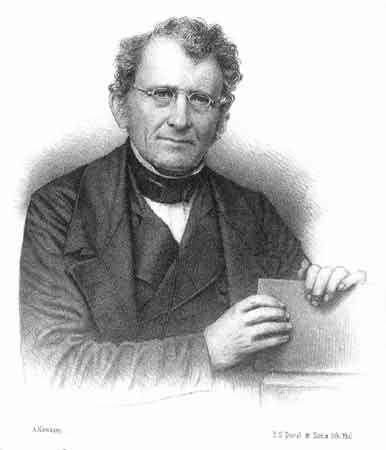
|
| David Thomas |
We tend to think of 1776 as the beginning of American history, but in fact, the region around Easton was settled a hundred-forty years before 1776, and the forests were pretty well lumbered out. The backwoods lumbermen around the junction of the Lehigh and Delaware Rivers were about to move further west when Washington crossed Delaware and fought the battle of Trenton. This region nevertheless had three essential ingredients for becoming the "Arsenal of the Revolution": It was close to the war zone but protected by mountains, it had a network of rivers, and it had coal. The hard coal of Anthracite had the problem it was slow to catch fire, and iron making in the region didn't really get started big-time until a Welsh iron maker named David Thomas discovered that anthracite for iron making would work if the air blast was pre-heated before introducing it into a "blast" furnace. A local iron maker traveled to England to license the patent from Thomas, whereupon Thomas' wife persuaded her husband to move to Pennsylvania. Blast furnaces only got started into production by 1840, but by 1870 there were 55 furnaces along the Lehigh Canal. For thirty years this was America's greatest iron-producing region. In fact, Bethlehem Steel only closed its last plant in 1995.
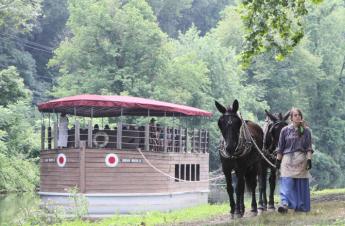
|
| Canal Boat |
When iron-making got started, the local industrial revolution really took off, but the more fundamental step was to dig canals to transport the coal to other regions. Canals were the dominant form of transportation for only thirty years until railroads took over, and the entire Northeast of the nation was laced with canals. Curiously, the South had relatively few canals, so their industrialization was too late for canals, and too early for railroads, to help much in the Civil War. The Erie Canal was the big winner, but Pennsylvania had many networks of canals in competition, leading to the Ohio and Mississippi Rivers, whereas the Erie Canal was more headed toward the Great Lakes and Chicago. Eventually, J.P. Morgan put an end to this race by financing the Pennsylvania Railroad and moving the steel industry to Pittsburgh, where bituminous coal was the fuel of choice. This industrial rivalry was at the heart of the enduring rivalry of Philadelphia and Pittsburgh, as well as the commercial rivalry between New York and Philadelphia. It was more or less the end of the flourishing economy of the "Reach" including Easton, Bethlehem, and Allentown. A reach is a geographic unit sort of bigger than a county, in local parlance. But you might as well include the city of Reading, which concentrated more on railroads and commerce with the Dutch Country. Out of danger from the British Fleet on the ocean, but close enough for war, the "reach" was more or less the forerunner of the Ho Chi Minh Trail in Vietnam in several later wars. The Lehigh Canal stretched from Easton to Mauch Chunk (now Jim Thorpe), the so-called Switzerland of Pennsylvania, only a mile or two West of the Northeast Extension of the Pennsylvania Turnpike.
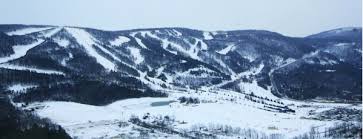
|
| Blue Mountain |
The Allegheny Mountains stretch across the State of Pennsylvania, and the most easterly of these mountains is locally called "Blue" mountain because of its hazy appearance from the East when seen across a lush and prosperous coastal plain. It represents the farthest extent of the several glaciers in the region, and the two sides of it present quite a sociological contrast. The Pennsylvania Dutch found themselves on the richest farming land in the world, whereas the inhabitants of the other side of the mountain had to subsist on pebbles. The mountain levels down at the Delaware River, so the Dutch farmers and the late immigrants from Central Europe mixed, in the time and region of industrial prosperity. Gradually, the miners and the steelworkers began to drift away, but the Pennsylvania Germans tended to remain where they had been before all the fuss. So the Kutztown Fair is full of Seven Sweets and Seven Sours, the farmhouses are large and ample, and mostly remain the way they were, too. You have little trouble finding a twang of Pennsylvania Dutch accents. But Bucks County in Pennsylvania was cut in half by the glacier, and north of the borderline, you can see lots of pickup trucks with gun racks behind the driver. Everything is amicable, you understand, but for some reason, the tax revenues of the two halves of the County are forbidden to be transferred, even within the same county. Better that way.
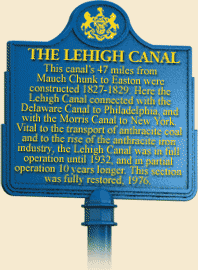
|
| Lehigh Marker |
The Lehigh River runs along the North side of Blue Mountain, and trickles down to join the Delaware at the town of Easton. There were only 11 houses in the town in 1776, and now you can see several miles of formerly elegant early Nineteenth century townhouses. At the point where the two rivers join, a lovely little park has been built to celebrate the high point of Colonial canal-making. Hugh Moore, the founder of the Dixie Cup Company is responsible for this historic memory, well worth a trip to see. If you have called ahead for reservations, you can have a genuine canal boat ride, pulled by two genuine mules. When you hear that the boat captain and his family used to live on the boat (Poppa steered, Momma, cooked, and the children tended the mules), it seems small and cramped. But when you climb aboard, you find it holds a hundred people for dinner with plates in their laps. The food is partly Polish, partly Hungarian and partly other things Central European. And the captain plays guitar and fiddle, singing old songs he mostly composed himself. Surprisingly, no Stephen Foster, who held forth about four hundred miles to the West, until he drank himself to death at Bellevue Hospital in New York. Foster was a member of a rival tribe of canal boaters, the ones who traveled down to Pittsburgh via the Erie Canal. Along the Reach, you hear about three canals, the Lehigh, Delaware, and Morris. The first two are obvious enough since they and the railroads which subsequently followed ran along the banks of two rivers joined. The Morris was Robert Morris, at one time the richest man in America, who bought Morrisville across from Trenton on the speculation he could persuade his friends to put the Nation's Capital there. It didn't work out, so he bought and went broke with the District of Columbia. Anyway, the Morris canal went on to New York harbor, where it prospered mightily shipping iron to New York, and iron for the rolling mills of Boston. The Morris Canal went over the Delaware River on a bridge that carried an aqueduct, over to Philipsburg; and then across the wasp waist of New Jersey.
| Posted by: areyouserious | Aug 5, 2008 1:49 PM |
| Posted by: keeplooken | May 25, 2008 9:10 PM |
61 Blogs
A Woman's Work
 When Haverford admitted women students perhaps it meant to go all-women.
When Haverford admitted women students perhaps it meant to go all-women.
Germantown Avenue, One End to the Other
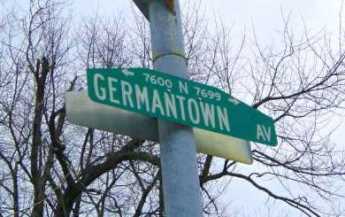
The Barnes Foundation: Comments on the Economics of Art (2)
 Well chosen fine art will appreciate in value over time. If a museum's endowment doesn't grow at the same rate to maintain it, eventually some of the art will have to be sold.
Well chosen fine art will appreciate in value over time. If a museum's endowment doesn't grow at the same rate to maintain it, eventually some of the art will have to be sold.
Harriton House
 The original house in the old Welsh barony gave its name to Bryn Mawr, and once was the home of the secretary of the Continental Congress.
The original house in the old Welsh barony gave its name to Bryn Mawr, and once was the home of the secretary of the Continental Congress.
La Fayette, We Are Here
 LaFayette's first experience in charge of troops very nearly ended in his capture.
LaFayette's first experience in charge of troops very nearly ended in his capture.
Main Line School Night
 There are a lot of continuing education courses, but few are as successful as Main Line School Night, with 14,000 students, hardly any of whom need education.
There are a lot of continuing education courses, but few are as successful as Main Line School Night, with 14,000 students, hardly any of whom need education.
Bertrand Russell Disturbs the Barnes Foundation Neighbors
 How one of Britain's most notorious philosophers wandered into the city of brotherly love and vaulted out of destitution to wealth.
How one of Britain's most notorious philosophers wandered into the city of brotherly love and vaulted out of destitution to wealth.
Mind Your Manners
 The surgeon father of a local congressman once learned a hard lesson.
The surgeon father of a local congressman once learned a hard lesson.
Lawn Tennis at the Cricket Club
 Lawn tennis is slightly older than tennis on clay courts, but it's harder to maintain grass than other surfaces, so it's less common.
Lawn tennis is slightly older than tennis on clay courts, but it's harder to maintain grass than other surfaces, so it's less common.
Potts
 Once you get north of the falls of the Schuylkill in Fairmount Park, there aren't many places to ford the river until you get to Norristown, and then Pottstown. That brought commerce to the towns and a lot of military activity during the Revolution.
Once you get north of the falls of the Schuylkill in Fairmount Park, there aren't many places to ford the river until you get to Norristown, and then Pottstown. That brought commerce to the towns and a lot of military activity during the Revolution.
Radioactive River Bend
 The river geography around Pottstown created a lot of history.
The river geography around Pottstown created a lot of history.
Lansdowne
 John Penn, the last of the Penn Proprietors, lived in a mansion near what is now Horticultural Hall in Fairmount Park.
John Penn, the last of the Penn Proprietors, lived in a mansion near what is now Horticultural Hall in Fairmount Park.
Laundered Money
 A real-life story of counterfeiting and the Secret Service -- and a little old lady doing her laundry.
A real-life story of counterfeiting and the Secret Service -- and a little old lady doing her laundry.
Life On The River (3)
 Until just a few decades ago, Philadelphia life was life along the river, with the gentry building houses upriver from the port. They were surrounded by abundant fishing, hunting, and all the sports of horsemanship.
Until just a few decades ago, Philadelphia life was life along the river, with the gentry building houses upriver from the port. They were surrounded by abundant fishing, hunting, and all the sports of horsemanship.
Litchfield County, Extended (1771-1775)
 Connecticut won the Second Pennamite War, occupying Pennsylvania territory for four years. The American Revolution caused the other colonies to put a stop to the fighting.
Connecticut won the Second Pennamite War, occupying Pennsylvania territory for four years. The American Revolution caused the other colonies to put a stop to the fighting.
Slum Creation and Urban Sprawl
 Suburban sprawl leads to urban home abandonment. Nobody likes the process, but varying factors continue to promote it.
Suburban sprawl leads to urban home abandonment. Nobody likes the process, but varying factors continue to promote it.
Founding Fish

A Few Rooms of Your Own
 The way we live changes what we are.
The way we live changes what we are.
Merging Cities With Their Suburbs
 When middle-sized cities are thriving and growing, they tend to want to annex neighboring districts. Their newspapers are ecstatic about it.
When middle-sized cities are thriving and growing, they tend to want to annex neighboring districts. Their newspapers are ecstatic about it.
Country Auction Modernized
 On Fairgrounds Road, in the Quaker farmlands of Bucks County, efficiency and computerized streamlining are nibbling at the enduring customs of country auctions.
On Fairgrounds Road, in the Quaker farmlands of Bucks County, efficiency and computerized streamlining are nibbling at the enduring customs of country auctions.
SEPTA's Long Term Planning
 SEPTA is slowly making progress, but it's a struggle, every step of the way.
SEPTA is slowly making progress, but it's a struggle, every step of the way.
Willow Grove Park

The Walking Purchase
 Quaker treatment of the Indians had been exemplary before 1737 and has been highly sympathetic ever since then, too. However, James Logan totally destroyed the trust of the Delaware Indians by using hired runners to establish boundaries of the Walking Purchase, north of the Neshaminy Creek.
Quaker treatment of the Indians had been exemplary before 1737 and has been highly sympathetic ever since then, too. However, James Logan totally destroyed the trust of the Delaware Indians by using hired runners to establish boundaries of the Walking Purchase, north of the Neshaminy Creek.
James A. Michener (1907-1997)
 < James A. Michener was a birthright Quaker from Doylestown, Pennsylvania, where he made his home when he wasn't traveling. He wrote 40 books, most notably "South Pacific", but lived a fairly simple smalltown life, meanwhile giving over $100 million to charity.
< James A. Michener was a birthright Quaker from Doylestown, Pennsylvania, where he made his home when he wasn't traveling. He wrote 40 books, most notably "South Pacific", but lived a fairly simple smalltown life, meanwhile giving over $100 million to charity.
Doylestown
 Doylestown is trapped between the steadily advancing edges of New York and Philadelphia, and must soon submerge. For now, the town's a lovely little jewel.
Doylestown is trapped between the steadily advancing edges of New York and Philadelphia, and must soon submerge. For now, the town's a lovely little jewel.
Broad Street North and South
 Broad Street in Philadelphia stretches due north from the old Nary Yard on the Delaware River, past City Hall in the center of town, to the northern edge of the city at Elkins Park. Further North of the City Route 611 continues straight on through Doylestown to Easton, where it rejoins the Delaware River.
Broad Street in Philadelphia stretches due north from the old Nary Yard on the Delaware River, past City Hall in the center of town, to the northern edge of the city at Elkins Park. Further North of the City Route 611 continues straight on through Doylestown to Easton, where it rejoins the Delaware River.
Pennsbury Manor
 The Delaware River takes an abrupt right turn at Trenton, creating extensive wetlands for miles around. Whatever its environmental drawbacks, the river delta is moving toward landfill and "development". Come back in fifteen years and be amazed.
The Delaware River takes an abrupt right turn at Trenton, creating extensive wetlands for miles around. Whatever its environmental drawbacks, the river delta is moving toward landfill and "development". Come back in fifteen years and be amazed.
Lambertville and Lewis Island
 As Philadelphia and New York City gradually expand until they meet, they could meet at Lambertville.
As Philadelphia and New York City gradually expand until they meet, they could meet at Lambertville.
Helis the Whale
 In the spring of 2005, a solitary Male Beluga whale made his way up the Delaware River, causing great excitement. He hung around for a week or so, presumably searching for shad.
In the spring of 2005, a solitary Male Beluga whale made his way up the Delaware River, causing great excitement. He hung around for a week or so, presumably searching for shad.
Bristol, PA
 Bristol is at a narrow point of the river, long the main crossing point for New York-to-Philadelphia traffic. William Penn placed his mansion nearby and for decades Bristol was a flourishing social center. The Pennsylvania Railroad cut it off, just as it cut off New Castle, Delaware, and both towns are now essentially museums.
Bristol is at a narrow point of the river, long the main crossing point for New York-to-Philadelphia traffic. William Penn placed his mansion nearby and for decades Bristol was a flourishing social center. The Pennsylvania Railroad cut it off, just as it cut off New Castle, Delaware, and both towns are now essentially museums.
Washington Lurks in Bucks County, Waiting for Howe to Make a Move
 Washington, LaFayette, and twenty-seven other famous heroes of the Revolution spent a week in this Bucks County farmhouse, waiting for the British to make a move. Washington had a bottle of Madeira every day for lunch, but Mrs. Moland made him sleep on the floor, and pay for cleaning up when they left.
Washington, LaFayette, and twenty-seven other famous heroes of the Revolution spent a week in this Bucks County farmhouse, waiting for the British to make a move. Washington had a bottle of Madeira every day for lunch, but Mrs. Moland made him sleep on the floor, and pay for cleaning up when they left.
George Washington Defends Philadelphia in New Jersey
 On a chessboard of geography, the generals must deploy their armies, and anticipate what the other army might do.
On a chessboard of geography, the generals must deploy their armies, and anticipate what the other army might do.
Howe's Choice: To Philadelphia, or Saratoga?
 The Howe brothers may have been socialites, and they had formerly been members of the Parliamentary party favorable to peace in the colonies. But they were also seasoned, smart soldiers who played hard and played to win. Washington proved to be their match, but he did have to prove it.
The Howe brothers may have been socialites, and they had formerly been members of the Parliamentary party favorable to peace in the colonies. But they were also seasoned, smart soldiers who played hard and played to win. Washington proved to be their match, but he did have to prove it.
Tales of the Troop
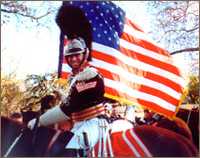 Dennis Boylan is collecting stories from the archives of Philadelphia's First City Troop. Someday, it should result in a great book.
Dennis Boylan is collecting stories from the archives of Philadelphia's First City Troop. Someday, it should result in a great book.
Camden NJ: The Third, or Irish, Tenth
 Early settlers of the Delaware Bay, generally picked the eastern, now New Jersey, side of the river because the terrain was easier to farm. In time, the vast wilderness on the western, or Pennsylvania, side led to more commerce.
Early settlers of the Delaware Bay, generally picked the eastern, now New Jersey, side of the river because the terrain was easier to farm. In time, the vast wilderness on the western, or Pennsylvania, side led to more commerce.
Philadelphia City-County Consolidation of 1854
 Prior to 1854, Philadelphia City was one of twenty-nine political entities within Philadelphia County. After that, it became one big city without suburbs. Growth pressure now reverses toward suburbs without a city. Political boundaries should thus shift inwardly.
Prior to 1854, Philadelphia City was one of twenty-nine political entities within Philadelphia County. After that, it became one big city without suburbs. Growth pressure now reverses toward suburbs without a city. Political boundaries should thus shift inwardly.
The Wyoming Massacre of July 3, 1778
 As the dominant Indian Tribe in Eastern America, the Iroquois were ruthless in war. Whether egged on by the British or for their own reasons, in 1778 they remorselessly wiped out the Connecticut settlers around Wilkes-Barre.
As the dominant Indian Tribe in Eastern America, the Iroquois were ruthless in war. Whether egged on by the British or for their own reasons, in 1778 they remorselessly wiped out the Connecticut settlers around Wilkes-Barre.
Houses of the Penn Family
 Some idea of the social position of William Penn can be gathered from the houses of his family.
Some idea of the social position of William Penn can be gathered from the houses of his family.
Harvard Men Suggest a Cold Place for Yale
 The northeast corner of Pennsylvania was once covered by a glacier.
The northeast corner of Pennsylvania was once covered by a glacier.
Disorderly Retreat: From Trenton Back to Perth Amboy
 At the Battle of Trenton, George Washington established his military reputation for all time.
At the Battle of Trenton, George Washington established his military reputation for all time.
Edward Hicks: Peaceable Kingdoms
 This uneducated Bucks County farm boy has steadily risen in reputation as a painter of primitive art, just as he and his cousin have become spiritual leaders of non-dogmatic religious thought.
This uneducated Bucks County farm boy has steadily risen in reputation as a painter of primitive art, just as he and his cousin have become spiritual leaders of non-dogmatic religious thought.
Greenhouses
 A greenhouse is a greenhouse, until you know something about them.
A greenhouse is a greenhouse, until you know something about them.
Henry Mercer's Rathskeller

Quilts, Patchwork Style
 Although quilting can be found in the tombs of ancient Egypt, American farm women are correct that they invented an art form.
Although quilting can be found in the tombs of ancient Egypt, American farm women are correct that they invented an art form.
Gettysburg
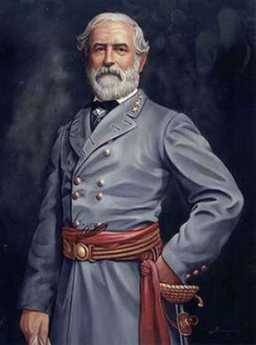 The strategy of both sides in the Battle of Gettysburg was shaped by the type of weapons in use.
The strategy of both sides in the Battle of Gettysburg was shaped by the type of weapons in use.
Albert C. Barnes, M.D.
 Impressionist paintings grew more valuable, faster than the patron's endowment for their maintenance.
Impressionist paintings grew more valuable, faster than the patron's endowment for their maintenance.
Bring Your Own Hammer
 Pennsylvania has 120 State Parks, but this is a Bucks County Park. The exposed bedrock is in an eight-acre park of great big boulders, a few of which chime when you strike them. The rest just give out a clunking noise.
Pennsylvania has 120 State Parks, but this is a Bucks County Park. The exposed bedrock is in an eight-acre park of great big boulders, a few of which chime when you strike them. The rest just give out a clunking noise.
Using the Delaware River as a Weapon
Washington invented modern guerrilla warfare. One important element was to have boats when the enemy was boatless. At the Battle of Trenton, he crossed and recrossed Delaware, leaving his enemy stranded on the other side.
Bi-state Fishing
 When Quakers lined both shores of a river, even a state boundary couldn't interfere with fishing.
When Quakers lined both shores of a river, even a state boundary couldn't interfere with fishing.
Secret Service Visits Burlington Bristol Bridge
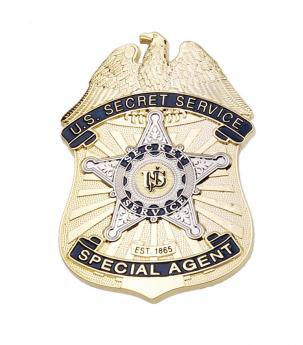 It's surprising what sometimes goes on, around here.
It's surprising what sometimes goes on, around here.
Rebel Hill
 Everybody knows Washington's troops retreated to Valley Forge, but not everybody realizes how he got there.
Everybody knows Washington's troops retreated to Valley Forge, but not everybody realizes how he got there.
Main Line Oligarchy
 Apparently, the Main Line offended John Gunther.
Apparently, the Main Line offended John Gunther.
Governor Keith's House

Mennonites: The Pennsylvania Swiss
 Mennonite Pennsylvania Dutchmen actually came here from Switzerland. The book of their religious martyrs is more than a foot thick since they practice non-resistance, a belief significantly more pacifist than non-violence. Nevertheless, they prosper abundantly in Montgomery County.
Mennonite Pennsylvania Dutchmen actually came here from Switzerland. The book of their religious martyrs is more than a foot thick since they practice non-resistance, a belief significantly more pacifist than non-violence. Nevertheless, they prosper abundantly in Montgomery County.
History of the Mennonites
Although an occasional member is irked by the world's neglect of his church and speaks out in annoyance, the Mennonites, in general, prefer to do good, unnoticed.
Heavenly House
 In or around Philadelphia, money no object, what's the best place to build a super-mansion?
In or around Philadelphia, money no object, what's the best place to build a super-mansion?
Relocation
 Moving your place of residence has many influences, but property taxes seem to have the biggest influence on business executives decided to move. By contrast, property prices have the biggest influence on the middle class.
Moving your place of residence has many influences, but property taxes seem to have the biggest influence on business executives decided to move. By contrast, property prices have the biggest influence on the middle class.
Main Line: Overbrook to Paoli
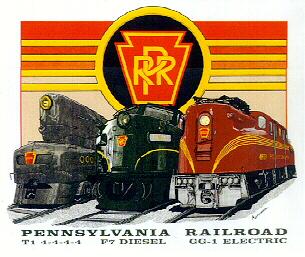 The Main Line was a spur of the Pennsylvania Railroad, connecting Philadelphia to what was the real main line, running north of Philadelphia from New York to Pittsburgh. Times change, the Main Line is a commuter railroad, and there is only one passenger train daily to Pittsburgh. Meanwhile, the real main line is called the Northeast Corridor, Boston to Washington DC.
The Main Line was a spur of the Pennsylvania Railroad, connecting Philadelphia to what was the real main line, running north of Philadelphia from New York to Pittsburgh. Times change, the Main Line is a commuter railroad, and there is only one passenger train daily to Pittsburgh. Meanwhile, the real main line is called the Northeast Corridor, Boston to Washington DC.
Philadelphia's Real Estate Gridlock
Earlier economic disasters may explain what is holding Philadelphia from recovery.
Barnes Arboretum
 The Barnes impressionistic art has moved to the Parkway in Philadelphia, where Dr. Barnes said he never wanted it to be, But the Arboretum remains on Latches Lane in Merion, just across City Line Avenue, next to where Episcopal Academy used to be, and now is occupied by St. Joseph's.
The Barnes impressionistic art has moved to the Parkway in Philadelphia, where Dr. Barnes said he never wanted it to be, But the Arboretum remains on Latches Lane in Merion, just across City Line Avenue, next to where Episcopal Academy used to be, and now is occupied by St. Joseph's.
Pennsylvania's First Industrial Revolution
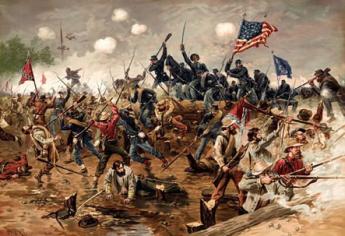 By 1776, a hundred forty years of lumbering had just about exhausted the forests on upper Delaware and Lehigh Rivers. The Revolutionary War then created a use for munitions and iron products in a region which discovered it was on top of Anthracite and connected to the fighting by a network of rivers.
By 1776, a hundred forty years of lumbering had just about exhausted the forests on upper Delaware and Lehigh Rivers. The Revolutionary War then created a use for munitions and iron products in a region which discovered it was on top of Anthracite and connected to the fighting by a network of rivers.